Quick filters:
Theodosius i Stock Photos and Images
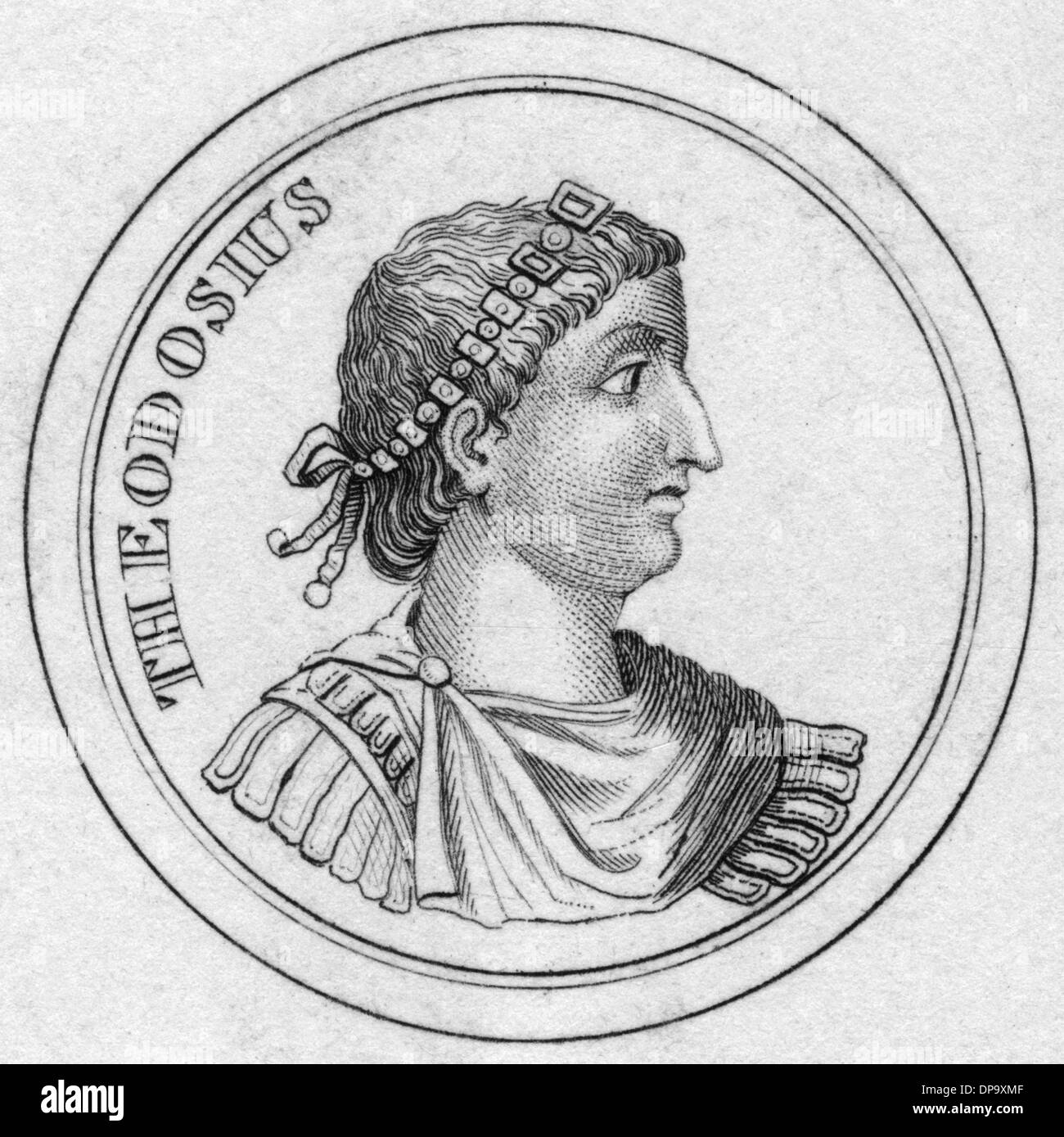 Emperor Theodosius I Stock Photohttps://www.alamy.com/image-license-details/?v=1https://www.alamy.com/emperor-theodosius-i-image65372063.html
Emperor Theodosius I Stock Photohttps://www.alamy.com/image-license-details/?v=1https://www.alamy.com/emperor-theodosius-i-image65372063.htmlRMDP9XMF–Emperor Theodosius I
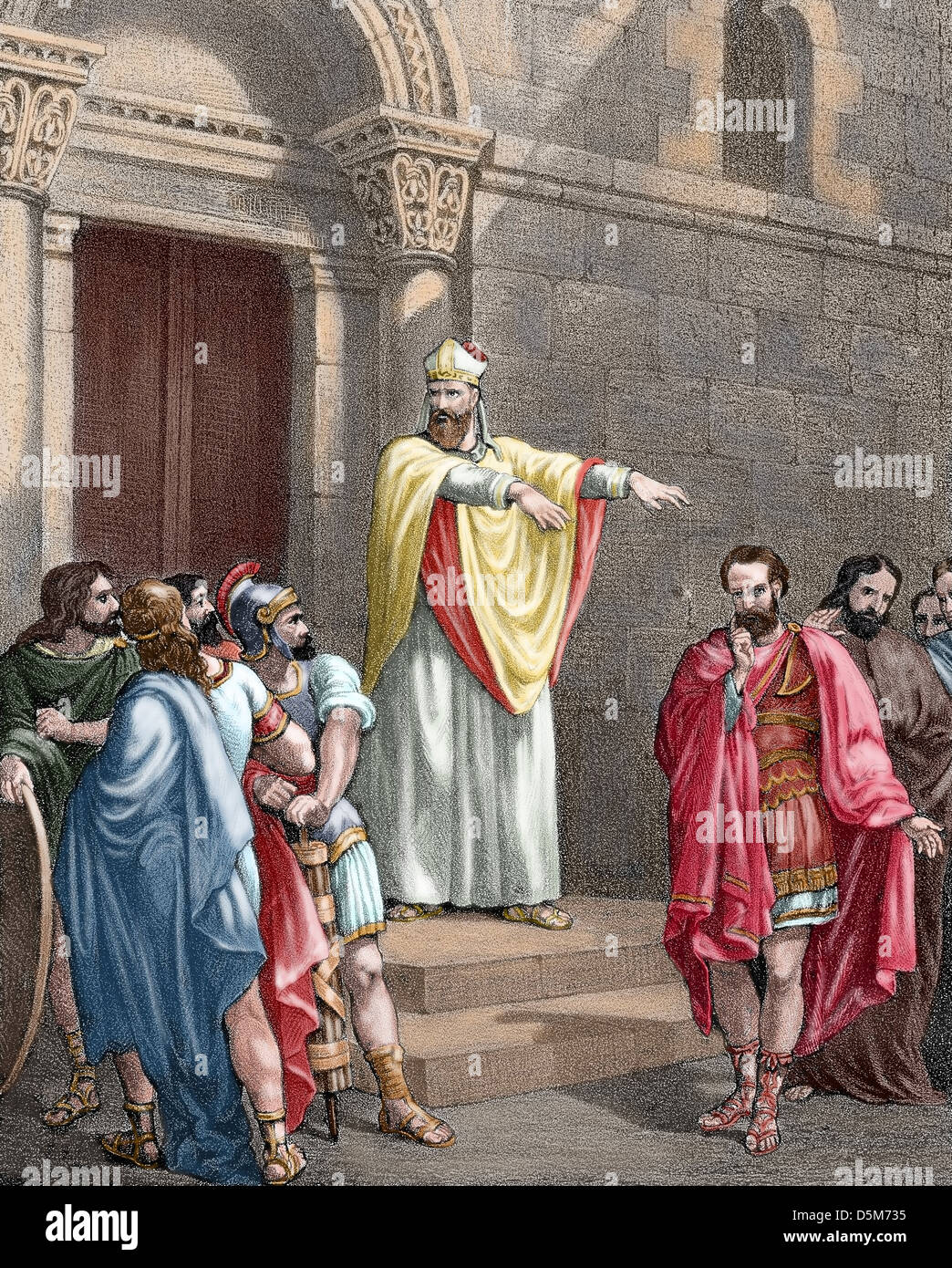 Saint Ambrose (c. 340-397) excommunicating the Roman Emperor Theodosius I (347-395). Colored engraving. Stock Photohttps://www.alamy.com/image-license-details/?v=1https://www.alamy.com/stock-photo-saint-ambrose-c-340-397-excommunicating-the-roman-emperor-theodosius-55149001.html
Saint Ambrose (c. 340-397) excommunicating the Roman Emperor Theodosius I (347-395). Colored engraving. Stock Photohttps://www.alamy.com/image-license-details/?v=1https://www.alamy.com/stock-photo-saint-ambrose-c-340-397-excommunicating-the-roman-emperor-theodosius-55149001.htmlRMD5M735–Saint Ambrose (c. 340-397) excommunicating the Roman Emperor Theodosius I (347-395). Colored engraving.
 Solidus of Theodosius I the Great , 383-388. Byzantium, Constantinople, Byzantine period, 4th century. Gold; diameter: 2.1 cm (13/16 in Stock Photohttps://www.alamy.com/image-license-details/?v=1https://www.alamy.com/solidus-of-theodosius-i-the-great-383-388-byzantium-constantinople-byzantine-period-4th-century-gold-diameter-21-cm-1316-in-image240446398.html
Solidus of Theodosius I the Great , 383-388. Byzantium, Constantinople, Byzantine period, 4th century. Gold; diameter: 2.1 cm (13/16 in Stock Photohttps://www.alamy.com/image-license-details/?v=1https://www.alamy.com/solidus-of-theodosius-i-the-great-383-388-byzantium-constantinople-byzantine-period-4th-century-gold-diameter-21-cm-1316-in-image240446398.htmlRMRY57RA–Solidus of Theodosius I the Great , 383-388. Byzantium, Constantinople, Byzantine period, 4th century. Gold; diameter: 2.1 cm (13/16 in
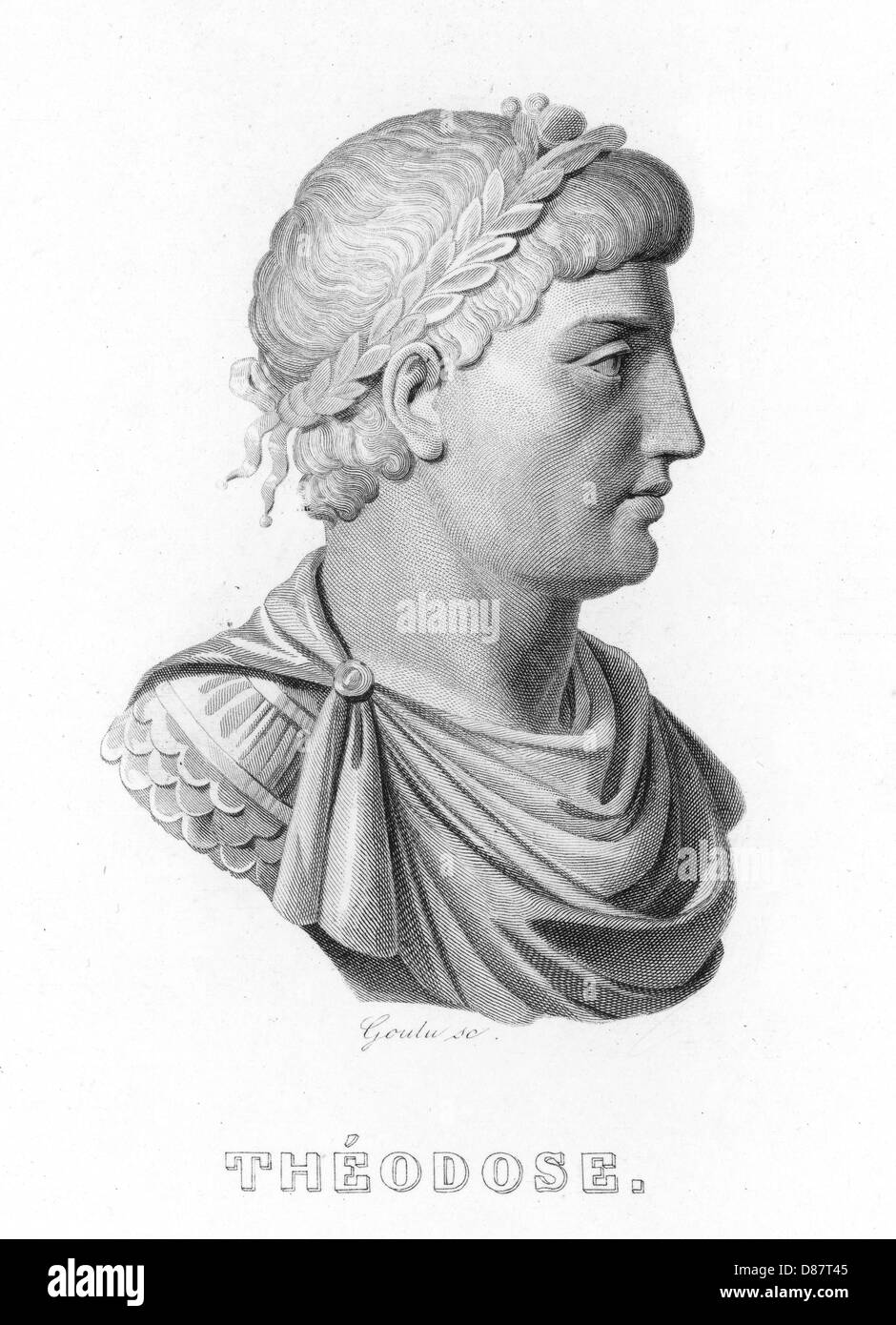 Theodosius I Bust Stock Photohttps://www.alamy.com/image-license-details/?v=1https://www.alamy.com/stock-photo-theodosius-i-bust-56720949.html
Theodosius I Bust Stock Photohttps://www.alamy.com/image-license-details/?v=1https://www.alamy.com/stock-photo-theodosius-i-bust-56720949.htmlRMD87T45–Theodosius I Bust
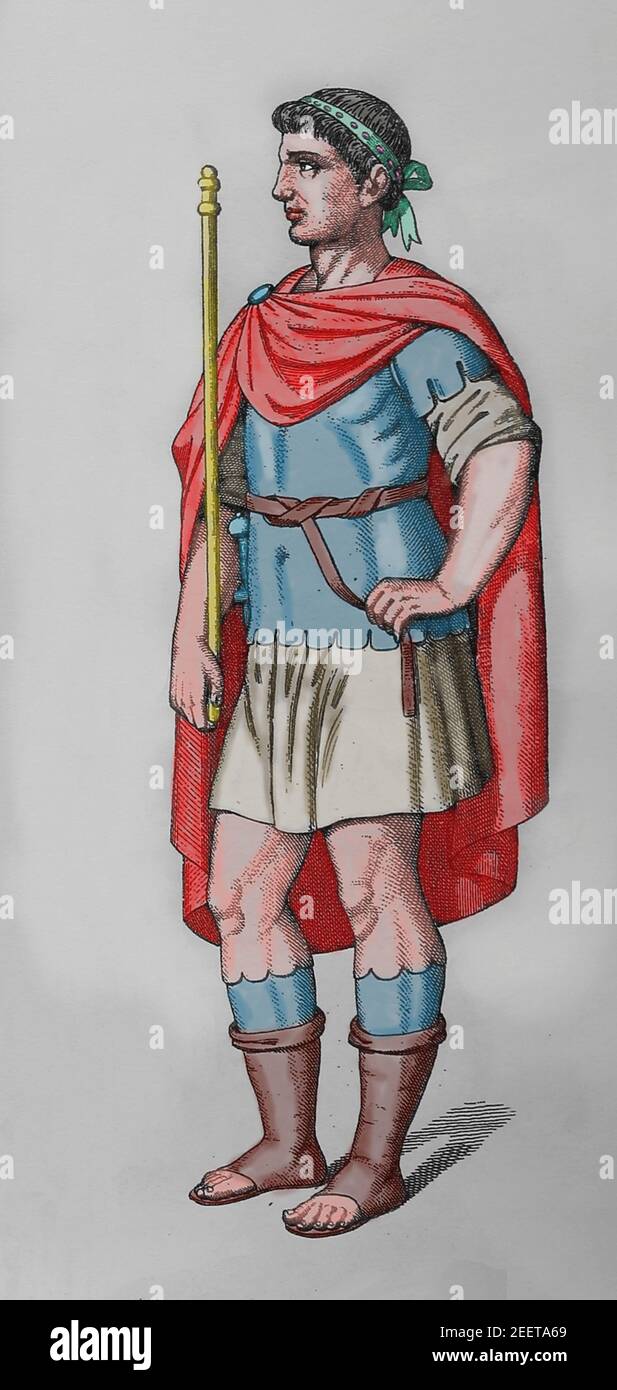 Theodosius I (347-395). Roman emperor form 379-395. Stock Photohttps://www.alamy.com/image-license-details/?v=1https://www.alamy.com/theodosius-i-347-395-roman-emperor-form-379-395-image404978513.html
Theodosius I (347-395). Roman emperor form 379-395. Stock Photohttps://www.alamy.com/image-license-details/?v=1https://www.alamy.com/theodosius-i-347-395-roman-emperor-form-379-395-image404978513.htmlRM2EETA69–Theodosius I (347-395). Roman emperor form 379-395.
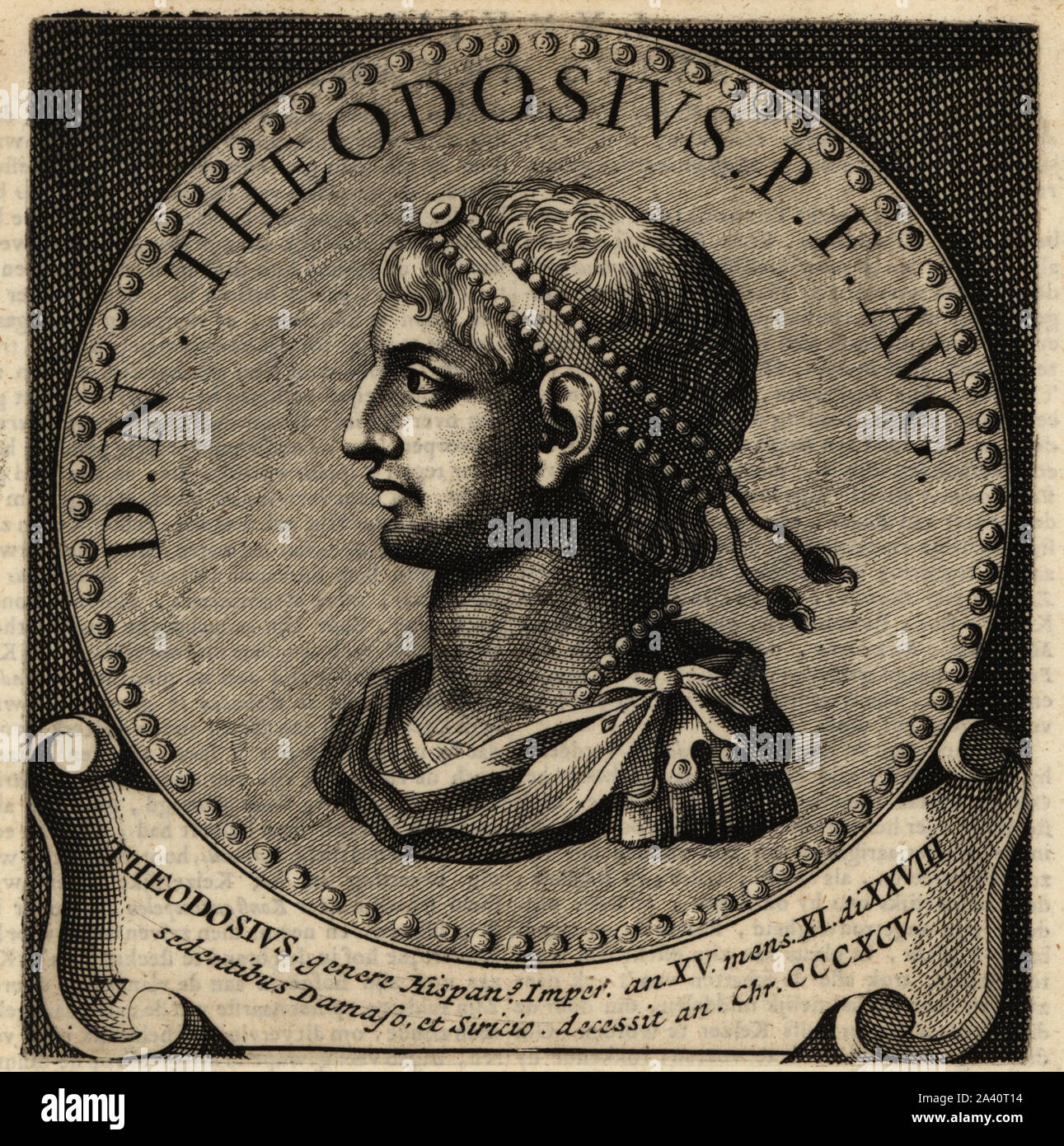 Roman Emperor Theodosius I, 347-395. Flavius Theodosius Augustus or Theodosius the Great, Byzantine Emperor. Copperplate engraving from Abraham Bogaert’s De Roomsche Monarchy, The Roman Monarchy, Francois Salma, Utrecht, 1697. Stock Photohttps://www.alamy.com/image-license-details/?v=1https://www.alamy.com/roman-emperor-theodosius-i-347-395-flavius-theodosius-augustus-or-theodosius-the-great-byzantine-emperor-copperplate-engraving-from-abraham-bogaerts-de-roomsche-monarchy-the-roman-monarchy-francois-salma-utrecht-1697-image329474464.html
Roman Emperor Theodosius I, 347-395. Flavius Theodosius Augustus or Theodosius the Great, Byzantine Emperor. Copperplate engraving from Abraham Bogaert’s De Roomsche Monarchy, The Roman Monarchy, Francois Salma, Utrecht, 1697. Stock Photohttps://www.alamy.com/image-license-details/?v=1https://www.alamy.com/roman-emperor-theodosius-i-347-395-flavius-theodosius-augustus-or-theodosius-the-great-byzantine-emperor-copperplate-engraving-from-abraham-bogaerts-de-roomsche-monarchy-the-roman-monarchy-francois-salma-utrecht-1697-image329474464.htmlRM2A40T14–Roman Emperor Theodosius I, 347-395. Flavius Theodosius Augustus or Theodosius the Great, Byzantine Emperor. Copperplate engraving from Abraham Bogaert’s De Roomsche Monarchy, The Roman Monarchy, Francois Salma, Utrecht, 1697.
 Saint Ambrose and Emperor Theodosius I. Stock Photohttps://www.alamy.com/image-license-details/?v=1https://www.alamy.com/saint-ambrose-and-emperor-theodosius-i-image186174097.html
Saint Ambrose and Emperor Theodosius I. Stock Photohttps://www.alamy.com/image-license-details/?v=1https://www.alamy.com/saint-ambrose-and-emperor-theodosius-i-image186174097.htmlRMMPTXXW–Saint Ambrose and Emperor Theodosius I.
 Obelisk of Theodosius. Erected in the Hippodrome of Constantinople (now Istanbul) by Roman emperor Theodosius I. 4th Century. Relief at the pedestal: Theodosius I with his family and the submission of the barbarians (west face). Turkey. Stock Photohttps://www.alamy.com/image-license-details/?v=1https://www.alamy.com/stock-photo-obelisk-of-theodosius-erected-in-the-hippodrome-of-constantinople-83509156.html
Obelisk of Theodosius. Erected in the Hippodrome of Constantinople (now Istanbul) by Roman emperor Theodosius I. 4th Century. Relief at the pedestal: Theodosius I with his family and the submission of the barbarians (west face). Turkey. Stock Photohttps://www.alamy.com/image-license-details/?v=1https://www.alamy.com/stock-photo-obelisk-of-theodosius-erected-in-the-hippodrome-of-constantinople-83509156.htmlRMERT4NT–Obelisk of Theodosius. Erected in the Hippodrome of Constantinople (now Istanbul) by Roman emperor Theodosius I. 4th Century. Relief at the pedestal: Theodosius I with his family and the submission of the barbarians (west face). Turkey.
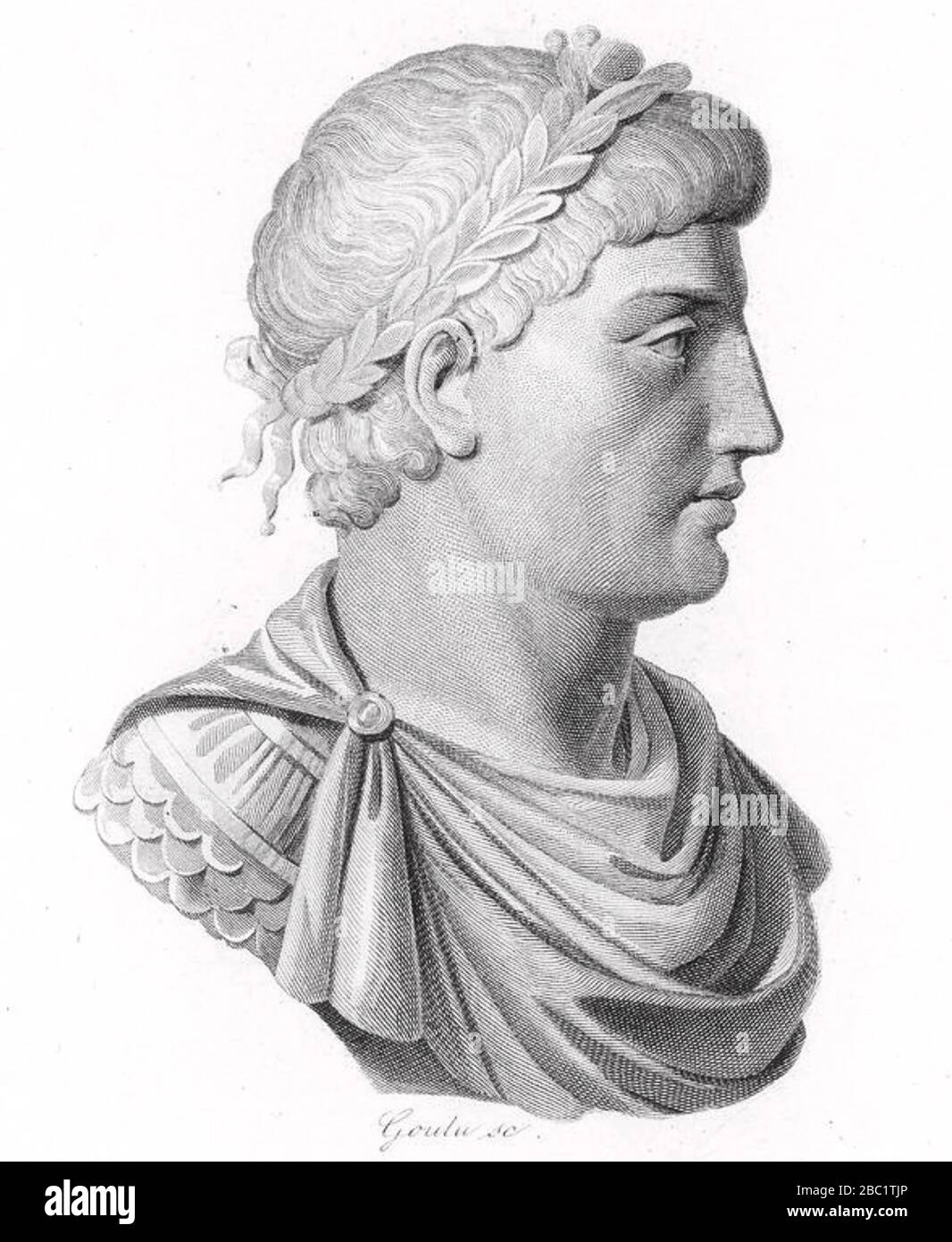 THEODOSIUS I (347-395) Roman emperor Stock Photohttps://www.alamy.com/image-license-details/?v=1https://www.alamy.com/theodosius-i-347-395-roman-emperor-image351624526.html
THEODOSIUS I (347-395) Roman emperor Stock Photohttps://www.alamy.com/image-license-details/?v=1https://www.alamy.com/theodosius-i-347-395-roman-emperor-image351624526.htmlRM2BC1TJP–THEODOSIUS I (347-395) Roman emperor
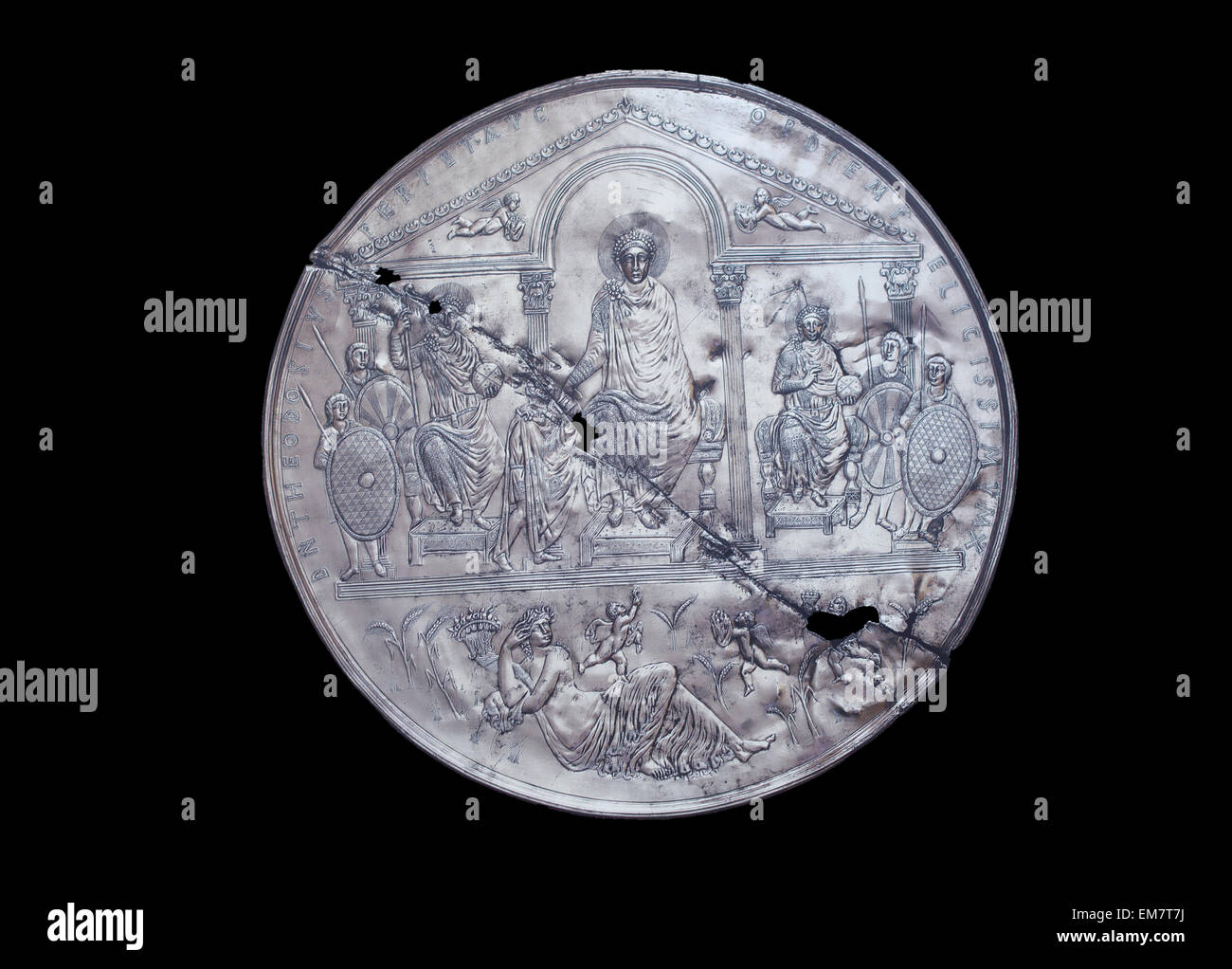 The Missorium of Theodosius I is a large ceremonial silver dish. It was made in Constantinople for the tenth anniversary (decenn Stock Photohttps://www.alamy.com/image-license-details/?v=1https://www.alamy.com/stock-photo-the-missorium-of-theodosius-i-is-a-large-ceremonial-silver-dish-it-81307286.html
The Missorium of Theodosius I is a large ceremonial silver dish. It was made in Constantinople for the tenth anniversary (decenn Stock Photohttps://www.alamy.com/image-license-details/?v=1https://www.alamy.com/stock-photo-the-missorium-of-theodosius-i-is-a-large-ceremonial-silver-dish-it-81307286.htmlRFEM7T7J–The Missorium of Theodosius I is a large ceremonial silver dish. It was made in Constantinople for the tenth anniversary (decenn
 Theodosius I (347-395), also known as Theodosius the Great, was born into a military family in Hispania. He served with his father until his execution in 374, after which Theodosius retired to Hispania until he was given the position of co-emperor by Emperor Gratian after Emperor Valens' death in 378. Theodosius ruled the East Roman Empire, and after Gratian himself was killed in 383, appointed his son Arcadius as his co-ruler in the east while briefly acknowledging the usurper Magnus Maximus before agreeing to a marriage with Emperor Valentinian II's sister Galla and defeating Maximus in bat Stock Photohttps://www.alamy.com/image-license-details/?v=1https://www.alamy.com/theodosius-i-347-395-also-known-as-theodosius-the-great-was-born-into-a-military-family-in-hispania-he-served-with-his-father-until-his-execution-in-374-after-which-theodosius-retired-to-hispania-until-he-was-given-the-position-of-co-emperor-by-emperor-gratian-after-emperor-valens-death-in-378-theodosius-ruled-the-east-roman-empire-and-after-gratian-himself-was-killed-in-383-appointed-his-son-arcadius-as-his-co-ruler-in-the-east-while-briefly-acknowledging-the-usurper-magnus-maximus-before-agreeing-to-a-marriage-with-emperor-valentinian-iis-sister-galla-and-defeating-maximus-in-bat-image344280358.html
Theodosius I (347-395), also known as Theodosius the Great, was born into a military family in Hispania. He served with his father until his execution in 374, after which Theodosius retired to Hispania until he was given the position of co-emperor by Emperor Gratian after Emperor Valens' death in 378. Theodosius ruled the East Roman Empire, and after Gratian himself was killed in 383, appointed his son Arcadius as his co-ruler in the east while briefly acknowledging the usurper Magnus Maximus before agreeing to a marriage with Emperor Valentinian II's sister Galla and defeating Maximus in bat Stock Photohttps://www.alamy.com/image-license-details/?v=1https://www.alamy.com/theodosius-i-347-395-also-known-as-theodosius-the-great-was-born-into-a-military-family-in-hispania-he-served-with-his-father-until-his-execution-in-374-after-which-theodosius-retired-to-hispania-until-he-was-given-the-position-of-co-emperor-by-emperor-gratian-after-emperor-valens-death-in-378-theodosius-ruled-the-east-roman-empire-and-after-gratian-himself-was-killed-in-383-appointed-his-son-arcadius-as-his-co-ruler-in-the-east-while-briefly-acknowledging-the-usurper-magnus-maximus-before-agreeing-to-a-marriage-with-emperor-valentinian-iis-sister-galla-and-defeating-maximus-in-bat-image344280358.htmlRM2B03932–Theodosius I (347-395), also known as Theodosius the Great, was born into a military family in Hispania. He served with his father until his execution in 374, after which Theodosius retired to Hispania until he was given the position of co-emperor by Emperor Gratian after Emperor Valens' death in 378. Theodosius ruled the East Roman Empire, and after Gratian himself was killed in 383, appointed his son Arcadius as his co-ruler in the east while briefly acknowledging the usurper Magnus Maximus before agreeing to a marriage with Emperor Valentinian II's sister Galla and defeating Maximus in bat
 Coca is birthplace of Roman Emperor Theodosius I. Coca, Segovia, Castilla y León, Spain, Europe Stock Photohttps://www.alamy.com/image-license-details/?v=1https://www.alamy.com/stock-photo-coca-is-birthplace-of-roman-emperor-theodosius-i-coca-segovia-castilla-126509988.html
Coca is birthplace of Roman Emperor Theodosius I. Coca, Segovia, Castilla y León, Spain, Europe Stock Photohttps://www.alamy.com/image-license-details/?v=1https://www.alamy.com/stock-photo-coca-is-birthplace-of-roman-emperor-theodosius-i-coca-segovia-castilla-126509988.htmlRMH9R0NT–Coca is birthplace of Roman Emperor Theodosius I. Coca, Segovia, Castilla y León, Spain, Europe
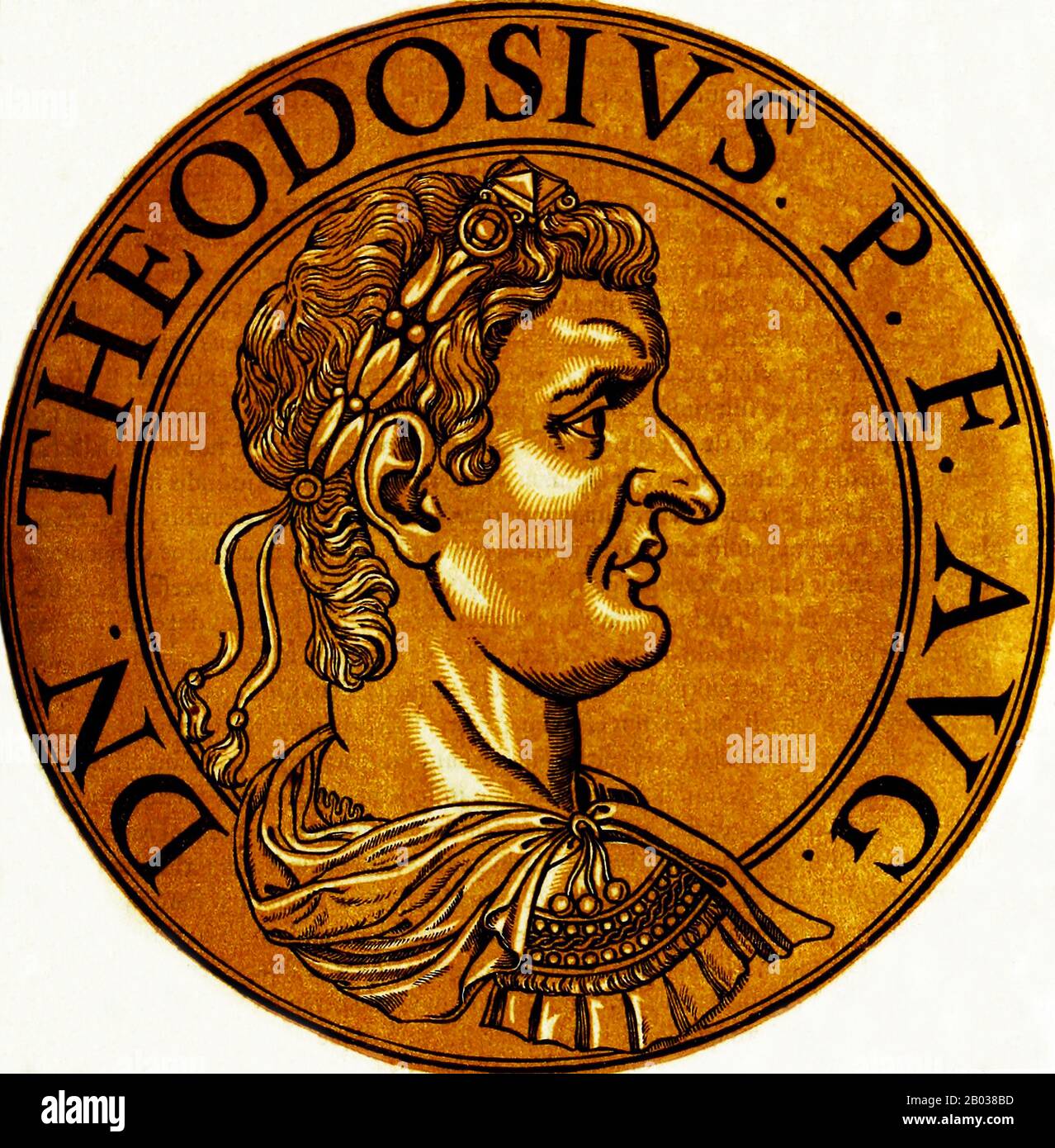 Theodosius I (347-395), also known as Theodosius the Great, was born into a military family in Hispania. He served with his father until his execution in 374 CE, after which Theodosius retired to Hispania until he was given the position of co-emperor by Emperor Gratian after Emperor Valens' death in 378 CE. Theodosius ruled the East Roman Empire, and after Gratian himself was killed in 383 CE, appointed his son Arcadius as his co-ruler in the east while briefly acknowledging the usurper Magnus Maximus before agreeing to a marriage with Emperor Valentinian II's sister Galla and defeating Maxim Stock Photohttps://www.alamy.com/image-license-details/?v=1https://www.alamy.com/theodosius-i-347-395-also-known-as-theodosius-the-great-was-born-into-a-military-family-in-hispania-he-served-with-his-father-until-his-execution-in-374-ce-after-which-theodosius-retired-to-hispania-until-he-was-given-the-position-of-co-emperor-by-emperor-gratian-after-emperor-valens-death-in-378-ce-theodosius-ruled-the-east-roman-empire-and-after-gratian-himself-was-killed-in-383-ce-appointed-his-son-arcadius-as-his-co-ruler-in-the-east-while-briefly-acknowledging-the-usurper-magnus-maximus-before-agreeing-to-a-marriage-with-emperor-valentinian-iis-sister-galla-and-defeating-maxim-image344279809.html
Theodosius I (347-395), also known as Theodosius the Great, was born into a military family in Hispania. He served with his father until his execution in 374 CE, after which Theodosius retired to Hispania until he was given the position of co-emperor by Emperor Gratian after Emperor Valens' death in 378 CE. Theodosius ruled the East Roman Empire, and after Gratian himself was killed in 383 CE, appointed his son Arcadius as his co-ruler in the east while briefly acknowledging the usurper Magnus Maximus before agreeing to a marriage with Emperor Valentinian II's sister Galla and defeating Maxim Stock Photohttps://www.alamy.com/image-license-details/?v=1https://www.alamy.com/theodosius-i-347-395-also-known-as-theodosius-the-great-was-born-into-a-military-family-in-hispania-he-served-with-his-father-until-his-execution-in-374-ce-after-which-theodosius-retired-to-hispania-until-he-was-given-the-position-of-co-emperor-by-emperor-gratian-after-emperor-valens-death-in-378-ce-theodosius-ruled-the-east-roman-empire-and-after-gratian-himself-was-killed-in-383-ce-appointed-his-son-arcadius-as-his-co-ruler-in-the-east-while-briefly-acknowledging-the-usurper-magnus-maximus-before-agreeing-to-a-marriage-with-emperor-valentinian-iis-sister-galla-and-defeating-maxim-image344279809.htmlRM2B038BD–Theodosius I (347-395), also known as Theodosius the Great, was born into a military family in Hispania. He served with his father until his execution in 374 CE, after which Theodosius retired to Hispania until he was given the position of co-emperor by Emperor Gratian after Emperor Valens' death in 378 CE. Theodosius ruled the East Roman Empire, and after Gratian himself was killed in 383 CE, appointed his son Arcadius as his co-ruler in the east while briefly acknowledging the usurper Magnus Maximus before agreeing to a marriage with Emperor Valentinian II's sister Galla and defeating Maxim
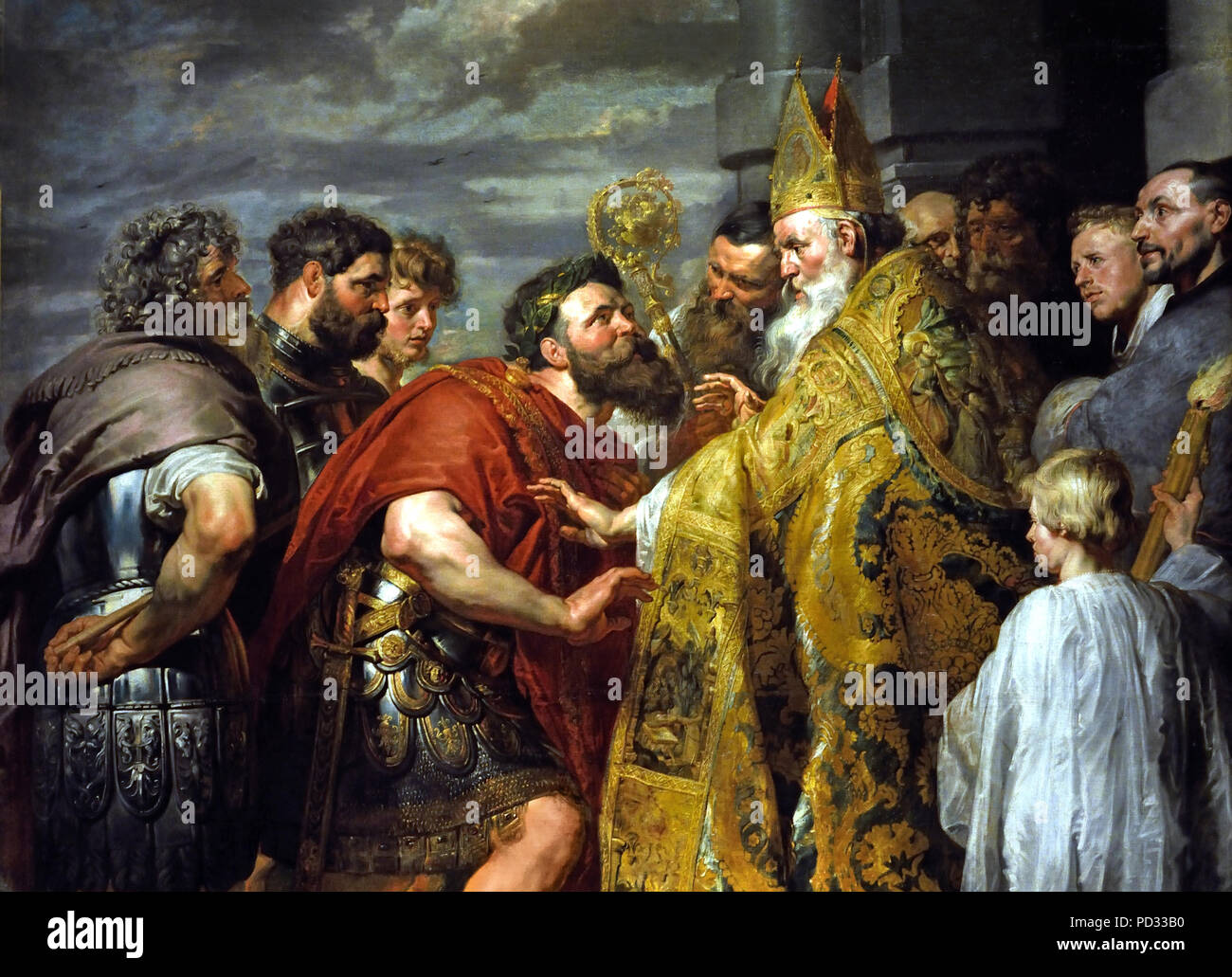 St Ambrose and Emperor Theodosius by Peter Paul Rubens (1577–1640) Flemish Belgian Belgium ( It shows the Roman emperor Theodosius I and his entourage being barred from Milan Cathedral by its archbishop saint Ambrose, as punishment for the Massacre of Thessalonica. ) Stock Photohttps://www.alamy.com/image-license-details/?v=1https://www.alamy.com/st-ambrose-and-emperor-theodosius-by-peter-paul-rubens-15771640-flemish-belgian-belgium-it-shows-the-roman-emperor-theodosius-i-and-his-entourage-being-barred-from-milan-cathedral-by-its-archbishop-saint-ambrose-as-punishment-for-the-massacre-of-thessalonica-image214583460.html
St Ambrose and Emperor Theodosius by Peter Paul Rubens (1577–1640) Flemish Belgian Belgium ( It shows the Roman emperor Theodosius I and his entourage being barred from Milan Cathedral by its archbishop saint Ambrose, as punishment for the Massacre of Thessalonica. ) Stock Photohttps://www.alamy.com/image-license-details/?v=1https://www.alamy.com/st-ambrose-and-emperor-theodosius-by-peter-paul-rubens-15771640-flemish-belgian-belgium-it-shows-the-roman-emperor-theodosius-i-and-his-entourage-being-barred-from-milan-cathedral-by-its-archbishop-saint-ambrose-as-punishment-for-the-massacre-of-thessalonica-image214583460.htmlRMPD33B0–St Ambrose and Emperor Theodosius by Peter Paul Rubens (1577–1640) Flemish Belgian Belgium ( It shows the Roman emperor Theodosius I and his entourage being barred from Milan Cathedral by its archbishop saint Ambrose, as punishment for the Massacre of Thessalonica. )
 Relief Carving of Byzantine Emperor Theodosius I, or Theodosius the Great, Crowning Victors at the Base of the Egyptian Obelisk in the Hippodrome, Sultanahmet District, Istanbul, Turkey Stock Photohttps://www.alamy.com/image-license-details/?v=1https://www.alamy.com/stock-photo-relief-carving-of-byzantine-emperor-theodosius-i-or-theodosius-the-133456297.html
Relief Carving of Byzantine Emperor Theodosius I, or Theodosius the Great, Crowning Victors at the Base of the Egyptian Obelisk in the Hippodrome, Sultanahmet District, Istanbul, Turkey Stock Photohttps://www.alamy.com/image-license-details/?v=1https://www.alamy.com/stock-photo-relief-carving-of-byzantine-emperor-theodosius-i-or-theodosius-the-133456297.htmlRMHN3CT9–Relief Carving of Byzantine Emperor Theodosius I, or Theodosius the Great, Crowning Victors at the Base of the Egyptian Obelisk in the Hippodrome, Sultanahmet District, Istanbul, Turkey
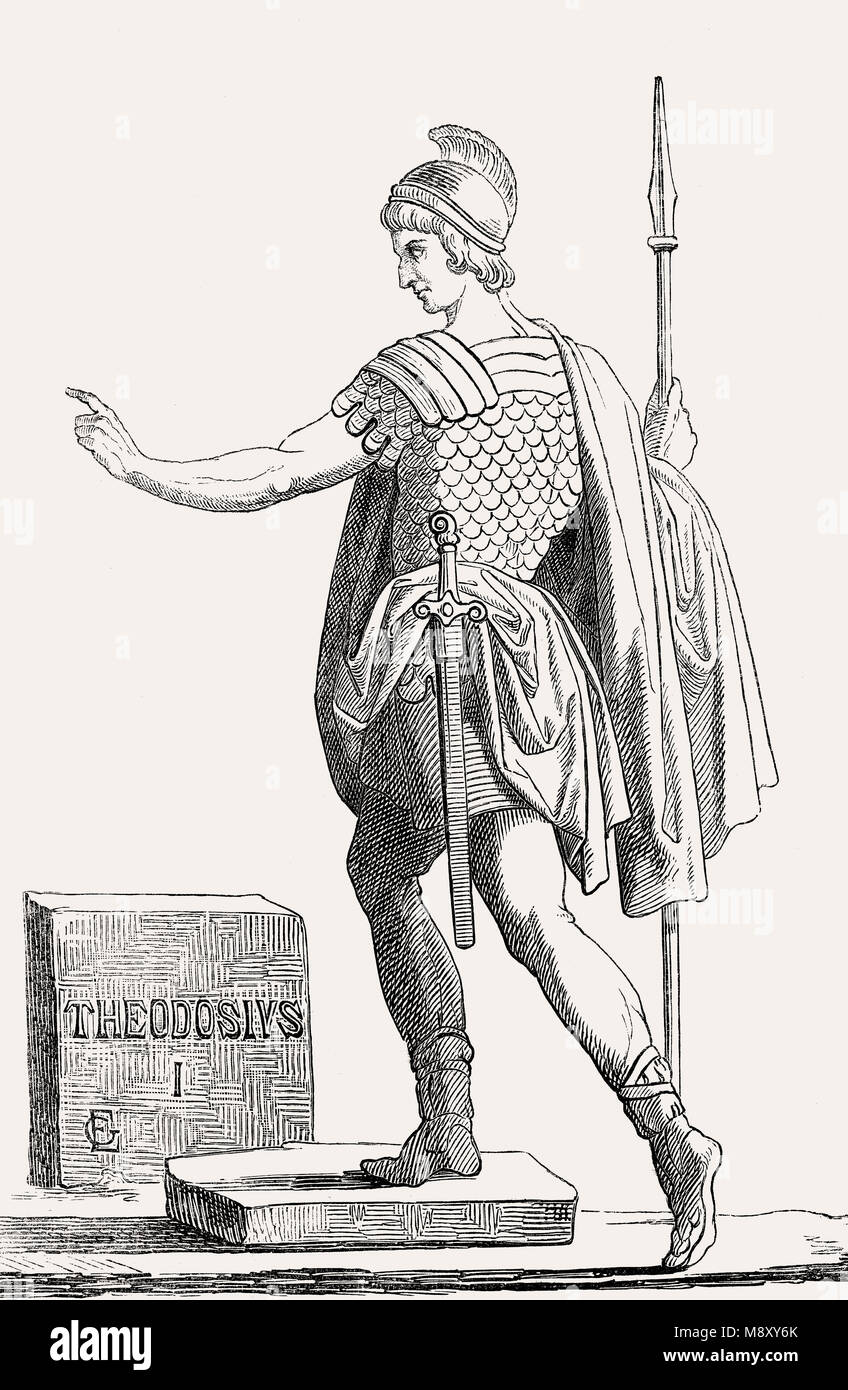 Theodosius I, Theodosius the Great, Roman Emperor from 379 to 395 Stock Photohttps://www.alamy.com/image-license-details/?v=1https://www.alamy.com/stock-photo-theodosius-i-theodosius-the-great-roman-emperor-from-379-to-395-177613035.html
Theodosius I, Theodosius the Great, Roman Emperor from 379 to 395 Stock Photohttps://www.alamy.com/image-license-details/?v=1https://www.alamy.com/stock-photo-theodosius-i-theodosius-the-great-roman-emperor-from-379-to-395-177613035.htmlRMM8XY6K–Theodosius I, Theodosius the Great, Roman Emperor from 379 to 395
 Saint Ambrose barring Theodosius I from Milan Cathedral between 1619 and 1620. N/A 109 Anthonis van Dyck 005 Stock Photohttps://www.alamy.com/image-license-details/?v=1https://www.alamy.com/saint-ambrose-barring-theodosius-i-from-milan-cathedral-between-1619-and-1620-na-109-anthonis-van-dyck-005-image209888120.html
Saint Ambrose barring Theodosius I from Milan Cathedral between 1619 and 1620. N/A 109 Anthonis van Dyck 005 Stock Photohttps://www.alamy.com/image-license-details/?v=1https://www.alamy.com/saint-ambrose-barring-theodosius-i-from-milan-cathedral-between-1619-and-1620-na-109-anthonis-van-dyck-005-image209888120.htmlRMP5D6C8–Saint Ambrose barring Theodosius I from Milan Cathedral between 1619 and 1620. N/A 109 Anthonis van Dyck 005
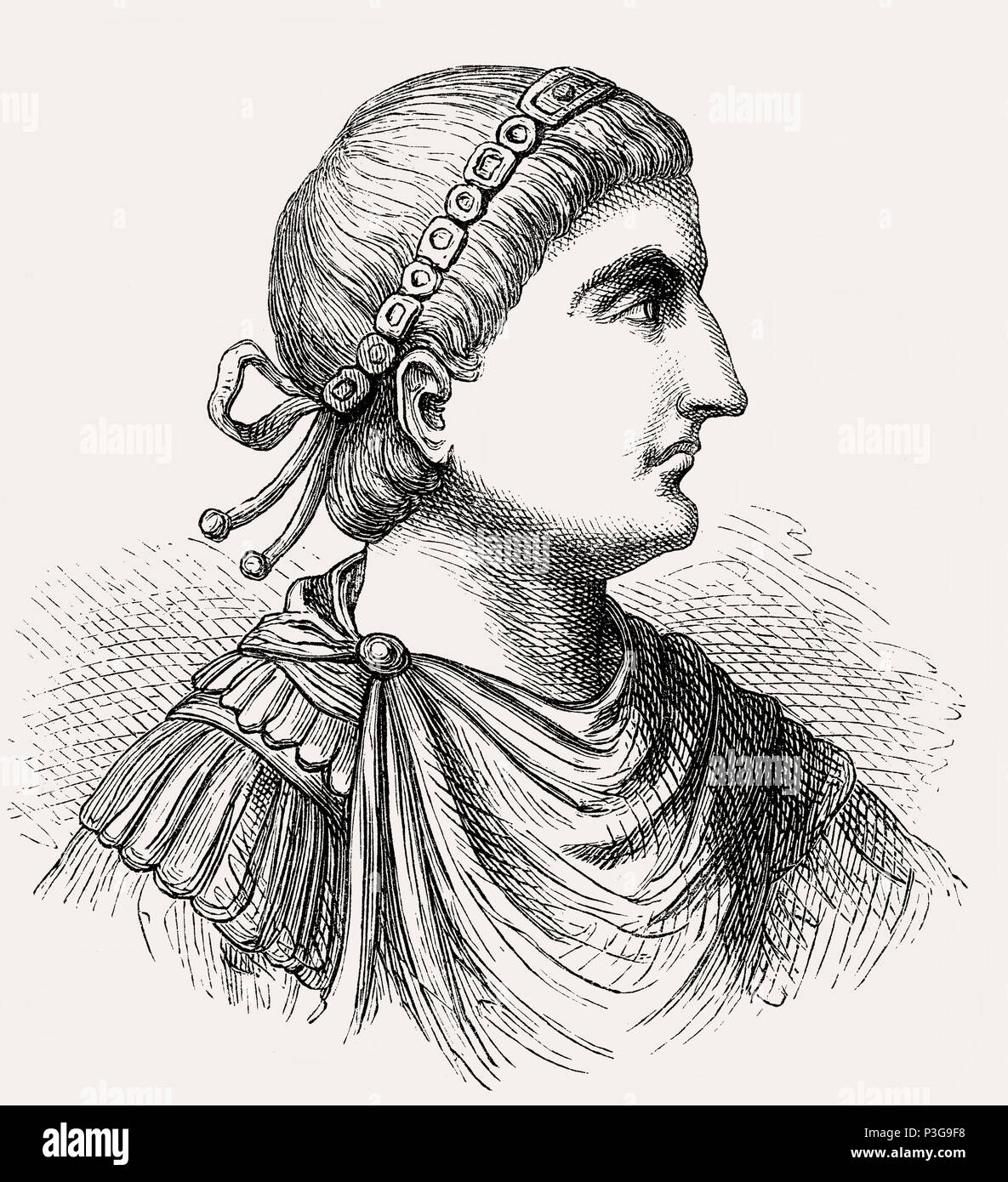 Theodosius I, Theodosius the Great, Roman Emperor from 379 to 395 Stock Photohttps://www.alamy.com/image-license-details/?v=1https://www.alamy.com/theodosius-i-theodosius-the-great-roman-emperor-from-379-to-395-image208727100.html
Theodosius I, Theodosius the Great, Roman Emperor from 379 to 395 Stock Photohttps://www.alamy.com/image-license-details/?v=1https://www.alamy.com/theodosius-i-theodosius-the-great-roman-emperor-from-379-to-395-image208727100.htmlRMP3G9F8–Theodosius I, Theodosius the Great, Roman Emperor from 379 to 395
 Honorius (384-423) was the second son of Emperor Theodosius I and younger brother to Eastern Emperor Arcadius. Honorius was made Augustus and co-ruler in 393 CE, aged 9. When his father died two years laters, Honorius was given the Western half of the Roman Empire, while Arcadius ruled the East. Young as he was, Honorius was mainly a figurehead for General Stilicho, who had been appointed his guardian and advisor by Theodosius before his death. Stilicho made Honorius marry his daughter Maria to strengthen their bonds. Honorius' reign, which was weak and chaotic even by the standards of the ra Stock Photohttps://www.alamy.com/image-license-details/?v=1https://www.alamy.com/honorius-384-423-was-the-second-son-of-emperor-theodosius-i-and-younger-brother-to-eastern-emperor-arcadius-honorius-was-made-augustus-and-co-ruler-in-393-ce-aged-9-when-his-father-died-two-years-laters-honorius-was-given-the-western-half-of-the-roman-empire-while-arcadius-ruled-the-east-young-as-he-was-honorius-was-mainly-a-figurehead-for-general-stilicho-who-had-been-appointed-his-guardian-and-advisor-by-theodosius-before-his-death-stilicho-made-honorius-marry-his-daughter-maria-to-strengthen-their-bonds-honorius-reign-which-was-weak-and-chaotic-even-by-the-standards-of-the-ra-image344281137.html
Honorius (384-423) was the second son of Emperor Theodosius I and younger brother to Eastern Emperor Arcadius. Honorius was made Augustus and co-ruler in 393 CE, aged 9. When his father died two years laters, Honorius was given the Western half of the Roman Empire, while Arcadius ruled the East. Young as he was, Honorius was mainly a figurehead for General Stilicho, who had been appointed his guardian and advisor by Theodosius before his death. Stilicho made Honorius marry his daughter Maria to strengthen their bonds. Honorius' reign, which was weak and chaotic even by the standards of the ra Stock Photohttps://www.alamy.com/image-license-details/?v=1https://www.alamy.com/honorius-384-423-was-the-second-son-of-emperor-theodosius-i-and-younger-brother-to-eastern-emperor-arcadius-honorius-was-made-augustus-and-co-ruler-in-393-ce-aged-9-when-his-father-died-two-years-laters-honorius-was-given-the-western-half-of-the-roman-empire-while-arcadius-ruled-the-east-young-as-he-was-honorius-was-mainly-a-figurehead-for-general-stilicho-who-had-been-appointed-his-guardian-and-advisor-by-theodosius-before-his-death-stilicho-made-honorius-marry-his-daughter-maria-to-strengthen-their-bonds-honorius-reign-which-was-weak-and-chaotic-even-by-the-standards-of-the-ra-image344281137.htmlRM2B03A2W–Honorius (384-423) was the second son of Emperor Theodosius I and younger brother to Eastern Emperor Arcadius. Honorius was made Augustus and co-ruler in 393 CE, aged 9. When his father died two years laters, Honorius was given the Western half of the Roman Empire, while Arcadius ruled the East. Young as he was, Honorius was mainly a figurehead for General Stilicho, who had been appointed his guardian and advisor by Theodosius before his death. Stilicho made Honorius marry his daughter Maria to strengthen their bonds. Honorius' reign, which was weak and chaotic even by the standards of the ra
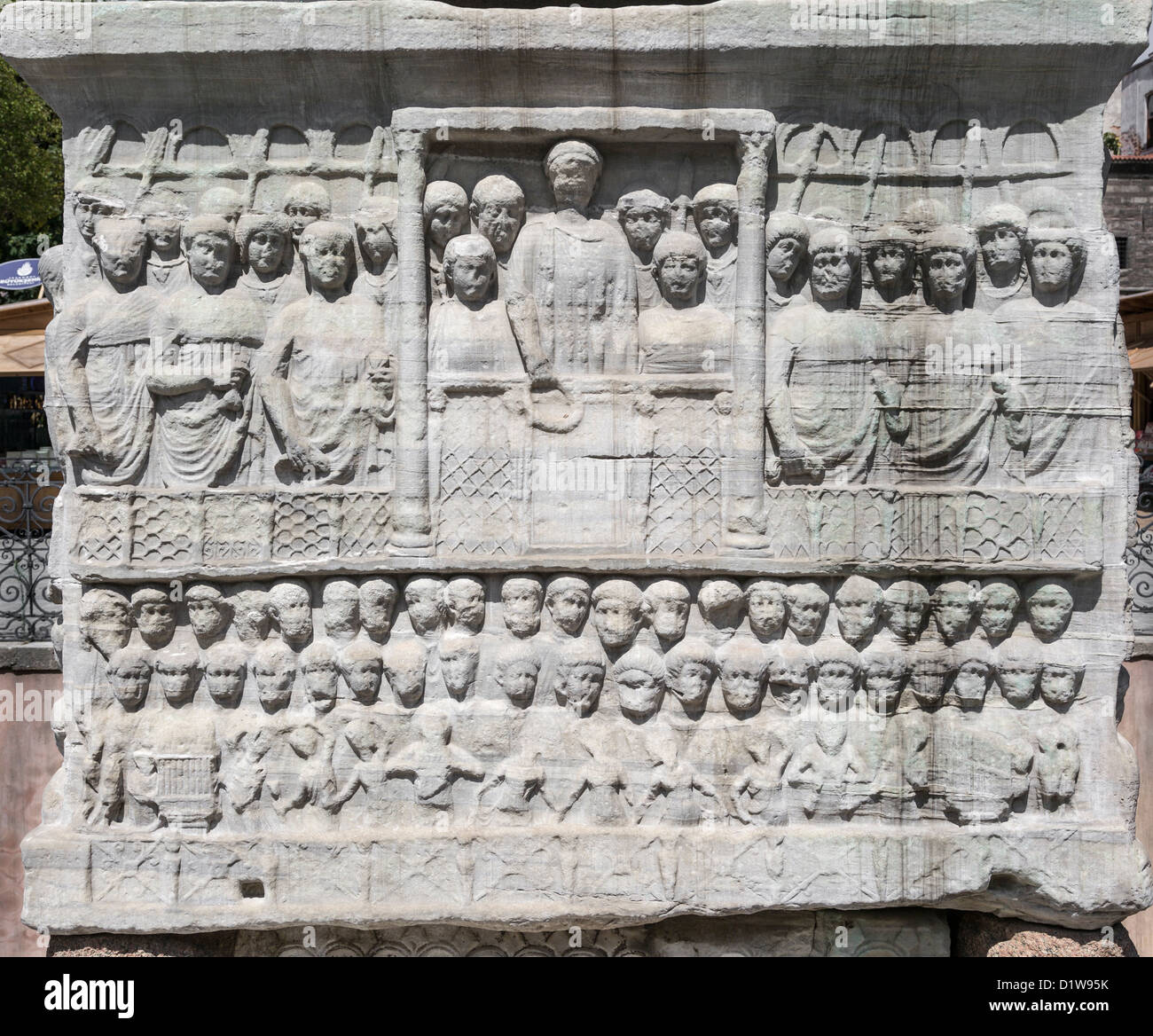 Detail of the pedestal of the Egyptian obelisk, Theodosius I offers laurels of victory, Sultan Ahmet meydan, Istanbul, Turkey Stock Photohttps://www.alamy.com/image-license-details/?v=1https://www.alamy.com/stock-photo-detail-of-the-pedestal-of-the-egyptian-obelisk-theodosius-i-offers-52801775.html
Detail of the pedestal of the Egyptian obelisk, Theodosius I offers laurels of victory, Sultan Ahmet meydan, Istanbul, Turkey Stock Photohttps://www.alamy.com/image-license-details/?v=1https://www.alamy.com/stock-photo-detail-of-the-pedestal-of-the-egyptian-obelisk-theodosius-i-offers-52801775.htmlRMD1W95K–Detail of the pedestal of the Egyptian obelisk, Theodosius I offers laurels of victory, Sultan Ahmet meydan, Istanbul, Turkey
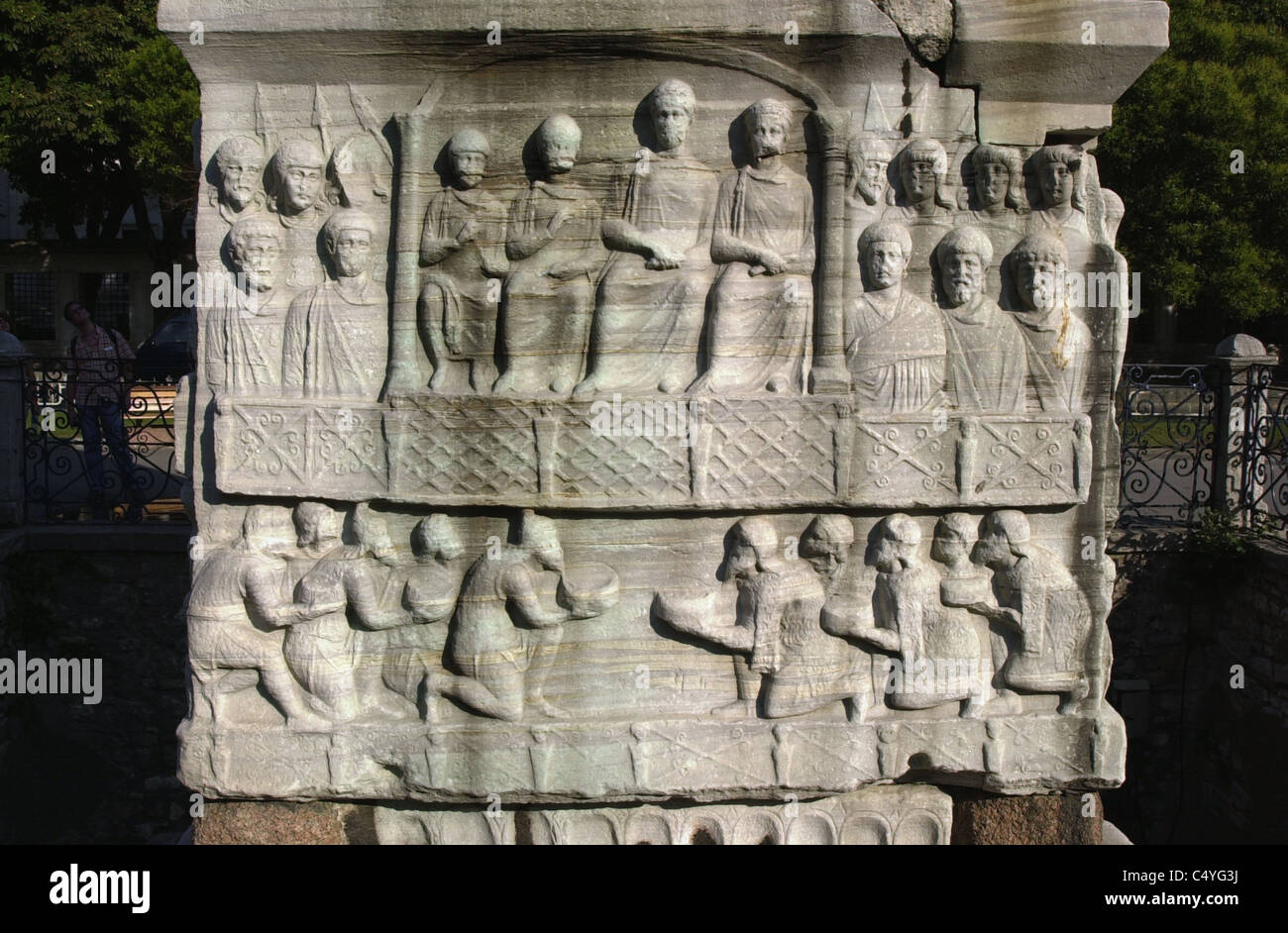 Base of Egyptian Obelisk set up by Theodosius I c. 390 AD. İstanbul, Turkey 010810 048 Stock Photohttps://www.alamy.com/image-license-details/?v=1https://www.alamy.com/stock-photo-base-of-egyptian-obelisk-set-up-by-theodosius-i-c-390-ad-stanbul-turkey-37484710.html
Base of Egyptian Obelisk set up by Theodosius I c. 390 AD. İstanbul, Turkey 010810 048 Stock Photohttps://www.alamy.com/image-license-details/?v=1https://www.alamy.com/stock-photo-base-of-egyptian-obelisk-set-up-by-theodosius-i-c-390-ad-stanbul-turkey-37484710.htmlRMC4YG3J–Base of Egyptian Obelisk set up by Theodosius I c. 390 AD. İstanbul, Turkey 010810 048
 Solidus of Theodosius I the Great (obverse), 383-388. Byzantium, Constantinople, Byzantine period, 4th century. Gold; diameter: 2.1 cm (13/16 in Stock Photohttps://www.alamy.com/image-license-details/?v=1https://www.alamy.com/solidus-of-theodosius-i-the-great-obverse-383-388-byzantium-constantinople-byzantine-period-4th-century-gold-diameter-21-cm-1316-in-image240446392.html
Solidus of Theodosius I the Great (obverse), 383-388. Byzantium, Constantinople, Byzantine period, 4th century. Gold; diameter: 2.1 cm (13/16 in Stock Photohttps://www.alamy.com/image-license-details/?v=1https://www.alamy.com/solidus-of-theodosius-i-the-great-obverse-383-388-byzantium-constantinople-byzantine-period-4th-century-gold-diameter-21-cm-1316-in-image240446392.htmlRMRY57R4–Solidus of Theodosius I the Great (obverse), 383-388. Byzantium, Constantinople, Byzantine period, 4th century. Gold; diameter: 2.1 cm (13/16 in
 9 Solidi, Theodosius I, emperor with ensigns, Aquileia, 378-383 AD - Bode-Museum - DSC02732. Stock Photohttps://www.alamy.com/image-license-details/?v=1https://www.alamy.com/9-solidi-theodosius-i-emperor-with-ensigns-aquileia-378-383-ad-bode-museum-dsc02732-image211826337.html
9 Solidi, Theodosius I, emperor with ensigns, Aquileia, 378-383 AD - Bode-Museum - DSC02732. Stock Photohttps://www.alamy.com/image-license-details/?v=1https://www.alamy.com/9-solidi-theodosius-i-emperor-with-ensigns-aquileia-378-383-ad-bode-museum-dsc02732-image211826337.htmlRMP8HEJ9–9 Solidi, Theodosius I, emperor with ensigns, Aquileia, 378-383 AD - Bode-Museum - DSC02732.
 Solidus (Coin) of Emperor Theodosius I, 383 (25 August)/388 (28 August), Byzantine, minted in Constantinople (now Istanbul), Constantinople, Gold, Diam. 2.1 cm, 4.50 g Stock Photohttps://www.alamy.com/image-license-details/?v=1https://www.alamy.com/solidus-coin-of-emperor-theodosius-i-383-25-august388-28-august-byzantine-minted-in-constantinople-now-istanbul-constantinople-gold-diam-21-cm-450-g-image328624071.html
Solidus (Coin) of Emperor Theodosius I, 383 (25 August)/388 (28 August), Byzantine, minted in Constantinople (now Istanbul), Constantinople, Gold, Diam. 2.1 cm, 4.50 g Stock Photohttps://www.alamy.com/image-license-details/?v=1https://www.alamy.com/solidus-coin-of-emperor-theodosius-i-383-25-august388-28-august-byzantine-minted-in-constantinople-now-istanbul-constantinople-gold-diam-21-cm-450-g-image328624071.htmlRM2A2J39Y–Solidus (Coin) of Emperor Theodosius I, 383 (25 August)/388 (28 August), Byzantine, minted in Constantinople (now Istanbul), Constantinople, Gold, Diam. 2.1 cm, 4.50 g
 Theodosius I (347-395). Roman emperor form 379-395. Stock Photohttps://www.alamy.com/image-license-details/?v=1https://www.alamy.com/theodosius-i-347-395-roman-emperor-form-379-395-image404979004.html
Theodosius I (347-395). Roman emperor form 379-395. Stock Photohttps://www.alamy.com/image-license-details/?v=1https://www.alamy.com/theodosius-i-347-395-roman-emperor-form-379-395-image404979004.htmlRM2EETART–Theodosius I (347-395). Roman emperor form 379-395.
 Solidus of Theodosius I the Great , 383-388. Byzantine Gold Coins The vast number of surviving Byzantine coins attests to the level of trade across the empire. Controlled and supervised by the emperor, the producers of coins took care to represent his authority and reflect his stature. Talented artists were recruited to engrave the dies (molds) used for the striking of coins. Emperors increasingly came to include their heirs and co-emperors on their coinage, as well as other family members or even earlier rulers. Coins were recognized, then as now, as small, portable works of art. With their i Stock Photohttps://www.alamy.com/image-license-details/?v=1https://www.alamy.com/solidus-of-theodosius-i-the-great-383-388-byzantine-gold-coins-the-vast-number-of-surviving-byzantine-coins-attests-to-the-level-of-trade-across-the-empire-controlled-and-supervised-by-the-emperor-the-producers-of-coins-took-care-to-represent-his-authority-and-reflect-his-stature-talented-artists-were-recruited-to-engrave-the-dies-molds-used-for-the-striking-of-coins-emperors-increasingly-came-to-include-their-heirs-and-co-emperors-on-their-coinage-as-well-as-other-family-members-or-even-earlier-rulers-coins-were-recognized-then-as-now-as-small-portable-works-of-art-with-their-i-image330120494.html
Solidus of Theodosius I the Great , 383-388. Byzantine Gold Coins The vast number of surviving Byzantine coins attests to the level of trade across the empire. Controlled and supervised by the emperor, the producers of coins took care to represent his authority and reflect his stature. Talented artists were recruited to engrave the dies (molds) used for the striking of coins. Emperors increasingly came to include their heirs and co-emperors on their coinage, as well as other family members or even earlier rulers. Coins were recognized, then as now, as small, portable works of art. With their i Stock Photohttps://www.alamy.com/image-license-details/?v=1https://www.alamy.com/solidus-of-theodosius-i-the-great-383-388-byzantine-gold-coins-the-vast-number-of-surviving-byzantine-coins-attests-to-the-level-of-trade-across-the-empire-controlled-and-supervised-by-the-emperor-the-producers-of-coins-took-care-to-represent-his-authority-and-reflect-his-stature-talented-artists-were-recruited-to-engrave-the-dies-molds-used-for-the-striking-of-coins-emperors-increasingly-came-to-include-their-heirs-and-co-emperors-on-their-coinage-as-well-as-other-family-members-or-even-earlier-rulers-coins-were-recognized-then-as-now-as-small-portable-works-of-art-with-their-i-image330120494.htmlRM2A5281J–Solidus of Theodosius I the Great , 383-388. Byzantine Gold Coins The vast number of surviving Byzantine coins attests to the level of trade across the empire. Controlled and supervised by the emperor, the producers of coins took care to represent his authority and reflect his stature. Talented artists were recruited to engrave the dies (molds) used for the striking of coins. Emperors increasingly came to include their heirs and co-emperors on their coinage, as well as other family members or even earlier rulers. Coins were recognized, then as now, as small, portable works of art. With their i
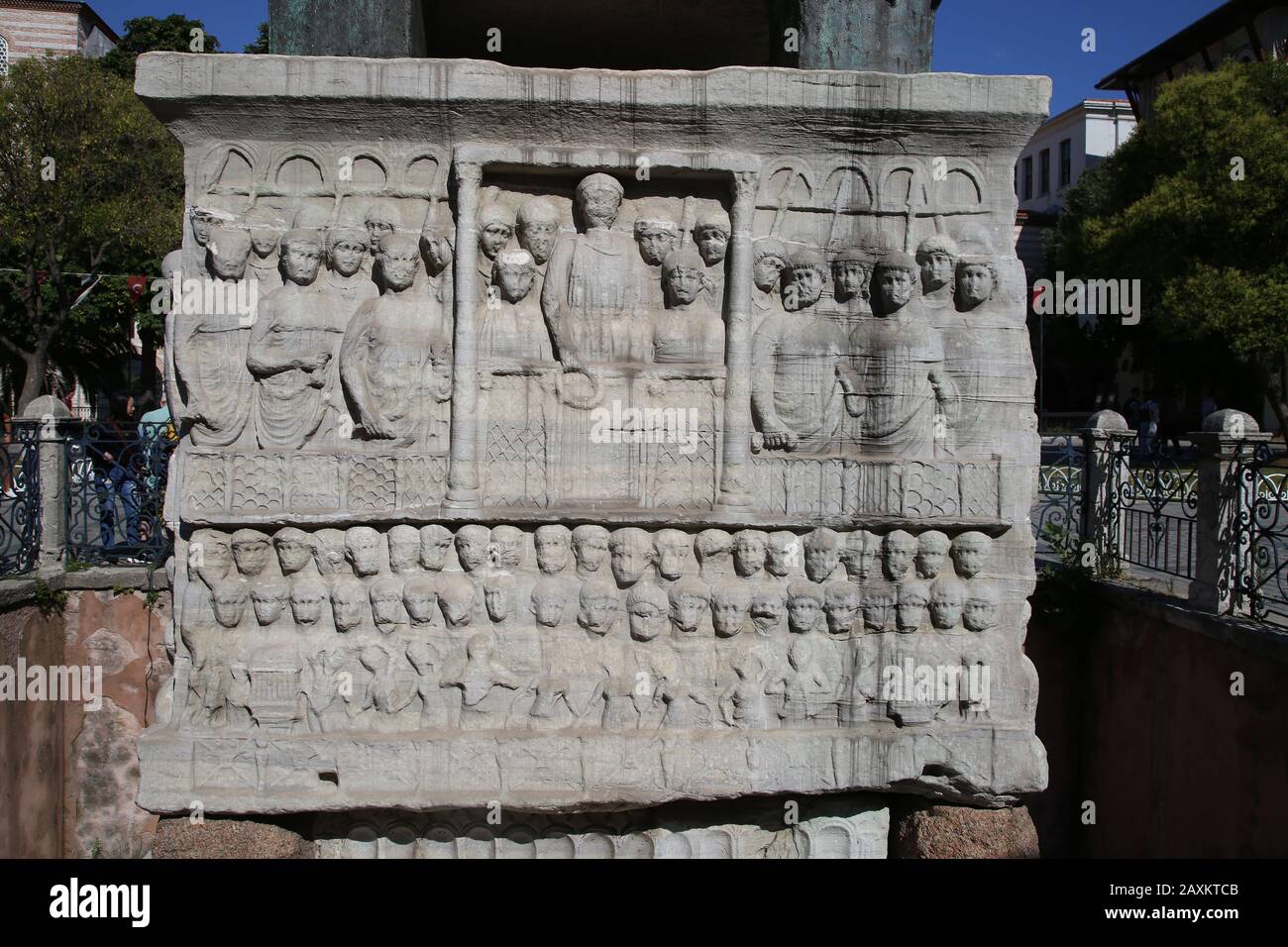 Turkey. Istanbul. Theodosius Obelisk. Pedestal. Emperor offering laurel of victory. 4th c. Hippodrome. Stock Photohttps://www.alamy.com/image-license-details/?v=1https://www.alamy.com/turkey-istanbul-theodosius-obelisk-pedestal-emperor-offering-laurel-of-victory-4th-c-hippodrome-image343414299.html
Turkey. Istanbul. Theodosius Obelisk. Pedestal. Emperor offering laurel of victory. 4th c. Hippodrome. Stock Photohttps://www.alamy.com/image-license-details/?v=1https://www.alamy.com/turkey-istanbul-theodosius-obelisk-pedestal-emperor-offering-laurel-of-victory-4th-c-hippodrome-image343414299.htmlRM2AXKTCB–Turkey. Istanbul. Theodosius Obelisk. Pedestal. Emperor offering laurel of victory. 4th c. Hippodrome.
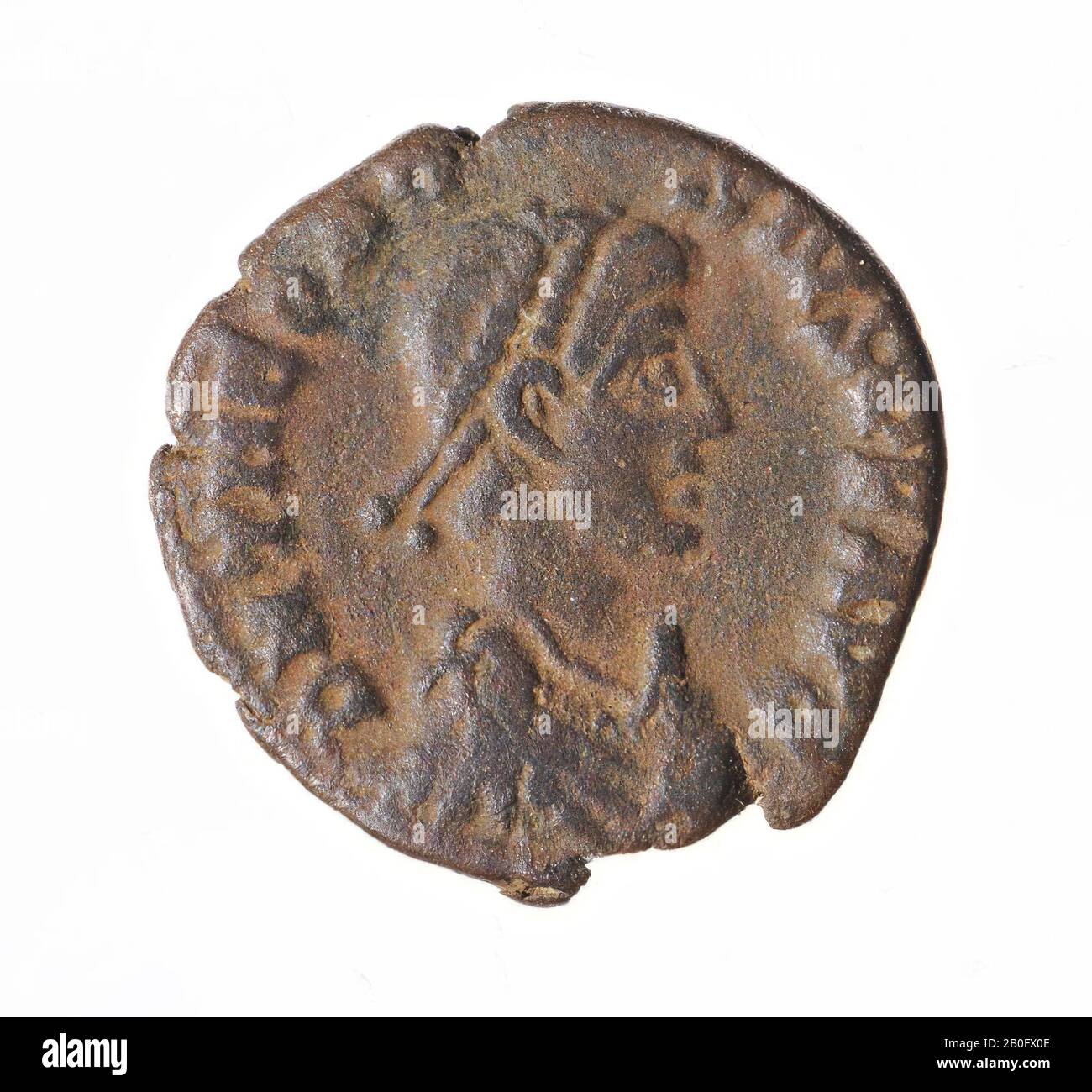 Vz: Bust, nd, DN THEODO - SIUS PF AUG, Kz: Victoria captivating a prisoner of war, SALUS REI - PUBLICAE, coin, AES-IV, Theodosius I, metal, copper, Diam. 13 mm, wt. 1.26 gr, roman 388-393, unknown, unknown, unknown, unknown Stock Photohttps://www.alamy.com/image-license-details/?v=1https://www.alamy.com/vz-bust-nd-dn-theodo-sius-pf-aug-kz-victoria-captivating-a-prisoner-of-war-salus-rei-publicae-coin-aes-iv-theodosius-i-metal-copper-diam-13-mm-wt-126-gr-roman-388-393-unknown-unknown-unknown-unknown-image344557038.html
Vz: Bust, nd, DN THEODO - SIUS PF AUG, Kz: Victoria captivating a prisoner of war, SALUS REI - PUBLICAE, coin, AES-IV, Theodosius I, metal, copper, Diam. 13 mm, wt. 1.26 gr, roman 388-393, unknown, unknown, unknown, unknown Stock Photohttps://www.alamy.com/image-license-details/?v=1https://www.alamy.com/vz-bust-nd-dn-theodo-sius-pf-aug-kz-victoria-captivating-a-prisoner-of-war-salus-rei-publicae-coin-aes-iv-theodosius-i-metal-copper-diam-13-mm-wt-126-gr-roman-388-393-unknown-unknown-unknown-unknown-image344557038.htmlRM2B0FX0E–Vz: Bust, nd, DN THEODO - SIUS PF AUG, Kz: Victoria captivating a prisoner of war, SALUS REI - PUBLICAE, coin, AES-IV, Theodosius I, metal, copper, Diam. 13 mm, wt. 1.26 gr, roman 388-393, unknown, unknown, unknown, unknown
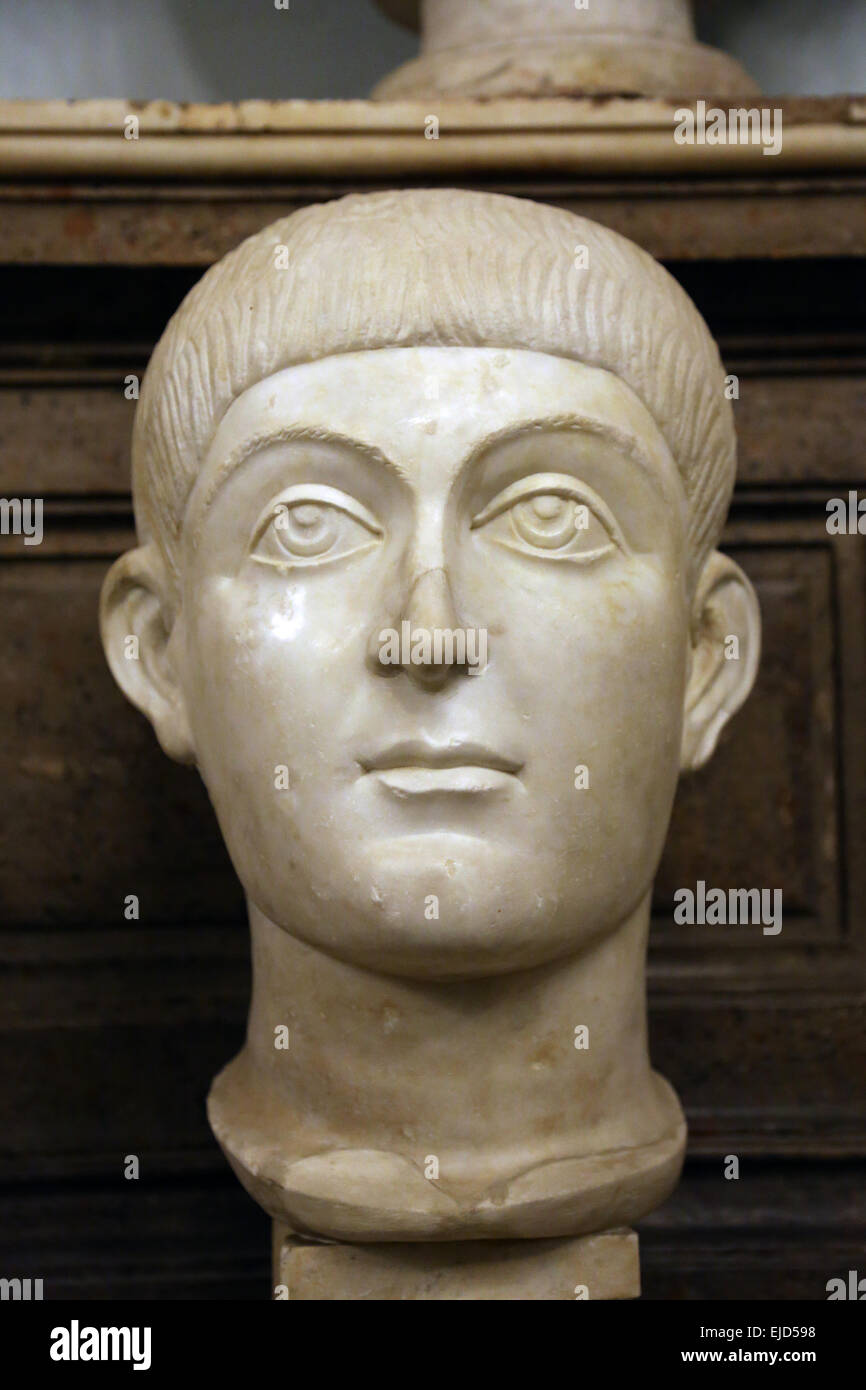 Honorius (384-423). Western Roman Emperor. Son of emperor Theodosius I. Theodosian Dynasty. Bust. Capitoline Museums. Rome. Stock Photohttps://www.alamy.com/image-license-details/?v=1https://www.alamy.com/stock-photo-honorius-384-423-western-roman-emperor-son-of-emperor-theodosius-i-80194836.html
Honorius (384-423). Western Roman Emperor. Son of emperor Theodosius I. Theodosian Dynasty. Bust. Capitoline Museums. Rome. Stock Photohttps://www.alamy.com/image-license-details/?v=1https://www.alamy.com/stock-photo-honorius-384-423-western-roman-emperor-son-of-emperor-theodosius-i-80194836.htmlRMEJD598–Honorius (384-423). Western Roman Emperor. Son of emperor Theodosius I. Theodosian Dynasty. Bust. Capitoline Museums. Rome.
 Coin with Theodosius I. Unknown Stock Photohttps://www.alamy.com/image-license-details/?v=1https://www.alamy.com/coin-with-theodosius-i-unknown-image416451189.html
Coin with Theodosius I. Unknown Stock Photohttps://www.alamy.com/image-license-details/?v=1https://www.alamy.com/coin-with-theodosius-i-unknown-image416451189.htmlRM2F5EYMN–Coin with Theodosius I. Unknown
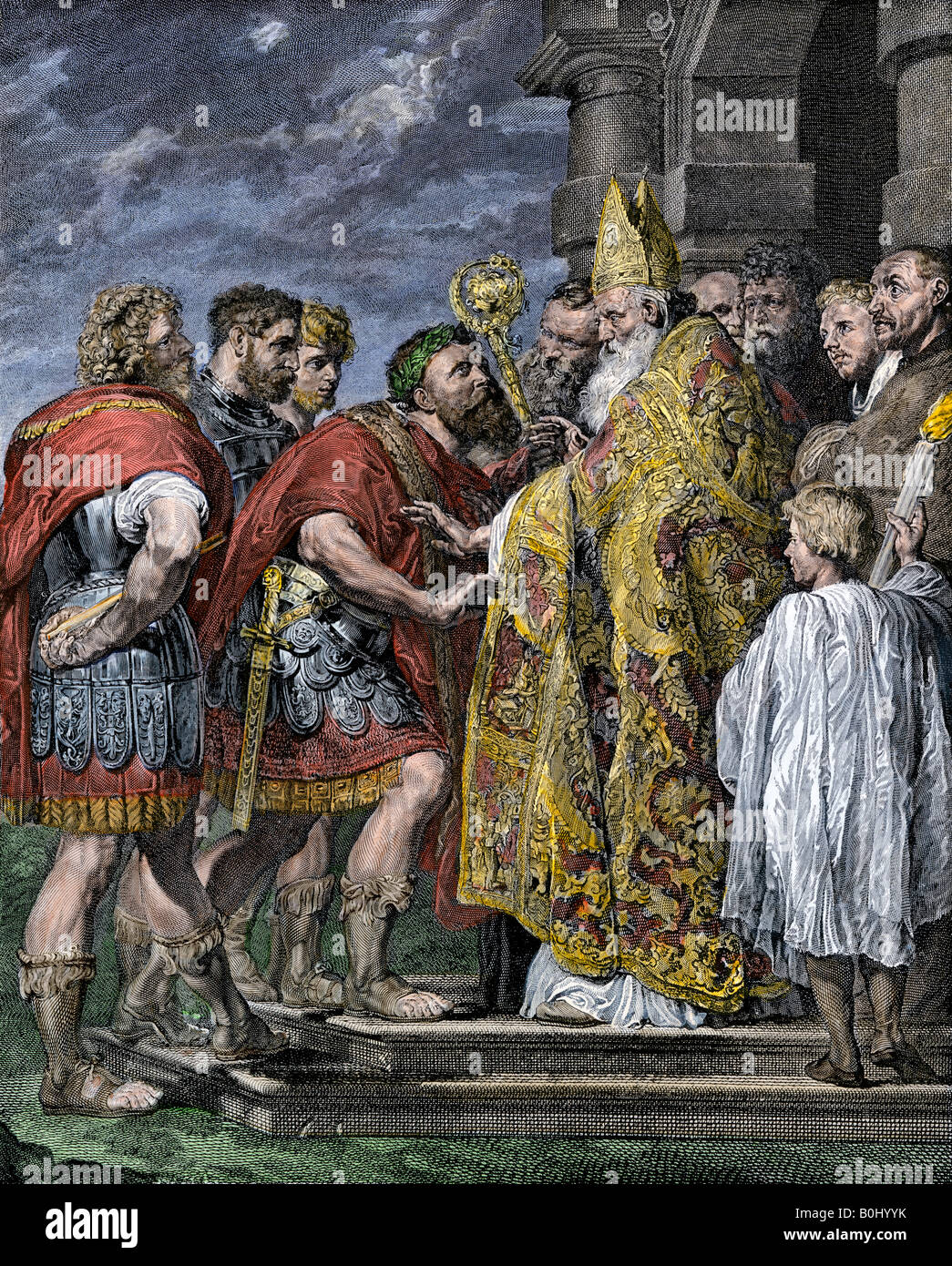 Bishop Ambrose rebukes Roman Emperor Theodosius I for atrocities in Thessalonica. Hand-colored woodcut Stock Photohttps://www.alamy.com/image-license-details/?v=1https://www.alamy.com/stock-photo-bishop-ambrose-rebukes-roman-emperor-theodosius-i-for-atrocities-in-17605495.html
Bishop Ambrose rebukes Roman Emperor Theodosius I for atrocities in Thessalonica. Hand-colored woodcut Stock Photohttps://www.alamy.com/image-license-details/?v=1https://www.alamy.com/stock-photo-bishop-ambrose-rebukes-roman-emperor-theodosius-i-for-atrocities-in-17605495.htmlRMB0HYYK–Bishop Ambrose rebukes Roman Emperor Theodosius I for atrocities in Thessalonica. Hand-colored woodcut
 Roman Rome Emperor Theodosius Italy Italian gold coin Stock Photohttps://www.alamy.com/image-license-details/?v=1https://www.alamy.com/roman-rome-emperor-theodosius-italy-italian-gold-coin-image6859057.html
Roman Rome Emperor Theodosius Italy Italian gold coin Stock Photohttps://www.alamy.com/image-license-details/?v=1https://www.alamy.com/roman-rome-emperor-theodosius-italy-italian-gold-coin-image6859057.htmlRMA86EY2–Roman Rome Emperor Theodosius Italy Italian gold coin
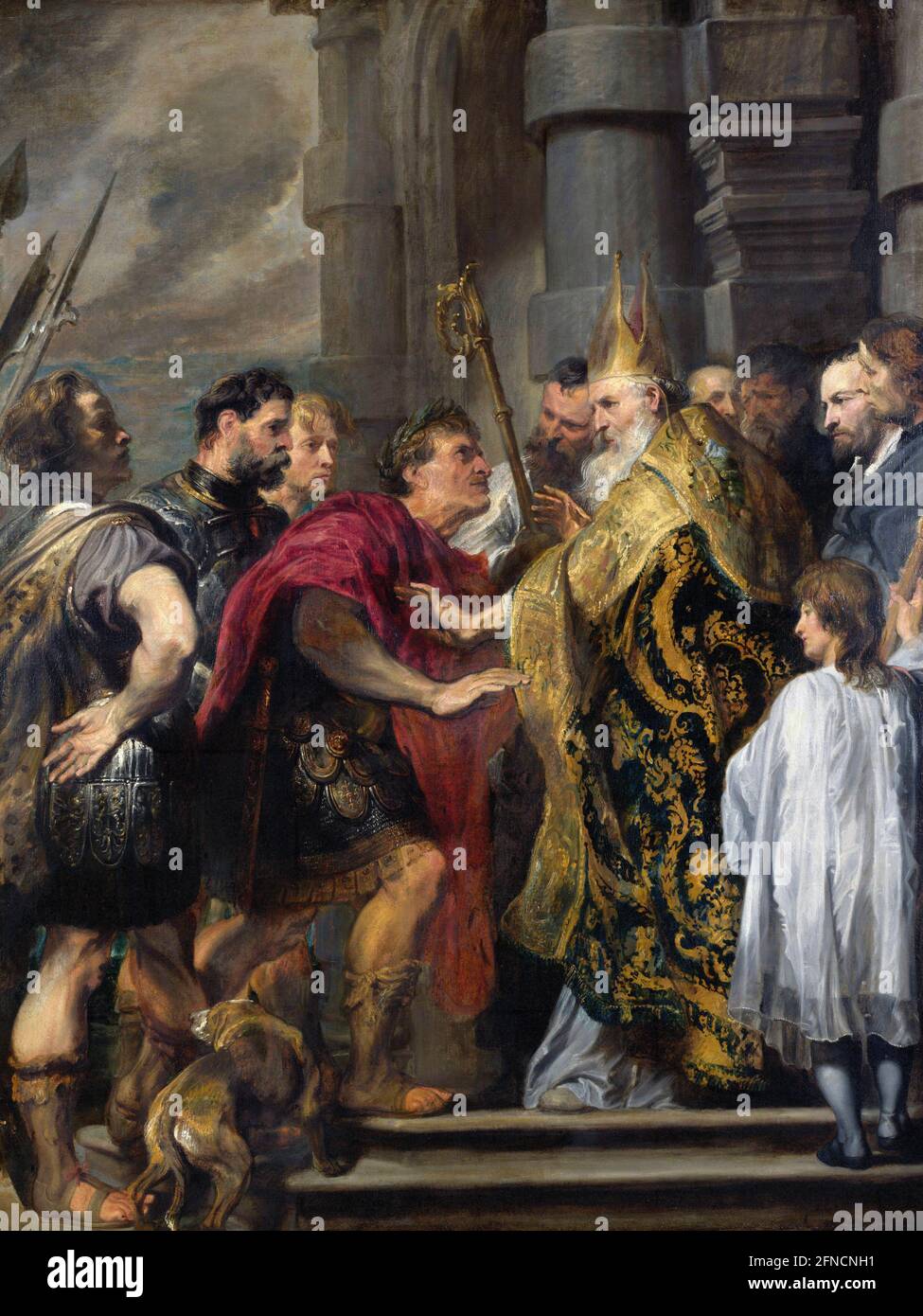 Theodosius I. St Anthony barring Theodosius from Milan Cathedral by Anthony van Dyck (1599–1641), oil on canvas, 1619/20 Stock Photohttps://www.alamy.com/image-license-details/?v=1https://www.alamy.com/theodosius-i-st-anthony-barring-theodosius-from-milan-cathedral-by-anthony-van-dyck-15991641-oil-on-canvas-161920-image426236973.html
Theodosius I. St Anthony barring Theodosius from Milan Cathedral by Anthony van Dyck (1599–1641), oil on canvas, 1619/20 Stock Photohttps://www.alamy.com/image-license-details/?v=1https://www.alamy.com/theodosius-i-st-anthony-barring-theodosius-from-milan-cathedral-by-anthony-van-dyck-15991641-oil-on-canvas-161920-image426236973.htmlRM2FNCNH1–Theodosius I. St Anthony barring Theodosius from Milan Cathedral by Anthony van Dyck (1599–1641), oil on canvas, 1619/20
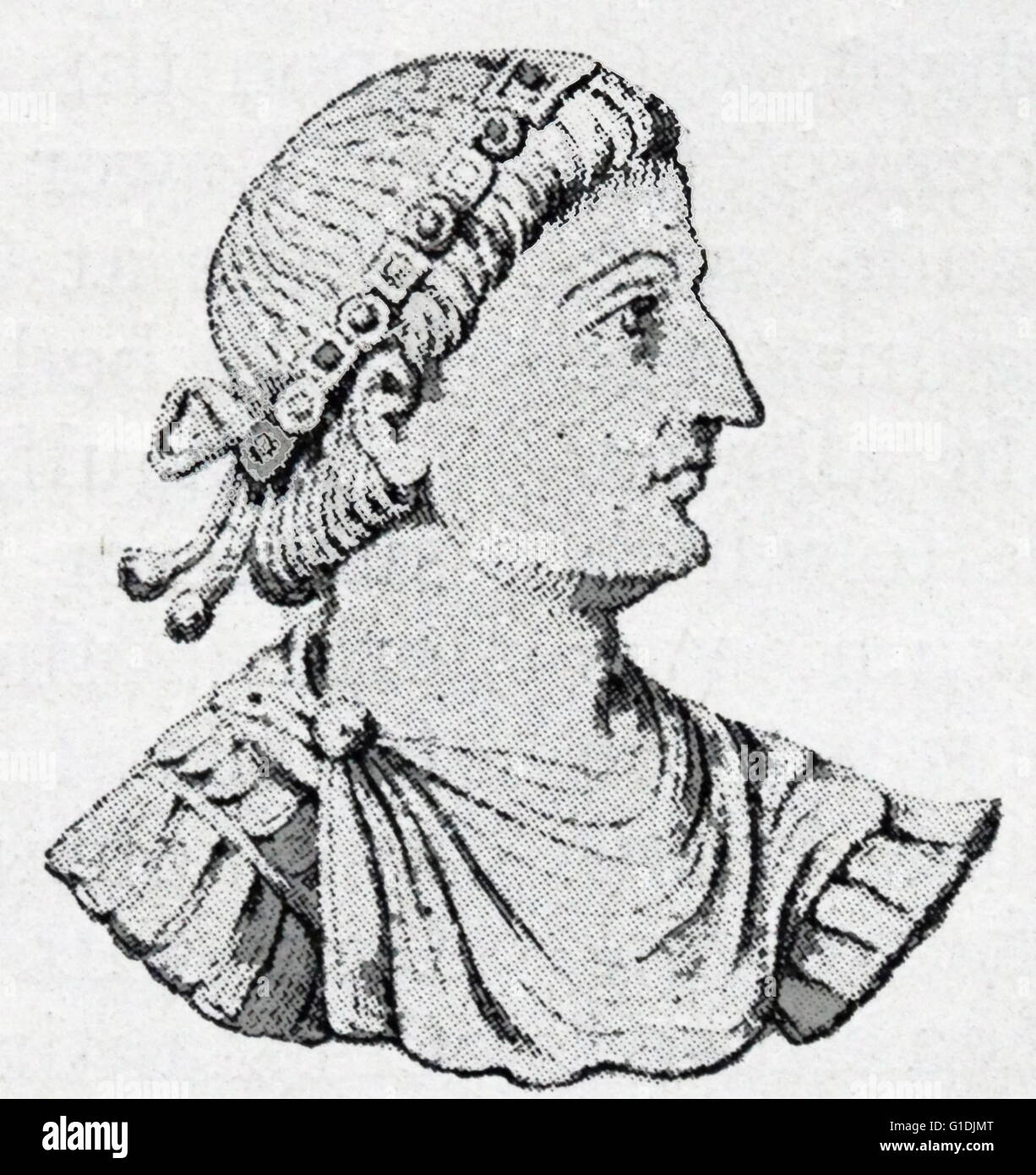 Bust of Theodosius I (347-395) Theodosius was the last emperor to rule over both the eastern and the western halves of the Roman Empire. Stock Photohttps://www.alamy.com/image-license-details/?v=1https://www.alamy.com/stock-photo-bust-of-theodosius-i-347-395-theodosius-was-the-last-emperor-to-rule-104176936.html
Bust of Theodosius I (347-395) Theodosius was the last emperor to rule over both the eastern and the western halves of the Roman Empire. Stock Photohttps://www.alamy.com/image-license-details/?v=1https://www.alamy.com/stock-photo-bust-of-theodosius-i-347-395-theodosius-was-the-last-emperor-to-rule-104176936.htmlRMG1DJMT–Bust of Theodosius I (347-395) Theodosius was the last emperor to rule over both the eastern and the western halves of the Roman Empire.
 Theodosius I., Flavius Theodosius Augustus, 347 - 395, also known as Theodosius the Great, was Roman Emperor from AD 379 to AD 395, the story of the ancient Rome, roman Empire, Italy Stock Photohttps://www.alamy.com/image-license-details/?v=1https://www.alamy.com/stock-photo-theodosius-i-flavius-theodosius-augustus-347-395-also-known-as-theodosius-128154908.html
Theodosius I., Flavius Theodosius Augustus, 347 - 395, also known as Theodosius the Great, was Roman Emperor from AD 379 to AD 395, the story of the ancient Rome, roman Empire, Italy Stock Photohttps://www.alamy.com/image-license-details/?v=1https://www.alamy.com/stock-photo-theodosius-i-flavius-theodosius-augustus-347-395-also-known-as-theodosius-128154908.htmlRFHCDXW0–Theodosius I., Flavius Theodosius Augustus, 347 - 395, also known as Theodosius the Great, was Roman Emperor from AD 379 to AD 395, the story of the ancient Rome, roman Empire, Italy
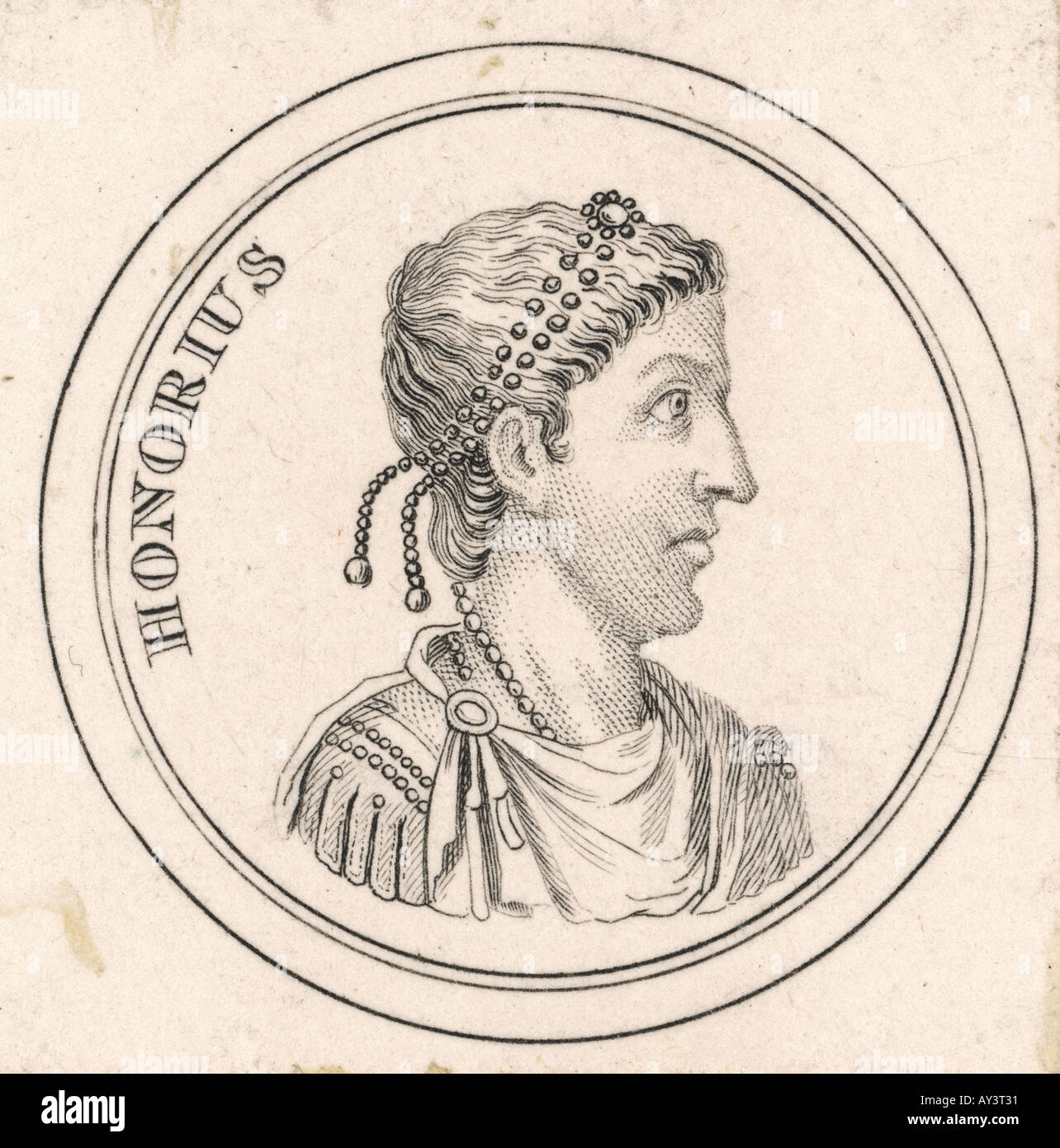 Emperor Honorius Stock Photohttps://www.alamy.com/image-license-details/?v=1https://www.alamy.com/emperor-honorius-image5545008.html
Emperor Honorius Stock Photohttps://www.alamy.com/image-license-details/?v=1https://www.alamy.com/emperor-honorius-image5545008.htmlRMAY3T31–Emperor Honorius
 Obelisk of Roman emperor Theodosius.4th century AD. Detail of the pedestal. Theodosius I offers laurels of victory. Hippodrome of Constantinople. Istanbul, Turkey. Stock Photohttps://www.alamy.com/image-license-details/?v=1https://www.alamy.com/obelisk-of-roman-emperor-theodosius4th-century-ad-detail-of-the-pedestal-theodosius-i-offers-laurels-of-victory-hippodrome-of-constantinople-istanbul-turkey-image368332988.html
Obelisk of Roman emperor Theodosius.4th century AD. Detail of the pedestal. Theodosius I offers laurels of victory. Hippodrome of Constantinople. Istanbul, Turkey. Stock Photohttps://www.alamy.com/image-license-details/?v=1https://www.alamy.com/obelisk-of-roman-emperor-theodosius4th-century-ad-detail-of-the-pedestal-theodosius-i-offers-laurels-of-victory-hippodrome-of-constantinople-istanbul-turkey-image368332988.htmlRM2CB70DG–Obelisk of Roman emperor Theodosius.4th century AD. Detail of the pedestal. Theodosius I offers laurels of victory. Hippodrome of Constantinople. Istanbul, Turkey.
 silver coin of Theodosius I (360-363 AD), with palace on it, coin, metal, silver, vmea 375-400 AD, Netherlands, Limburg, Gennep, Gennep Stock Photohttps://www.alamy.com/image-license-details/?v=1https://www.alamy.com/silver-coin-of-theodosius-i-360-363-ad-with-palace-on-it-coin-metal-silver-vmea-375-400-ad-netherlands-limburg-gennep-gennep-image344550709.html
silver coin of Theodosius I (360-363 AD), with palace on it, coin, metal, silver, vmea 375-400 AD, Netherlands, Limburg, Gennep, Gennep Stock Photohttps://www.alamy.com/image-license-details/?v=1https://www.alamy.com/silver-coin-of-theodosius-i-360-363-ad-with-palace-on-it-coin-metal-silver-vmea-375-400-ad-netherlands-limburg-gennep-gennep-image344550709.htmlRM2B0FHXD–silver coin of Theodosius I (360-363 AD), with palace on it, coin, metal, silver, vmea 375-400 AD, Netherlands, Limburg, Gennep, Gennep
 Historia de España. Bautismo de Teodosio I el Grande (347-395), emperador romano cristiano, por el obispo Acolio de Tesalónica. Stock Photohttps://www.alamy.com/image-license-details/?v=1https://www.alamy.com/historia-de-espaa-bautismo-de-teodosio-i-el-grande-347-395-emperador-romano-cristiano-por-el-obispo-acolio-de-tesalnica-image220261628.html
Historia de España. Bautismo de Teodosio I el Grande (347-395), emperador romano cristiano, por el obispo Acolio de Tesalónica. Stock Photohttps://www.alamy.com/image-license-details/?v=1https://www.alamy.com/historia-de-espaa-bautismo-de-teodosio-i-el-grande-347-395-emperador-romano-cristiano-por-el-obispo-acolio-de-tesalnica-image220261628.htmlRMPP9NXM–Historia de España. Bautismo de Teodosio I el Grande (347-395), emperador romano cristiano, por el obispo Acolio de Tesalónica.
 The Netherlands Roman period, coin, AES-IV, Theodosius I, metal, copper, Diam., 12x14 mm, wt., 1.05 gr, roman 388-394, the Netherlands Stock Photohttps://www.alamy.com/image-license-details/?v=1https://www.alamy.com/the-netherlands-roman-period-coin-aes-iv-theodosius-i-metal-copper-diam-12x14-mm-wt-105-gr-roman-388-394-the-netherlands-image344544751.html
The Netherlands Roman period, coin, AES-IV, Theodosius I, metal, copper, Diam., 12x14 mm, wt., 1.05 gr, roman 388-394, the Netherlands Stock Photohttps://www.alamy.com/image-license-details/?v=1https://www.alamy.com/the-netherlands-roman-period-coin-aes-iv-theodosius-i-metal-copper-diam-12x14-mm-wt-105-gr-roman-388-394-the-netherlands-image344544751.htmlRM2B0FA9K–The Netherlands Roman period, coin, AES-IV, Theodosius I, metal, copper, Diam., 12x14 mm, wt., 1.05 gr, roman 388-394, the Netherlands
 Ancient stone relief, Theodosius with laurel wreath, base of the Egyptian obelisk, ancient Byzantine Hippodrome, Sultanahmet, I Stock Photohttps://www.alamy.com/image-license-details/?v=1https://www.alamy.com/stock-photo-ancient-stone-relief-theodosius-with-laurel-wreath-base-of-the-egyptian-24436568.html
Ancient stone relief, Theodosius with laurel wreath, base of the Egyptian obelisk, ancient Byzantine Hippodrome, Sultanahmet, I Stock Photohttps://www.alamy.com/image-license-details/?v=1https://www.alamy.com/stock-photo-ancient-stone-relief-theodosius-with-laurel-wreath-base-of-the-egyptian-24436568.htmlRMBBN52G–Ancient stone relief, Theodosius with laurel wreath, base of the Egyptian obelisk, ancient Byzantine Hippodrome, Sultanahmet, I
 Solidus of Theodosius I the Great (reverse), c. 383-388. Byzantium, Constantinople, Byzantine period, 4th century. Gold; diameter: 2.1 cm (13/16 in Stock Photohttps://www.alamy.com/image-license-details/?v=1https://www.alamy.com/solidus-of-theodosius-i-the-great-reverse-c-383-388-byzantium-constantinople-byzantine-period-4th-century-gold-diameter-21-cm-1316-in-image240446396.html
Solidus of Theodosius I the Great (reverse), c. 383-388. Byzantium, Constantinople, Byzantine period, 4th century. Gold; diameter: 2.1 cm (13/16 in Stock Photohttps://www.alamy.com/image-license-details/?v=1https://www.alamy.com/solidus-of-theodosius-i-the-great-reverse-c-383-388-byzantium-constantinople-byzantine-period-4th-century-gold-diameter-21-cm-1316-in-image240446396.htmlRMRY57R8–Solidus of Theodosius I the Great (reverse), c. 383-388. Byzantium, Constantinople, Byzantine period, 4th century. Gold; diameter: 2.1 cm (13/16 in
 Istanbul Turkey Meydani Serpentine Column with Obelisk of Theodosius I (Egyptian Obelisk of Thutmose III Re-erected at the Hippodrome) Stock Photohttps://www.alamy.com/image-license-details/?v=1https://www.alamy.com/stock-photo-istanbul-turkey-meydani-serpentine-column-with-obelisk-of-theodosius-41273679.html
Istanbul Turkey Meydani Serpentine Column with Obelisk of Theodosius I (Egyptian Obelisk of Thutmose III Re-erected at the Hippodrome) Stock Photohttps://www.alamy.com/image-license-details/?v=1https://www.alamy.com/stock-photo-istanbul-turkey-meydani-serpentine-column-with-obelisk-of-theodosius-41273679.htmlRMCB44YY–Istanbul Turkey Meydani Serpentine Column with Obelisk of Theodosius I (Egyptian Obelisk of Thutmose III Re-erected at the Hippodrome)
 The Netherlands Roman period, coin, AES-IV, Theodosius I, metal, copper, Diam., 13 mm, wt., 0.80 gr, roman 388-395, the Netherlands, Limburg, Roerdalen, Melick Stock Photohttps://www.alamy.com/image-license-details/?v=1https://www.alamy.com/the-netherlands-roman-period-coin-aes-iv-theodosius-i-metal-copper-diam-13-mm-wt-080-gr-roman-388-395-the-netherlands-limburg-roerdalen-melick-image344541010.html
The Netherlands Roman period, coin, AES-IV, Theodosius I, metal, copper, Diam., 13 mm, wt., 0.80 gr, roman 388-395, the Netherlands, Limburg, Roerdalen, Melick Stock Photohttps://www.alamy.com/image-license-details/?v=1https://www.alamy.com/the-netherlands-roman-period-coin-aes-iv-theodosius-i-metal-copper-diam-13-mm-wt-080-gr-roman-388-395-the-netherlands-limburg-roerdalen-melick-image344541010.htmlRM2B0F5G2–The Netherlands Roman period, coin, AES-IV, Theodosius I, metal, copper, Diam., 13 mm, wt., 0.80 gr, roman 388-395, the Netherlands, Limburg, Roerdalen, Melick
 Gold Solidus of Theodosius I (379-95), Byzantine, 379-395. Stock Photohttps://www.alamy.com/image-license-details/?v=1https://www.alamy.com/gold-solidus-of-theodosius-i-379-95-byzantine-379-395-image382617347.html
Gold Solidus of Theodosius I (379-95), Byzantine, 379-395. Stock Photohttps://www.alamy.com/image-license-details/?v=1https://www.alamy.com/gold-solidus-of-theodosius-i-379-95-byzantine-379-395-image382617347.htmlRM2D6DM97–Gold Solidus of Theodosius I (379-95), Byzantine, 379-395.
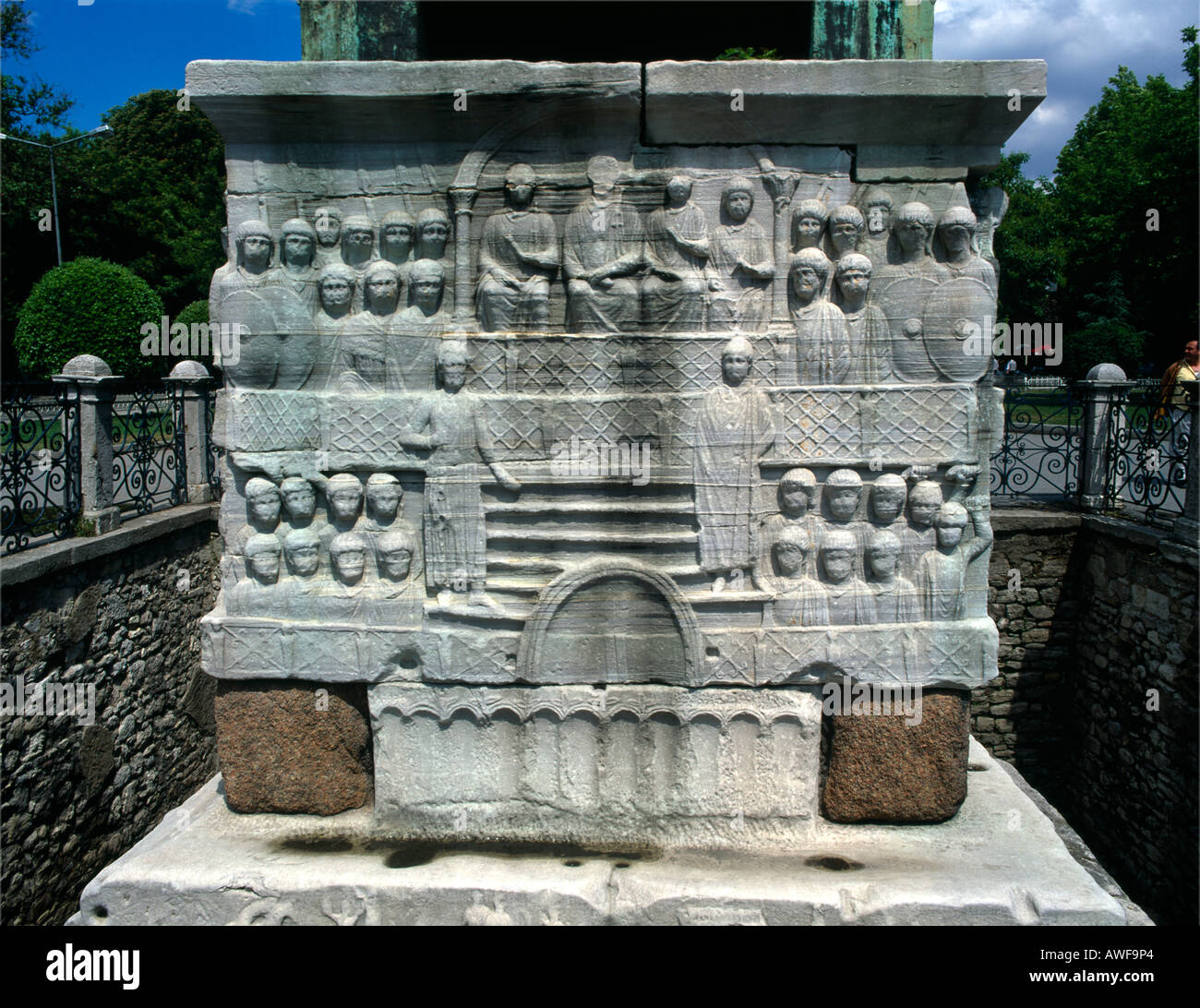 Istanbul Turkey Meydani (Hippodrome of Constantinople) Bas-Relief of the Emperor Theodosius I and His Court Pedestal underneath the Obelisk of Theodos Stock Photohttps://www.alamy.com/image-license-details/?v=1https://www.alamy.com/istanbul-turkey-meydani-hippodrome-of-constantinople-bas-relief-of-image9465379.html
Istanbul Turkey Meydani (Hippodrome of Constantinople) Bas-Relief of the Emperor Theodosius I and His Court Pedestal underneath the Obelisk of Theodos Stock Photohttps://www.alamy.com/image-license-details/?v=1https://www.alamy.com/istanbul-turkey-meydani-hippodrome-of-constantinople-bas-relief-of-image9465379.htmlRMAWF9P4–Istanbul Turkey Meydani (Hippodrome of Constantinople) Bas-Relief of the Emperor Theodosius I and His Court Pedestal underneath the Obelisk of Theodos
 Alaric I (c370-410), king of Visigoths from 495, entering Athens 395. Leader of gothic auxiliaries of Theodosius I, Emperor of the East. Illustration c1920. Stock Photohttps://www.alamy.com/image-license-details/?v=1https://www.alamy.com/stock-photo-alaric-i-c370-410-king-of-visigoths-from-495-entering-athens-395-leader-57296872.html
Alaric I (c370-410), king of Visigoths from 495, entering Athens 395. Leader of gothic auxiliaries of Theodosius I, Emperor of the East. Illustration c1920. Stock Photohttps://www.alamy.com/image-license-details/?v=1https://www.alamy.com/stock-photo-alaric-i-c370-410-king-of-visigoths-from-495-entering-athens-395-leader-57296872.htmlRMD962MT–Alaric I (c370-410), king of Visigoths from 495, entering Athens 395. Leader of gothic auxiliaries of Theodosius I, Emperor of the East. Illustration c1920.
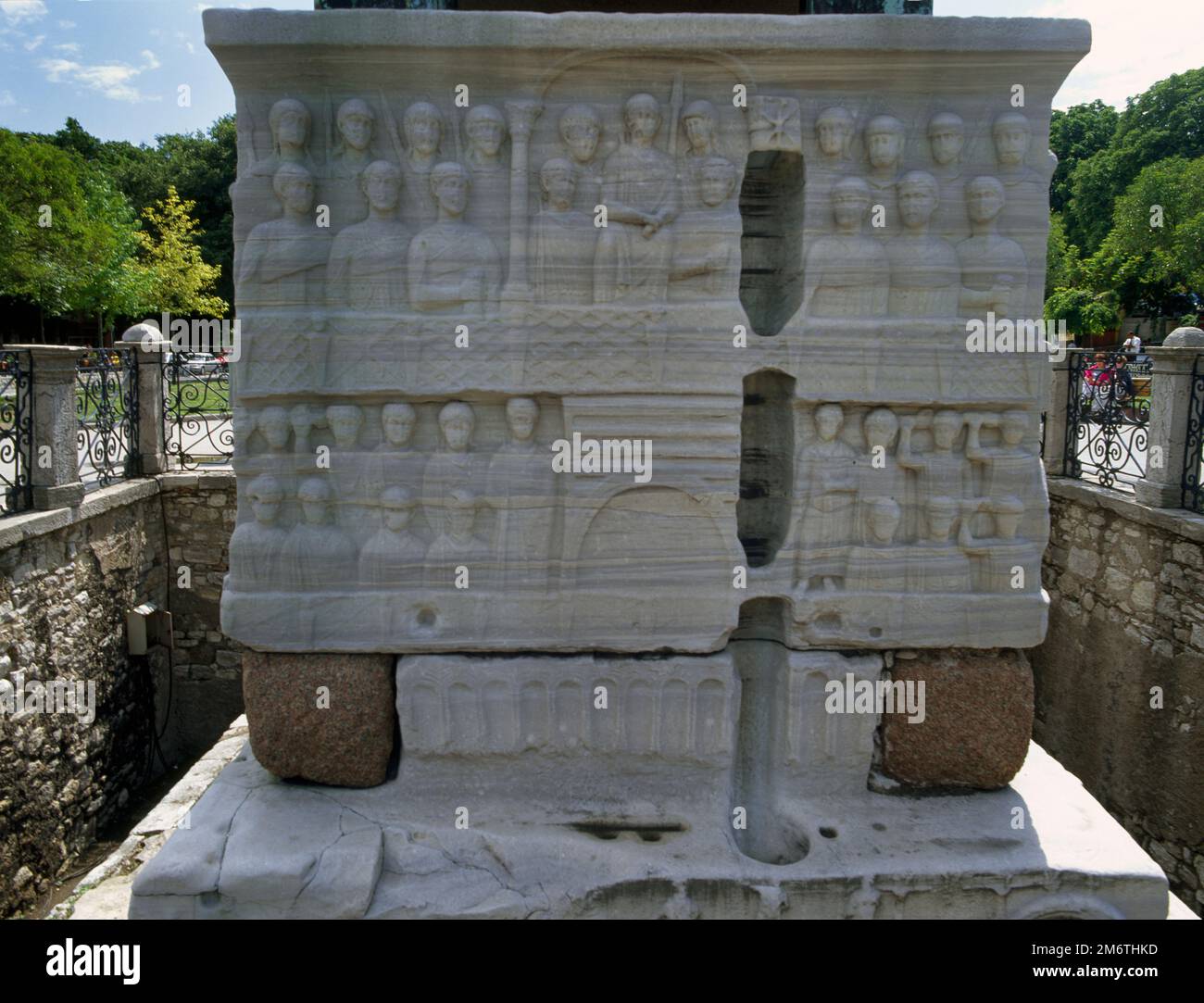 Istanbul Turkey Meydani (Hippodrome of Constantinople) Bas-Relief of the Emperor Theodosius I and His Court with Vertical Gash the Porphyry Cubes use Stock Photohttps://www.alamy.com/image-license-details/?v=1https://www.alamy.com/istanbul-turkey-meydani-hippodrome-of-constantinople-bas-relief-of-the-emperor-theodosius-i-and-his-court-with-vertical-gash-the-porphyry-cubes-use-image503329329.html
Istanbul Turkey Meydani (Hippodrome of Constantinople) Bas-Relief of the Emperor Theodosius I and His Court with Vertical Gash the Porphyry Cubes use Stock Photohttps://www.alamy.com/image-license-details/?v=1https://www.alamy.com/istanbul-turkey-meydani-hippodrome-of-constantinople-bas-relief-of-the-emperor-theodosius-i-and-his-court-with-vertical-gash-the-porphyry-cubes-use-image503329329.htmlRM2M6THKD–Istanbul Turkey Meydani (Hippodrome of Constantinople) Bas-Relief of the Emperor Theodosius I and His Court with Vertical Gash the Porphyry Cubes use
 Solidus of Theodosius I the Great , AD 383-88. Byzantium, Constantinople, Byzantine period, 4th century. Gold; diameter: 2.1 cm (13/16 in.). Byzantine Gold Coins The vast number of surviving Byzantine coins attests to the level of trade across the empire. Controlled and supervised by the emperor, the producers of coins took care to represent his authority and reflect his stature. Talented artists were recruited to engrave the dies (molds) used for the striking of coins. Emperors increasingly came to include their heirs and co-emperors on their coinage, as well as other family members or even Stock Photohttps://www.alamy.com/image-license-details/?v=1https://www.alamy.com/solidus-of-theodosius-i-the-great-ad-383-88-byzantium-constantinople-byzantine-period-4th-century-gold-diameter-21-cm-1316-in-byzantine-gold-coins-the-vast-number-of-surviving-byzantine-coins-attests-to-the-level-of-trade-across-the-empire-controlled-and-supervised-by-the-emperor-the-producers-of-coins-took-care-to-represent-his-authority-and-reflect-his-stature-talented-artists-were-recruited-to-engrave-the-dies-molds-used-for-the-striking-of-coins-emperors-increasingly-came-to-include-their-heirs-and-co-emperors-on-their-coinage-as-well-as-other-family-members-or-even-image448061193.html
Solidus of Theodosius I the Great , AD 383-88. Byzantium, Constantinople, Byzantine period, 4th century. Gold; diameter: 2.1 cm (13/16 in.). Byzantine Gold Coins The vast number of surviving Byzantine coins attests to the level of trade across the empire. Controlled and supervised by the emperor, the producers of coins took care to represent his authority and reflect his stature. Talented artists were recruited to engrave the dies (molds) used for the striking of coins. Emperors increasingly came to include their heirs and co-emperors on their coinage, as well as other family members or even Stock Photohttps://www.alamy.com/image-license-details/?v=1https://www.alamy.com/solidus-of-theodosius-i-the-great-ad-383-88-byzantium-constantinople-byzantine-period-4th-century-gold-diameter-21-cm-1316-in-byzantine-gold-coins-the-vast-number-of-surviving-byzantine-coins-attests-to-the-level-of-trade-across-the-empire-controlled-and-supervised-by-the-emperor-the-producers-of-coins-took-care-to-represent-his-authority-and-reflect-his-stature-talented-artists-were-recruited-to-engrave-the-dies-molds-used-for-the-striking-of-coins-emperors-increasingly-came-to-include-their-heirs-and-co-emperors-on-their-coinage-as-well-as-other-family-members-or-even-image448061193.htmlRM2H0XXHD–Solidus of Theodosius I the Great , AD 383-88. Byzantium, Constantinople, Byzantine period, 4th century. Gold; diameter: 2.1 cm (13/16 in.). Byzantine Gold Coins The vast number of surviving Byzantine coins attests to the level of trade across the empire. Controlled and supervised by the emperor, the producers of coins took care to represent his authority and reflect his stature. Talented artists were recruited to engrave the dies (molds) used for the striking of coins. Emperors increasingly came to include their heirs and co-emperors on their coinage, as well as other family members or even
 Istanbul Turkey Meydani (Hippodrome of Constantinople) Bas-Relief of the Emperor Theodosius I Offering Laurels of Victory to the Winner at Chariot Rac Stock Photohttps://www.alamy.com/image-license-details/?v=1https://www.alamy.com/stock-photo-istanbul-turkey-meydani-hippodrome-of-constantinople-bas-relief-of-10275478.html
Istanbul Turkey Meydani (Hippodrome of Constantinople) Bas-Relief of the Emperor Theodosius I Offering Laurels of Victory to the Winner at Chariot Rac Stock Photohttps://www.alamy.com/image-license-details/?v=1https://www.alamy.com/stock-photo-istanbul-turkey-meydani-hippodrome-of-constantinople-bas-relief-of-10275478.htmlRMA1JTCR–Istanbul Turkey Meydani (Hippodrome of Constantinople) Bas-Relief of the Emperor Theodosius I Offering Laurels of Victory to the Winner at Chariot Rac
 'The 'At-Meidan' - Ancient Hippodrome - With Column of Theodosius, Constantinople', 1890. Creator: Unknown. Stock Photohttps://www.alamy.com/image-license-details/?v=1https://www.alamy.com/the-at-meidan-ancient-hippodrome-with-column-of-theodosius-constantinople-1890-creator-unknown-image259689015.html
'The 'At-Meidan' - Ancient Hippodrome - With Column of Theodosius, Constantinople', 1890. Creator: Unknown. Stock Photohttps://www.alamy.com/image-license-details/?v=1https://www.alamy.com/the-at-meidan-ancient-hippodrome-with-column-of-theodosius-constantinople-1890-creator-unknown-image259689015.htmlRMW2DRYK–'The 'At-Meidan' - Ancient Hippodrome - With Column of Theodosius, Constantinople', 1890. Creator: Unknown.
 Vintage 19th century photograph - The Obelisk of Theodosius is the Ancient Egyptian obelisk of Pharaoh Thutmose III re-erected in the Hippodrome of Constantinople by the Roman emperor Theodosius I in the 4th century AD. Stock Photohttps://www.alamy.com/image-license-details/?v=1https://www.alamy.com/vintage-19th-century-photograph-the-obelisk-of-theodosius-is-the-ancient-egyptian-obelisk-of-pharaoh-thutmose-iii-re-erected-in-the-hippodrome-of-constantinople-by-the-roman-emperor-theodosius-i-in-the-4th-century-ad-image485670675.html
Vintage 19th century photograph - The Obelisk of Theodosius is the Ancient Egyptian obelisk of Pharaoh Thutmose III re-erected in the Hippodrome of Constantinople by the Roman emperor Theodosius I in the 4th century AD. Stock Photohttps://www.alamy.com/image-license-details/?v=1https://www.alamy.com/vintage-19th-century-photograph-the-obelisk-of-theodosius-is-the-ancient-egyptian-obelisk-of-pharaoh-thutmose-iii-re-erected-in-the-hippodrome-of-constantinople-by-the-roman-emperor-theodosius-i-in-the-4th-century-ad-image485670675.htmlRM2K645W7–Vintage 19th century photograph - The Obelisk of Theodosius is the Ancient Egyptian obelisk of Pharaoh Thutmose III re-erected in the Hippodrome of Constantinople by the Roman emperor Theodosius I in the 4th century AD.
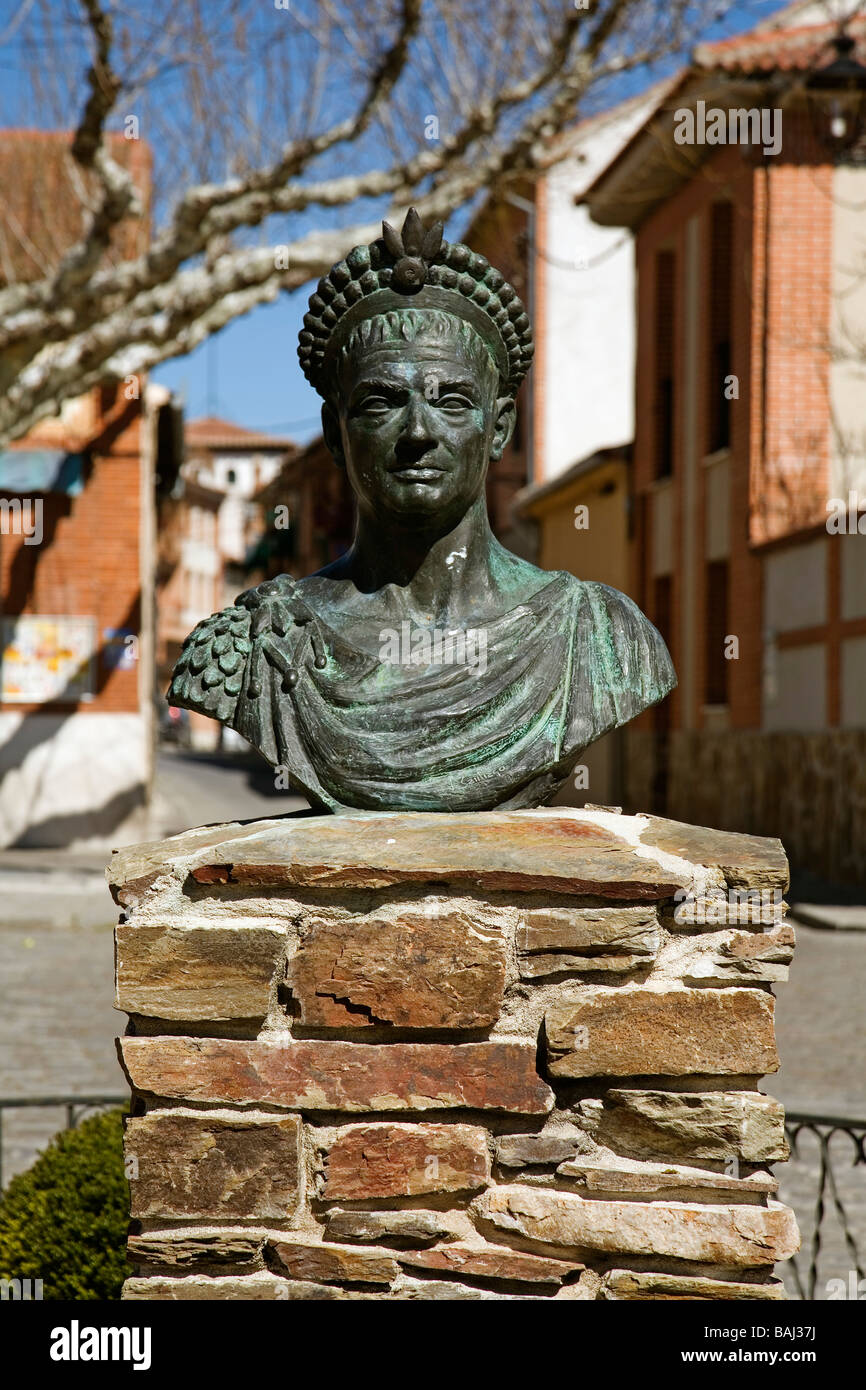 Bust of Roman Emperor Theodosius the Great in Coca Segovia Castilla Leon Spain Stock Photohttps://www.alamy.com/image-license-details/?v=1https://www.alamy.com/stock-photo-bust-of-roman-emperor-theodosius-the-great-in-coca-segovia-castilla-23754630.html
Bust of Roman Emperor Theodosius the Great in Coca Segovia Castilla Leon Spain Stock Photohttps://www.alamy.com/image-license-details/?v=1https://www.alamy.com/stock-photo-bust-of-roman-emperor-theodosius-the-great-in-coca-segovia-castilla-23754630.htmlRMBAJ37J–Bust of Roman Emperor Theodosius the Great in Coca Segovia Castilla Leon Spain
 Great Chronicles of France. The landing of Greek soldiers from Troy. The founding of Sicambria by Francion. Victory of the Franks over Emperor Theodosius I 1375-1379 France Paris. Bibliothèque Nationale Stock Photohttps://www.alamy.com/image-license-details/?v=1https://www.alamy.com/stock-photo-great-chronicles-of-france-the-landing-of-greek-soldiers-from-troy-113149967.html
Great Chronicles of France. The landing of Greek soldiers from Troy. The founding of Sicambria by Francion. Victory of the Franks over Emperor Theodosius I 1375-1379 France Paris. Bibliothèque Nationale Stock Photohttps://www.alamy.com/image-license-details/?v=1https://www.alamy.com/stock-photo-great-chronicles-of-france-the-landing-of-greek-soldiers-from-troy-113149967.htmlRMGG2BX7–Great Chronicles of France. The landing of Greek soldiers from Troy. The founding of Sicambria by Francion. Victory of the Franks over Emperor Theodosius I 1375-1379 France Paris. Bibliothèque Nationale
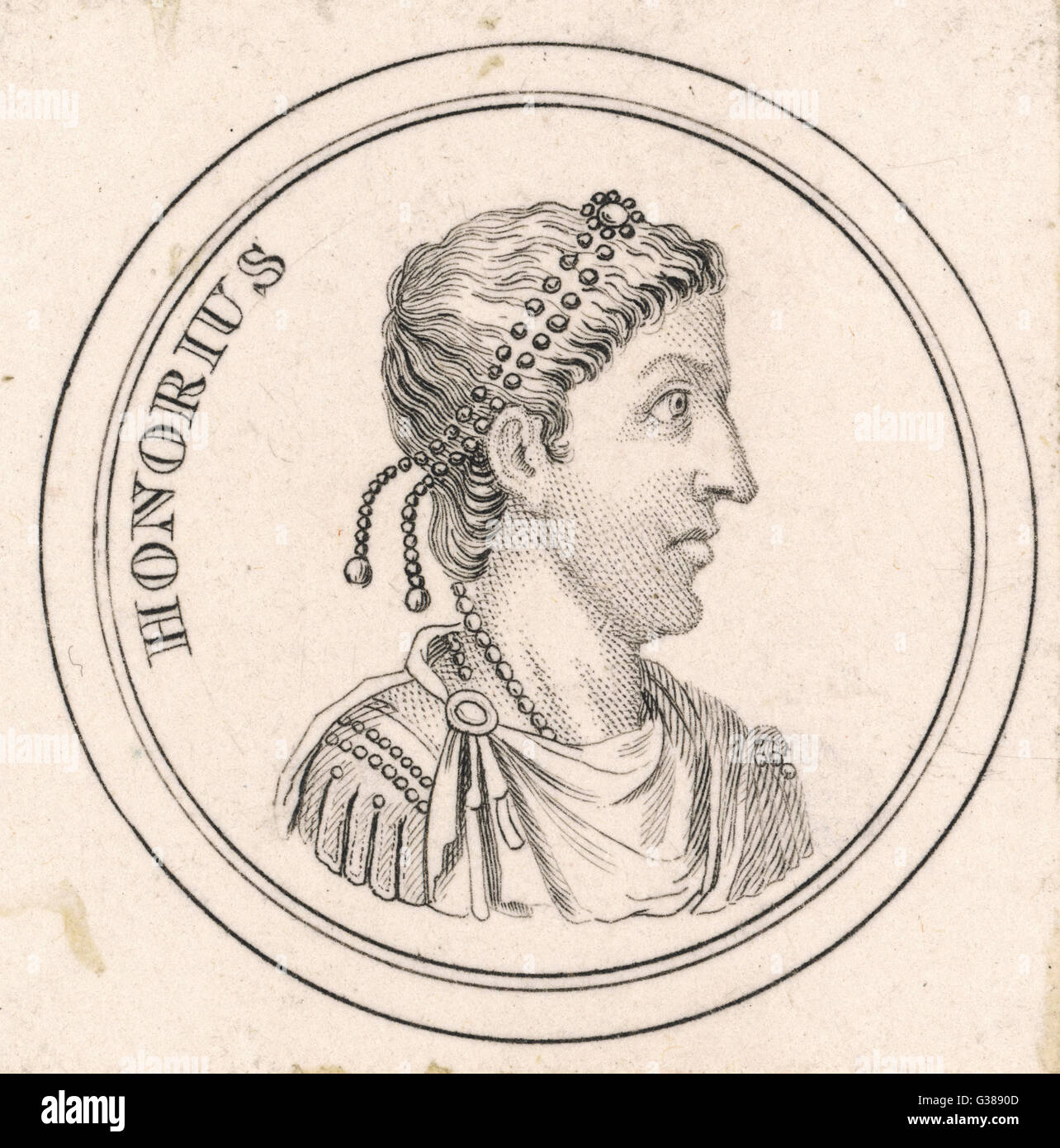 EMPEROR HONORIUS Roman Emperor of the West son of Theodosius I Date: 384 - 42 Stock Photohttps://www.alamy.com/image-license-details/?v=1https://www.alamy.com/stock-photo-emperor-honorius-roman-emperor-of-the-west-son-of-theodosius-i-date-105288861.html
EMPEROR HONORIUS Roman Emperor of the West son of Theodosius I Date: 384 - 42 Stock Photohttps://www.alamy.com/image-license-details/?v=1https://www.alamy.com/stock-photo-emperor-honorius-roman-emperor-of-the-west-son-of-theodosius-i-date-105288861.htmlRMG3890D–EMPEROR HONORIUS Roman Emperor of the West son of Theodosius I Date: 384 - 42
 Marble Column raised be Arcadius, at Constantinople, in honor of his Father, Theodosis the Great, Illustration from John Cassell's Illustrated History of England, Vol. I from the earliest period to the reign of Edward the Fourth, Cassell, Petter and Galpin, 1857 Stock Photohttps://www.alamy.com/image-license-details/?v=1https://www.alamy.com/marble-column-raised-be-arcadius-at-constantinople-in-honor-of-his-father-theodosis-the-great-illustration-from-john-cassells-illustrated-history-of-england-vol-i-from-the-earliest-period-to-the-reign-of-edward-the-fourth-cassell-petter-and-galpin-1857-image255370929.html
Marble Column raised be Arcadius, at Constantinople, in honor of his Father, Theodosis the Great, Illustration from John Cassell's Illustrated History of England, Vol. I from the earliest period to the reign of Edward the Fourth, Cassell, Petter and Galpin, 1857 Stock Photohttps://www.alamy.com/image-license-details/?v=1https://www.alamy.com/marble-column-raised-be-arcadius-at-constantinople-in-honor-of-his-father-theodosis-the-great-illustration-from-john-cassells-illustrated-history-of-england-vol-i-from-the-earliest-period-to-the-reign-of-edward-the-fourth-cassell-petter-and-galpin-1857-image255370929.htmlRMTRD469–Marble Column raised be Arcadius, at Constantinople, in honor of his Father, Theodosis the Great, Illustration from John Cassell's Illustrated History of England, Vol. I from the earliest period to the reign of Edward the Fourth, Cassell, Petter and Galpin, 1857
 Theodosius I (347-395), also known as Theodosius the Great, was born into a military family in Hispania. He served with his father until his execution in 374 CE, after which Theodosius retired to Hispania until he was given the position of co-emperor by Emperor Gratian after Emperor Valens' death in 378 CE. Theodosius ruled the East Roman Empire, and after Gratian himself was killed in 383 CE, appointed his son Arcadius as his co-ruler in the east while briefly acknowledging the usurper Magnus Maximus before agreeing to a marriage with Emperor Valentinian II's sister Galla and defeating Maxim Stock Photohttps://www.alamy.com/image-license-details/?v=1https://www.alamy.com/theodosius-i-347-395-also-known-as-theodosius-the-great-was-born-into-a-military-family-in-hispania-he-served-with-his-father-until-his-execution-in-374-ce-after-which-theodosius-retired-to-hispania-until-he-was-given-the-position-of-co-emperor-by-emperor-gratian-after-emperor-valens-death-in-378-ce-theodosius-ruled-the-east-roman-empire-and-after-gratian-himself-was-killed-in-383-ce-appointed-his-son-arcadius-as-his-co-ruler-in-the-east-while-briefly-acknowledging-the-usurper-magnus-maximus-before-agreeing-to-a-marriage-with-emperor-valentinian-iis-sister-galla-and-defeating-maxim-image344279380.html
Theodosius I (347-395), also known as Theodosius the Great, was born into a military family in Hispania. He served with his father until his execution in 374 CE, after which Theodosius retired to Hispania until he was given the position of co-emperor by Emperor Gratian after Emperor Valens' death in 378 CE. Theodosius ruled the East Roman Empire, and after Gratian himself was killed in 383 CE, appointed his son Arcadius as his co-ruler in the east while briefly acknowledging the usurper Magnus Maximus before agreeing to a marriage with Emperor Valentinian II's sister Galla and defeating Maxim Stock Photohttps://www.alamy.com/image-license-details/?v=1https://www.alamy.com/theodosius-i-347-395-also-known-as-theodosius-the-great-was-born-into-a-military-family-in-hispania-he-served-with-his-father-until-his-execution-in-374-ce-after-which-theodosius-retired-to-hispania-until-he-was-given-the-position-of-co-emperor-by-emperor-gratian-after-emperor-valens-death-in-378-ce-theodosius-ruled-the-east-roman-empire-and-after-gratian-himself-was-killed-in-383-ce-appointed-his-son-arcadius-as-his-co-ruler-in-the-east-while-briefly-acknowledging-the-usurper-magnus-maximus-before-agreeing-to-a-marriage-with-emperor-valentinian-iis-sister-galla-and-defeating-maxim-image344279380.htmlRM2B037T4–Theodosius I (347-395), also known as Theodosius the Great, was born into a military family in Hispania. He served with his father until his execution in 374 CE, after which Theodosius retired to Hispania until he was given the position of co-emperor by Emperor Gratian after Emperor Valens' death in 378 CE. Theodosius ruled the East Roman Empire, and after Gratian himself was killed in 383 CE, appointed his son Arcadius as his co-ruler in the east while briefly acknowledging the usurper Magnus Maximus before agreeing to a marriage with Emperor Valentinian II's sister Galla and defeating Maxim
 The figures represented here are two Byzantines Theodosius in 379 and his consort Aelia Flacilia. Stock Photohttps://www.alamy.com/image-license-details/?v=1https://www.alamy.com/the-figures-represented-here-are-two-byzantines-theodosius-in-379-image66496278.html
The figures represented here are two Byzantines Theodosius in 379 and his consort Aelia Flacilia. Stock Photohttps://www.alamy.com/image-license-details/?v=1https://www.alamy.com/the-figures-represented-here-are-two-byzantines-theodosius-in-379-image66496278.htmlRMDT54K2–The figures represented here are two Byzantines Theodosius in 379 and his consort Aelia Flacilia.
 Theodosius I (347-395), also known as Theodosius the Great, was born into a military family in Hispania. He served with his father until his execution in 374 CE, after which Theodosius retired to Hispania until he was given the position of co-emperor by Emperor Gratian after Emperor Valens' death in 378 CE. Theodosius ruled the East Roman Empire, and after Gratian himself was killed in 383 CE, appointed his son Arcadius as his co-ruler in the east while briefly acknowledging the usurper Magnus Maximus before agreeing to a marriage with Emperor Valentinian II's sister Galla and defeating Maxim Stock Photohttps://www.alamy.com/image-license-details/?v=1https://www.alamy.com/theodosius-i-347-395-also-known-as-theodosius-the-great-was-born-into-a-military-family-in-hispania-he-served-with-his-father-until-his-execution-in-374-ce-after-which-theodosius-retired-to-hispania-until-he-was-given-the-position-of-co-emperor-by-emperor-gratian-after-emperor-valens-death-in-378-ce-theodosius-ruled-the-east-roman-empire-and-after-gratian-himself-was-killed-in-383-ce-appointed-his-son-arcadius-as-his-co-ruler-in-the-east-while-briefly-acknowledging-the-usurper-magnus-maximus-before-agreeing-to-a-marriage-with-emperor-valentinian-iis-sister-galla-and-defeating-maxim-image344279394.html
Theodosius I (347-395), also known as Theodosius the Great, was born into a military family in Hispania. He served with his father until his execution in 374 CE, after which Theodosius retired to Hispania until he was given the position of co-emperor by Emperor Gratian after Emperor Valens' death in 378 CE. Theodosius ruled the East Roman Empire, and after Gratian himself was killed in 383 CE, appointed his son Arcadius as his co-ruler in the east while briefly acknowledging the usurper Magnus Maximus before agreeing to a marriage with Emperor Valentinian II's sister Galla and defeating Maxim Stock Photohttps://www.alamy.com/image-license-details/?v=1https://www.alamy.com/theodosius-i-347-395-also-known-as-theodosius-the-great-was-born-into-a-military-family-in-hispania-he-served-with-his-father-until-his-execution-in-374-ce-after-which-theodosius-retired-to-hispania-until-he-was-given-the-position-of-co-emperor-by-emperor-gratian-after-emperor-valens-death-in-378-ce-theodosius-ruled-the-east-roman-empire-and-after-gratian-himself-was-killed-in-383-ce-appointed-his-son-arcadius-as-his-co-ruler-in-the-east-while-briefly-acknowledging-the-usurper-magnus-maximus-before-agreeing-to-a-marriage-with-emperor-valentinian-iis-sister-galla-and-defeating-maxim-image344279394.htmlRM2B037TJ–Theodosius I (347-395), also known as Theodosius the Great, was born into a military family in Hispania. He served with his father until his execution in 374 CE, after which Theodosius retired to Hispania until he was given the position of co-emperor by Emperor Gratian after Emperor Valens' death in 378 CE. Theodosius ruled the East Roman Empire, and after Gratian himself was killed in 383 CE, appointed his son Arcadius as his co-ruler in the east while briefly acknowledging the usurper Magnus Maximus before agreeing to a marriage with Emperor Valentinian II's sister Galla and defeating Maxim
 Engraving depicting the triumphal procession of Emperor Theodosius I into Rome Stock Photohttps://www.alamy.com/image-license-details/?v=1https://www.alamy.com/stock-photo-engraving-depicting-the-triumphal-procession-of-emperor-theodosius-104149718.html
Engraving depicting the triumphal procession of Emperor Theodosius I into Rome Stock Photohttps://www.alamy.com/image-license-details/?v=1https://www.alamy.com/stock-photo-engraving-depicting-the-triumphal-procession-of-emperor-theodosius-104149718.htmlRMG1CC0P–Engraving depicting the triumphal procession of Emperor Theodosius I into Rome
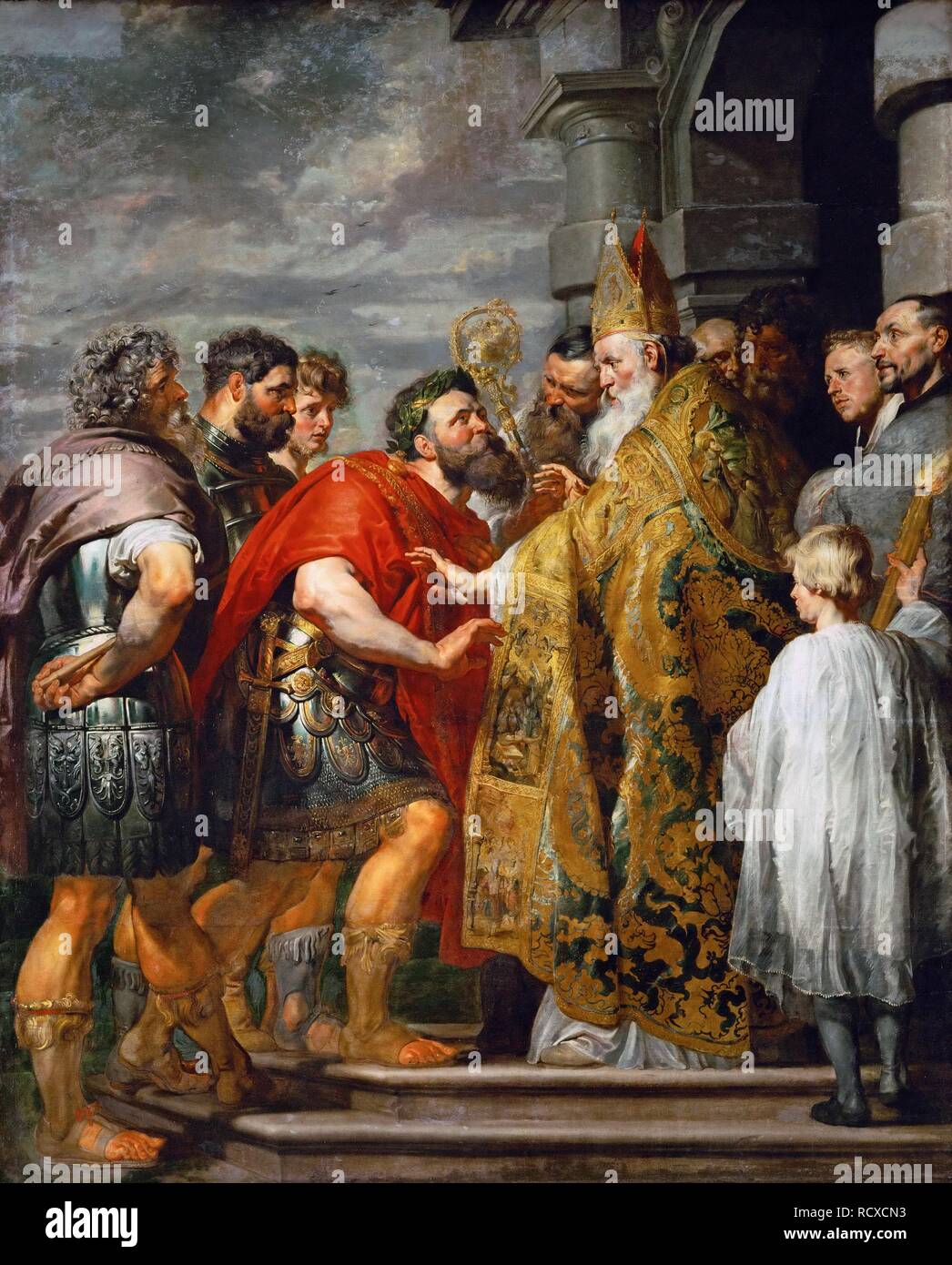 Saint Ambrose and Emperor Theodosius I. Museum: Art History Museum, Vienne. Author: Rubens, Pieter Paul. Stock Photohttps://www.alamy.com/image-license-details/?v=1https://www.alamy.com/saint-ambrose-and-emperor-theodosius-i-museum-art-history-museum-vienne-author-rubens-pieter-paul-image231691407.html
Saint Ambrose and Emperor Theodosius I. Museum: Art History Museum, Vienne. Author: Rubens, Pieter Paul. Stock Photohttps://www.alamy.com/image-license-details/?v=1https://www.alamy.com/saint-ambrose-and-emperor-theodosius-i-museum-art-history-museum-vienne-author-rubens-pieter-paul-image231691407.htmlRMRCXCN3–Saint Ambrose and Emperor Theodosius I. Museum: Art History Museum, Vienne. Author: Rubens, Pieter Paul.
 Anthony van Dyck (1599 –1641)Flemish painter. Ambrosius and Emperor Theodosius, 'Saint Ambrose forbids emperor Theodosius I to enter the church'. Stock Photohttps://www.alamy.com/image-license-details/?v=1https://www.alamy.com/stock-photo-anthony-van-dyck-1599-1641flemish-painter-ambrosius-and-emperor-theodosius-57350278.html
Anthony van Dyck (1599 –1641)Flemish painter. Ambrosius and Emperor Theodosius, 'Saint Ambrose forbids emperor Theodosius I to enter the church'. Stock Photohttps://www.alamy.com/image-license-details/?v=1https://www.alamy.com/stock-photo-anthony-van-dyck-1599-1641flemish-painter-ambrosius-and-emperor-theodosius-57350278.htmlRMD98ET6–Anthony van Dyck (1599 –1641)Flemish painter. Ambrosius and Emperor Theodosius, 'Saint Ambrose forbids emperor Theodosius I to enter the church'.
 The Netherlands Roman period, coin, AES-IV, Theodosius I, metal, copper, Diam., 12 mm, wt., 1.04 gr, roman 388-392, the Netherlands, Limburg, Roerdalen, Melick Stock Photohttps://www.alamy.com/image-license-details/?v=1https://www.alamy.com/the-netherlands-roman-period-coin-aes-iv-theodosius-i-metal-copper-diam-12-mm-wt-104-gr-roman-388-392-the-netherlands-limburg-roerdalen-melick-image344541159.html
The Netherlands Roman period, coin, AES-IV, Theodosius I, metal, copper, Diam., 12 mm, wt., 1.04 gr, roman 388-392, the Netherlands, Limburg, Roerdalen, Melick Stock Photohttps://www.alamy.com/image-license-details/?v=1https://www.alamy.com/the-netherlands-roman-period-coin-aes-iv-theodosius-i-metal-copper-diam-12-mm-wt-104-gr-roman-388-392-the-netherlands-limburg-roerdalen-melick-image344541159.htmlRM2B0F5NB–The Netherlands Roman period, coin, AES-IV, Theodosius I, metal, copper, Diam., 12 mm, wt., 1.04 gr, roman 388-392, the Netherlands, Limburg, Roerdalen, Melick
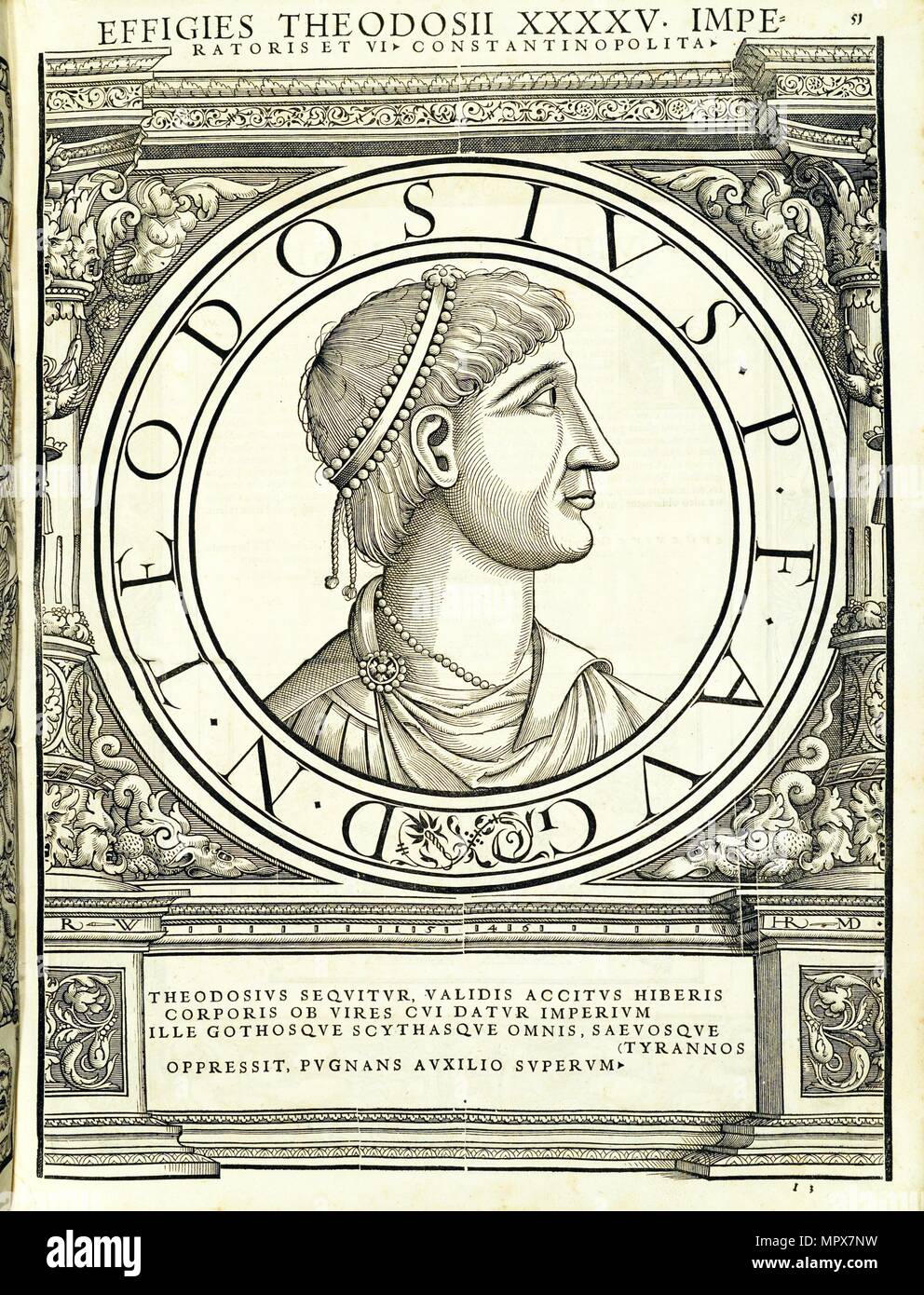 Theodosius I (347 - 395), 1559. Stock Photohttps://www.alamy.com/image-license-details/?v=1https://www.alamy.com/theodosius-i-347-395-1559-image186202965.html
Theodosius I (347 - 395), 1559. Stock Photohttps://www.alamy.com/image-license-details/?v=1https://www.alamy.com/theodosius-i-347-395-1559-image186202965.htmlRMMPX7NW–Theodosius I (347 - 395), 1559.
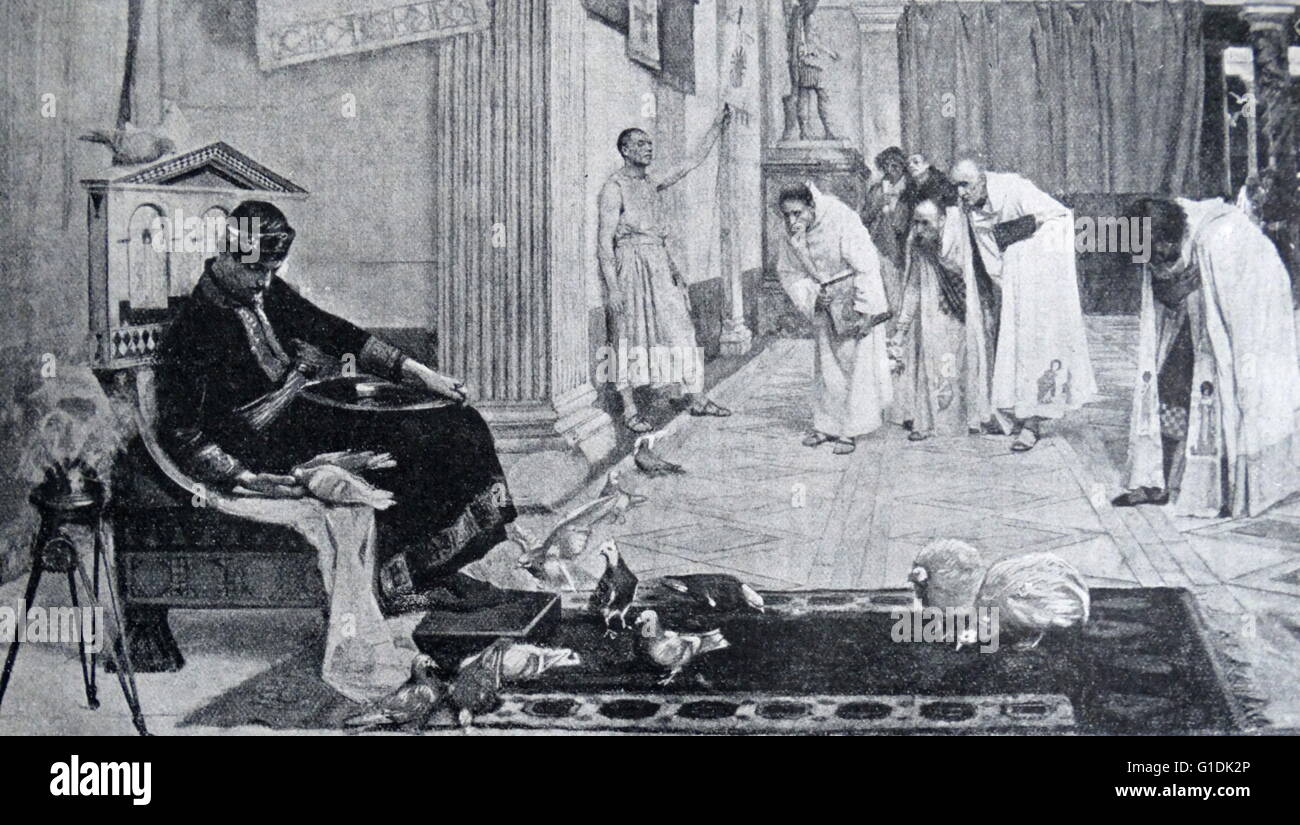 Painting depicting Emperor Honorius (384-423) the younger son of emperor Theodosius I and his first wife Aelia Flaccilla, and brother of Arcadius. Dated 5th Century Stock Photohttps://www.alamy.com/image-license-details/?v=1https://www.alamy.com/stock-photo-painting-depicting-emperor-honorius-384-423-the-younger-son-of-emperor-104177214.html
Painting depicting Emperor Honorius (384-423) the younger son of emperor Theodosius I and his first wife Aelia Flaccilla, and brother of Arcadius. Dated 5th Century Stock Photohttps://www.alamy.com/image-license-details/?v=1https://www.alamy.com/stock-photo-painting-depicting-emperor-honorius-384-423-the-younger-son-of-emperor-104177214.htmlRMG1DK2P–Painting depicting Emperor Honorius (384-423) the younger son of emperor Theodosius I and his first wife Aelia Flaccilla, and brother of Arcadius. Dated 5th Century
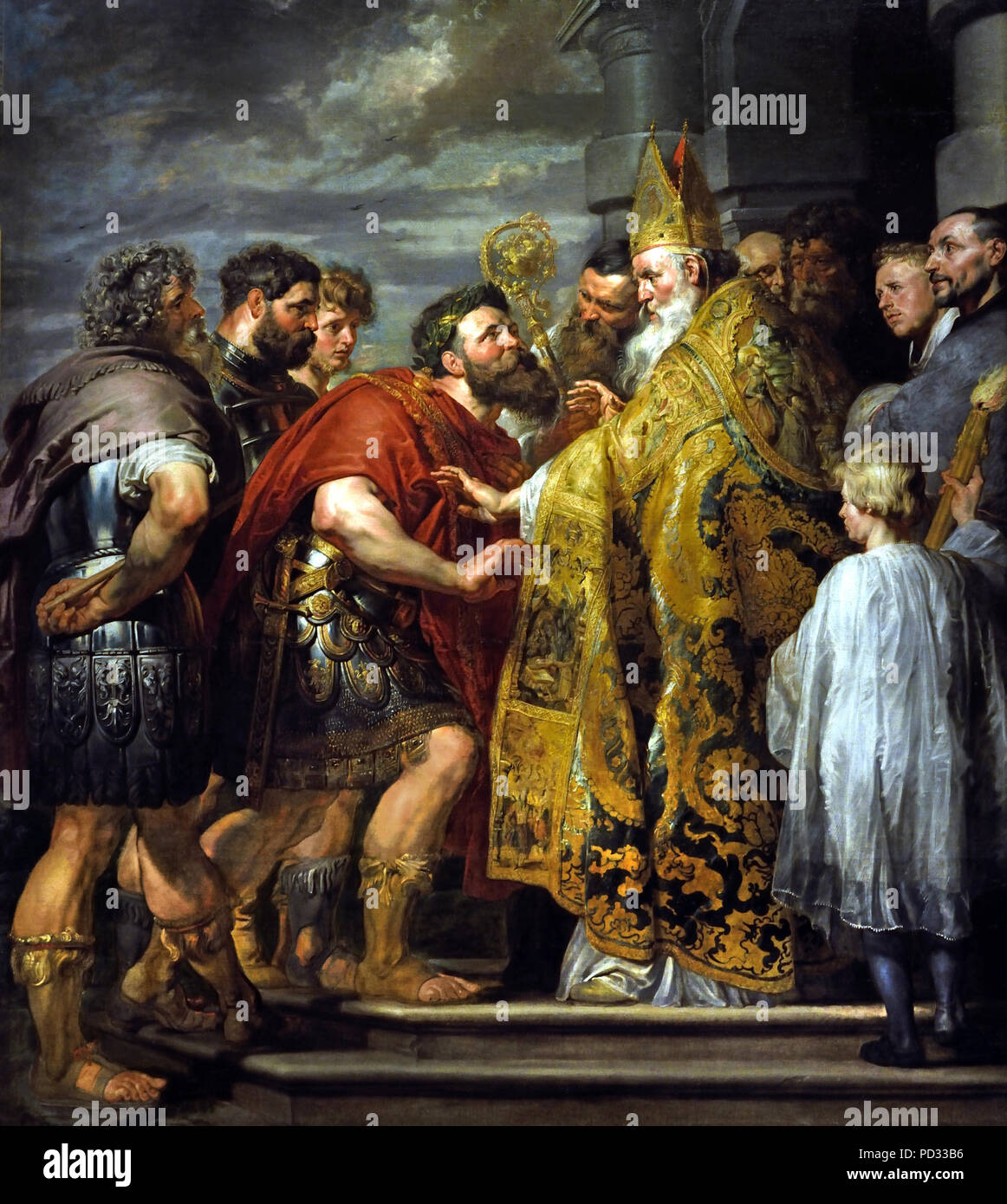 St Ambrose and Emperor Theodosius by Peter Paul Rubens (1577–1640) Flemish Belgian Belgium ( It shows the Roman emperor Theodosius I and his entourage being barred from Milan Cathedral by its archbishop saint Ambrose, as punishment for the Massacre of Thessalonica. ) Stock Photohttps://www.alamy.com/image-license-details/?v=1https://www.alamy.com/st-ambrose-and-emperor-theodosius-by-peter-paul-rubens-15771640-flemish-belgian-belgium-it-shows-the-roman-emperor-theodosius-i-and-his-entourage-being-barred-from-milan-cathedral-by-its-archbishop-saint-ambrose-as-punishment-for-the-massacre-of-thessalonica-image214583466.html
St Ambrose and Emperor Theodosius by Peter Paul Rubens (1577–1640) Flemish Belgian Belgium ( It shows the Roman emperor Theodosius I and his entourage being barred from Milan Cathedral by its archbishop saint Ambrose, as punishment for the Massacre of Thessalonica. ) Stock Photohttps://www.alamy.com/image-license-details/?v=1https://www.alamy.com/st-ambrose-and-emperor-theodosius-by-peter-paul-rubens-15771640-flemish-belgian-belgium-it-shows-the-roman-emperor-theodosius-i-and-his-entourage-being-barred-from-milan-cathedral-by-its-archbishop-saint-ambrose-as-punishment-for-the-massacre-of-thessalonica-image214583466.htmlRMPD33B6–St Ambrose and Emperor Theodosius by Peter Paul Rubens (1577–1640) Flemish Belgian Belgium ( It shows the Roman emperor Theodosius I and his entourage being barred from Milan Cathedral by its archbishop saint Ambrose, as punishment for the Massacre of Thessalonica. )
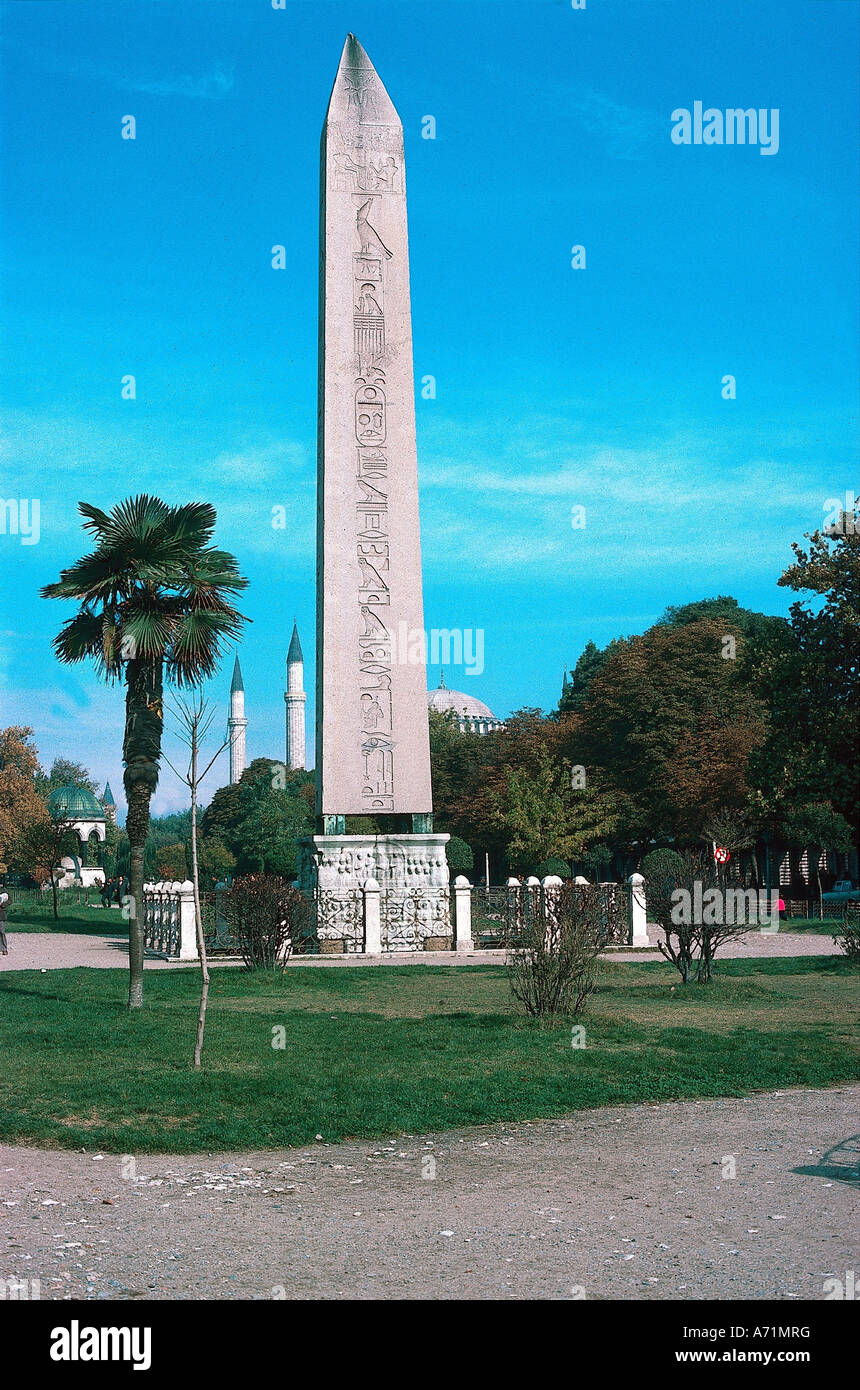 geography / travel, Turkey, Istanbul, monuments, obelisk of emperor Theodosius I. (reigned 379 - 395 AD), field of the former hippodrome of Constantinople, Egyptian obelisk from Heliopolis, made under pharaoh Thutmosis III. around 1500 BC, brougt to Constantinople by emperor Julianus Apostata (reigned 361 - 363 AD), turn brand of the horse race track, column, hieroglyphs, antiquity, Byzantine empire, Byzantium, fine arts, relief, park, UNESCO, World Heritage Site, historical, historic, ancient, Julian, Thutmose, , Stock Photohttps://www.alamy.com/image-license-details/?v=1https://www.alamy.com/stock-photo-geography-travel-turkey-istanbul-monuments-obelisk-of-emperor-theodosius-11694867.html
geography / travel, Turkey, Istanbul, monuments, obelisk of emperor Theodosius I. (reigned 379 - 395 AD), field of the former hippodrome of Constantinople, Egyptian obelisk from Heliopolis, made under pharaoh Thutmosis III. around 1500 BC, brougt to Constantinople by emperor Julianus Apostata (reigned 361 - 363 AD), turn brand of the horse race track, column, hieroglyphs, antiquity, Byzantine empire, Byzantium, fine arts, relief, park, UNESCO, World Heritage Site, historical, historic, ancient, Julian, Thutmose, , Stock Photohttps://www.alamy.com/image-license-details/?v=1https://www.alamy.com/stock-photo-geography-travel-turkey-istanbul-monuments-obelisk-of-emperor-theodosius-11694867.htmlRMA71MRG–geography / travel, Turkey, Istanbul, monuments, obelisk of emperor Theodosius I. (reigned 379 - 395 AD), field of the former hippodrome of Constantinople, Egyptian obelisk from Heliopolis, made under pharaoh Thutmosis III. around 1500 BC, brougt to Constantinople by emperor Julianus Apostata (reigned 361 - 363 AD), turn brand of the horse race track, column, hieroglyphs, antiquity, Byzantine empire, Byzantium, fine arts, relief, park, UNESCO, World Heritage Site, historical, historic, ancient, Julian, Thutmose, ,
 Aurelius Ambrosius or Saint Ambrose, bishop of Milan, barring emperor Theodosius I. from Milan Cathedral Stock Photohttps://www.alamy.com/image-license-details/?v=1https://www.alamy.com/stock-photo-aurelius-ambrosius-or-saint-ambrose-bishop-of-milan-barring-emperor-113615280.html
Aurelius Ambrosius or Saint Ambrose, bishop of Milan, barring emperor Theodosius I. from Milan Cathedral Stock Photohttps://www.alamy.com/image-license-details/?v=1https://www.alamy.com/stock-photo-aurelius-ambrosius-or-saint-ambrose-bishop-of-milan-barring-emperor-113615280.htmlRMGGRHCG–Aurelius Ambrosius or Saint Ambrose, bishop of Milan, barring emperor Theodosius I. from Milan Cathedral
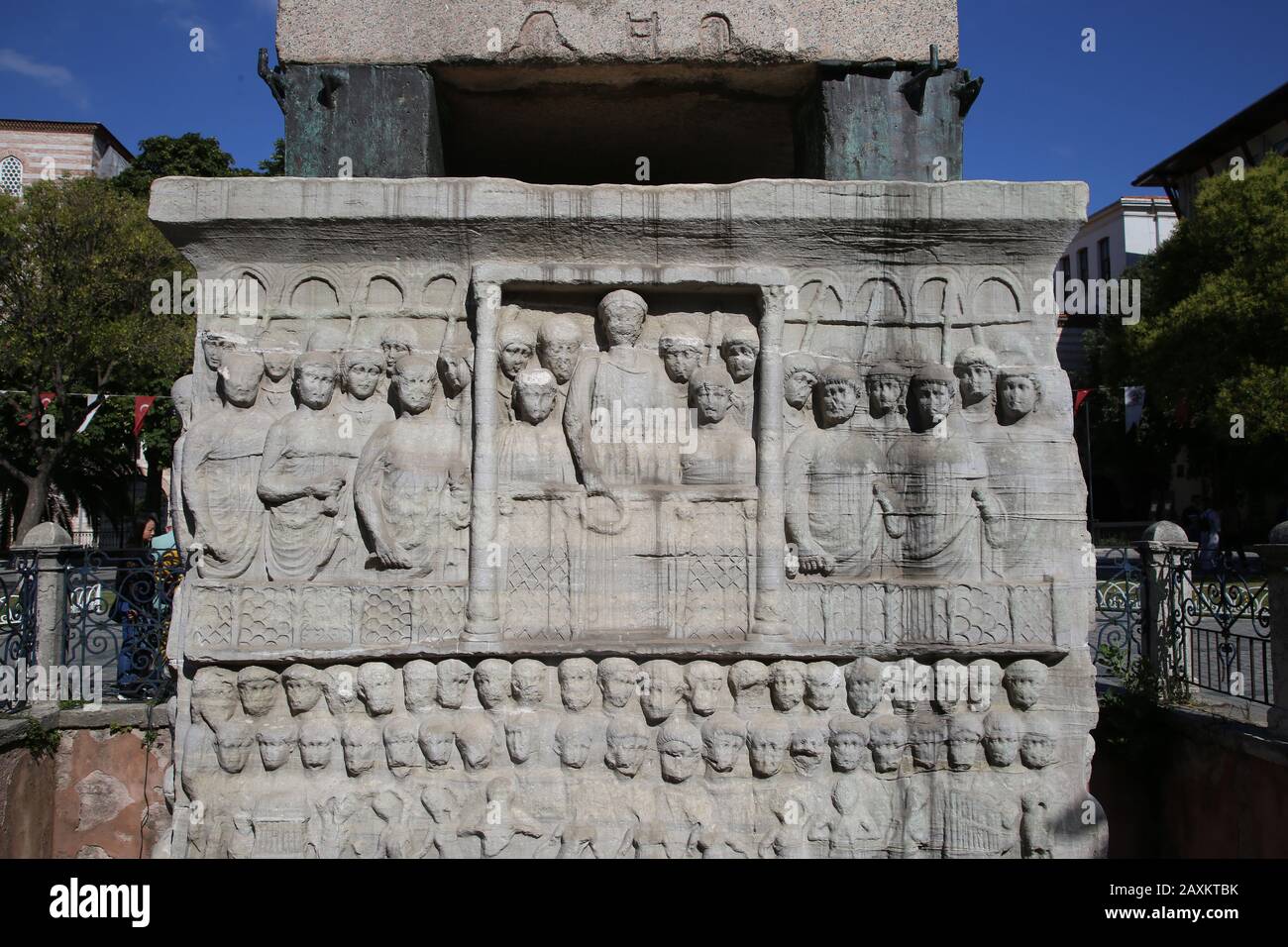 Turkey. Istanbul. Theodosius Obelisk. Pedestal. Emperor offering laurel of victory. 4th c. Hippodrome. Stock Photohttps://www.alamy.com/image-license-details/?v=1https://www.alamy.com/turkey-istanbul-theodosius-obelisk-pedestal-emperor-offering-laurel-of-victory-4th-c-hippodrome-image343414279.html
Turkey. Istanbul. Theodosius Obelisk. Pedestal. Emperor offering laurel of victory. 4th c. Hippodrome. Stock Photohttps://www.alamy.com/image-license-details/?v=1https://www.alamy.com/turkey-istanbul-theodosius-obelisk-pedestal-emperor-offering-laurel-of-victory-4th-c-hippodrome-image343414279.htmlRM2AXKTBK–Turkey. Istanbul. Theodosius Obelisk. Pedestal. Emperor offering laurel of victory. 4th c. Hippodrome.
 Aelia Galla Placidia (388 - 450), daughter of the Roman emperor Theodosius I, wearing ancient roman costume, History of fashion, costume story Stock Photohttps://www.alamy.com/image-license-details/?v=1https://www.alamy.com/stock-photo-aelia-galla-placidia-388-450-daughter-of-the-roman-emperor-theodosius-125634669.html
Aelia Galla Placidia (388 - 450), daughter of the Roman emperor Theodosius I, wearing ancient roman costume, History of fashion, costume story Stock Photohttps://www.alamy.com/image-license-details/?v=1https://www.alamy.com/stock-photo-aelia-galla-placidia-388-450-daughter-of-the-roman-emperor-theodosius-125634669.htmlRFH8B48D–Aelia Galla Placidia (388 - 450), daughter of the Roman emperor Theodosius I, wearing ancient roman costume, History of fashion, costume story
 Theodosius I on horseback with sceptre. Theodosius the Great with sceptre, plumed helmet and caparisoned horse. From a column in Istanbul built after his victory over Magnus Maximus. Porta Aurea. Handcoloured copperplate engraving by Giovanni Antonio Sasso from Giulio Ferrario’s Costumes Ancient and Modern of the Peoples of the World, Il Costume Antico e Moderno, Florence, 1842. Stock Photohttps://www.alamy.com/image-license-details/?v=1https://www.alamy.com/theodosius-i-on-horseback-with-sceptre-theodosius-the-great-with-sceptre-plumed-helmet-and-caparisoned-horse-from-a-column-in-istanbul-built-after-his-victory-over-magnus-maximus-porta-aurea-handcoloured-copperplate-engraving-by-giovanni-antonio-sasso-from-giulio-ferrarios-costumes-ancient-and-modern-of-the-peoples-of-the-world-il-costume-antico-e-moderno-florence-1842-image343575087.html
Theodosius I on horseback with sceptre. Theodosius the Great with sceptre, plumed helmet and caparisoned horse. From a column in Istanbul built after his victory over Magnus Maximus. Porta Aurea. Handcoloured copperplate engraving by Giovanni Antonio Sasso from Giulio Ferrario’s Costumes Ancient and Modern of the Peoples of the World, Il Costume Antico e Moderno, Florence, 1842. Stock Photohttps://www.alamy.com/image-license-details/?v=1https://www.alamy.com/theodosius-i-on-horseback-with-sceptre-theodosius-the-great-with-sceptre-plumed-helmet-and-caparisoned-horse-from-a-column-in-istanbul-built-after-his-victory-over-magnus-maximus-porta-aurea-handcoloured-copperplate-engraving-by-giovanni-antonio-sasso-from-giulio-ferrarios-costumes-ancient-and-modern-of-the-peoples-of-the-world-il-costume-antico-e-moderno-florence-1842-image343575087.htmlRM2AXY5ER–Theodosius I on horseback with sceptre. Theodosius the Great with sceptre, plumed helmet and caparisoned horse. From a column in Istanbul built after his victory over Magnus Maximus. Porta Aurea. Handcoloured copperplate engraving by Giovanni Antonio Sasso from Giulio Ferrario’s Costumes Ancient and Modern of the Peoples of the World, Il Costume Antico e Moderno, Florence, 1842.
 Galla Placida and her son Valentinian III, Aelia Galla Placida, 388 -. 450 on November 27, a daughter of the Roman Emperor Theodosius I, granddaughter of Valentinian I., mother of the future emperor Valentinian III. and as such a number of years de facto ruler of the Western Roman Empire / Galla Placida und ihr Sohn Valentinian III., Aelia Galla Placidia, 388 - 27. November 450, eine Tochter des roemischen Kaisers Theodosius I., Enkelin von Valentinian I., Mutter des spaeteren Kaisers Valentinian III. und als solche einige Jahre lang faktische Regentin des Westroemischen Reiches, Historisch, Stock Photohttps://www.alamy.com/image-license-details/?v=1https://www.alamy.com/galla-placida-and-her-son-valentinian-iii-aelia-galla-placida-388-450-on-november-27-a-daughter-of-the-roman-emperor-theodosius-i-granddaughter-of-valentinian-i-mother-of-the-future-emperor-valentinian-iii-and-as-such-a-number-of-years-de-facto-ruler-of-the-western-roman-empire-galla-placida-und-ihr-sohn-valentinian-iii-aelia-galla-placidia-388-27-november-450-eine-tochter-des-roemischen-kaisers-theodosius-i-enkelin-von-valentinian-i-mutter-des-spaeteren-kaisers-valentinian-iii-und-als-solche-einige-jahre-lang-faktische-regentin-des-westroemischen-reiches-historisch-image367918935.html
Galla Placida and her son Valentinian III, Aelia Galla Placida, 388 -. 450 on November 27, a daughter of the Roman Emperor Theodosius I, granddaughter of Valentinian I., mother of the future emperor Valentinian III. and as such a number of years de facto ruler of the Western Roman Empire / Galla Placida und ihr Sohn Valentinian III., Aelia Galla Placidia, 388 - 27. November 450, eine Tochter des roemischen Kaisers Theodosius I., Enkelin von Valentinian I., Mutter des spaeteren Kaisers Valentinian III. und als solche einige Jahre lang faktische Regentin des Westroemischen Reiches, Historisch, Stock Photohttps://www.alamy.com/image-license-details/?v=1https://www.alamy.com/galla-placida-and-her-son-valentinian-iii-aelia-galla-placida-388-450-on-november-27-a-daughter-of-the-roman-emperor-theodosius-i-granddaughter-of-valentinian-i-mother-of-the-future-emperor-valentinian-iii-and-as-such-a-number-of-years-de-facto-ruler-of-the-western-roman-empire-galla-placida-und-ihr-sohn-valentinian-iii-aelia-galla-placidia-388-27-november-450-eine-tochter-des-roemischen-kaisers-theodosius-i-enkelin-von-valentinian-i-mutter-des-spaeteren-kaisers-valentinian-iii-und-als-solche-einige-jahre-lang-faktische-regentin-des-westroemischen-reiches-historisch-image367918935.htmlRF2CAG49Y–Galla Placida and her son Valentinian III, Aelia Galla Placida, 388 -. 450 on November 27, a daughter of the Roman Emperor Theodosius I, granddaughter of Valentinian I., mother of the future emperor Valentinian III. and as such a number of years de facto ruler of the Western Roman Empire / Galla Placida und ihr Sohn Valentinian III., Aelia Galla Placidia, 388 - 27. November 450, eine Tochter des roemischen Kaisers Theodosius I., Enkelin von Valentinian I., Mutter des spaeteren Kaisers Valentinian III. und als solche einige Jahre lang faktische Regentin des Westroemischen Reiches, Historisch,
 9 Solidi, Theodosius I, emperor with ensigns, Aquileia, 378 383 AD Bode Museum DSC02732 Stock Photohttps://www.alamy.com/image-license-details/?v=1https://www.alamy.com/stock-photo-9-solidi-theodosius-i-emperor-with-ensigns-aquileia-378-383-ad-bode-142546378.html
9 Solidi, Theodosius I, emperor with ensigns, Aquileia, 378 383 AD Bode Museum DSC02732 Stock Photohttps://www.alamy.com/image-license-details/?v=1https://www.alamy.com/stock-photo-9-solidi-theodosius-i-emperor-with-ensigns-aquileia-378-383-ad-bode-142546378.htmlRMJ7WFA2–9 Solidi, Theodosius I, emperor with ensigns, Aquileia, 378 383 AD Bode Museum DSC02732
 Galla Placida and her son Valentinian III, Aelia Galla Placida, 388 -. 450 on November 27, a daughter of the Roman Emperor Theodosius I, granddaughter of Valentinian I., mother of the future emperor Valentinian III. and as such a number of years de facto ruler of the Western Roman Empire / Galla Placida und ihr Sohn Valentinian III., Aelia Galla Placidia, 388 - 27. November 450, eine Tochter des roemischen Kaisers Theodosius I., Enkelin von Valentinian I., Mutter des spaeteren Kaisers Valentinian III. und als solche einige Jahre lang faktische Regentin des Westroemischen Reiches, Historisch, Stock Photohttps://www.alamy.com/image-license-details/?v=1https://www.alamy.com/galla-placida-and-her-son-valentinian-iii-aelia-galla-placida-388-450-on-november-27-a-daughter-of-the-roman-emperor-theodosius-i-granddaughter-of-valentinian-i-mother-of-the-future-emperor-valentinian-iii-and-as-such-a-number-of-years-de-facto-ruler-of-the-western-roman-empire-galla-placida-und-ihr-sohn-valentinian-iii-aelia-galla-placidia-388-27-november-450-eine-tochter-des-roemischen-kaisers-theodosius-i-enkelin-von-valentinian-i-mutter-des-spaeteren-kaisers-valentinian-iii-und-als-solche-einige-jahre-lang-faktische-regentin-des-westroemischen-reiches-historisch-image433879734.html
Galla Placida and her son Valentinian III, Aelia Galla Placida, 388 -. 450 on November 27, a daughter of the Roman Emperor Theodosius I, granddaughter of Valentinian I., mother of the future emperor Valentinian III. and as such a number of years de facto ruler of the Western Roman Empire / Galla Placida und ihr Sohn Valentinian III., Aelia Galla Placidia, 388 - 27. November 450, eine Tochter des roemischen Kaisers Theodosius I., Enkelin von Valentinian I., Mutter des spaeteren Kaisers Valentinian III. und als solche einige Jahre lang faktische Regentin des Westroemischen Reiches, Historisch, Stock Photohttps://www.alamy.com/image-license-details/?v=1https://www.alamy.com/galla-placida-and-her-son-valentinian-iii-aelia-galla-placida-388-450-on-november-27-a-daughter-of-the-roman-emperor-theodosius-i-granddaughter-of-valentinian-i-mother-of-the-future-emperor-valentinian-iii-and-as-such-a-number-of-years-de-facto-ruler-of-the-western-roman-empire-galla-placida-und-ihr-sohn-valentinian-iii-aelia-galla-placidia-388-27-november-450-eine-tochter-des-roemischen-kaisers-theodosius-i-enkelin-von-valentinian-i-mutter-des-spaeteren-kaisers-valentinian-iii-und-als-solche-einige-jahre-lang-faktische-regentin-des-westroemischen-reiches-historisch-image433879734.htmlRF2G5TX0P–Galla Placida and her son Valentinian III, Aelia Galla Placida, 388 -. 450 on November 27, a daughter of the Roman Emperor Theodosius I, granddaughter of Valentinian I., mother of the future emperor Valentinian III. and as such a number of years de facto ruler of the Western Roman Empire / Galla Placida und ihr Sohn Valentinian III., Aelia Galla Placidia, 388 - 27. November 450, eine Tochter des roemischen Kaisers Theodosius I., Enkelin von Valentinian I., Mutter des spaeteren Kaisers Valentinian III. und als solche einige Jahre lang faktische Regentin des Westroemischen Reiches, Historisch,
 1252 Reliefs from the column of Theodosius I - Wheler George - 1682 Stock Photohttps://www.alamy.com/image-license-details/?v=1https://www.alamy.com/1252-reliefs-from-the-column-of-theodosius-i-wheler-george-1682-image213570792.html
1252 Reliefs from the column of Theodosius I - Wheler George - 1682 Stock Photohttps://www.alamy.com/image-license-details/?v=1https://www.alamy.com/1252-reliefs-from-the-column-of-theodosius-i-wheler-george-1682-image213570792.htmlRMPBCYM8–1252 Reliefs from the column of Theodosius I - Wheler George - 1682
 Triumphal of Theodosius on the former Theodosiusäule in Constantinople Opel, Turkey, Theodosius I Flavius ??Theodosius, January 11, 347 - 17 January 395, known Theodosius the Great Theodosius Magnus was when, 379-394 Emperor in the East of the Roman Empire / Triumpfzug des Theodosius auf der ehemaligen Theodosiusäule in Konstantinopel, Türkei, Theodosius I., Flavius Theodosius, 11. Januar 347 - 17. Januar 395, bekannt als Theodosius der Große Theodosius Magnus, war von 379 bis 394 Kaiser im Osten des Römischen Reiches, Historisch, historical, digital improved reproduction of an original from Stock Photohttps://www.alamy.com/image-license-details/?v=1https://www.alamy.com/triumphal-of-theodosius-on-the-former-theodosiusule-in-constantinople-opel-turkey-theodosius-i-flavius-theodosius-january-11-347-17-january-395-known-theodosius-the-great-theodosius-magnus-was-when-379-394-emperor-in-the-east-of-the-roman-empire-triumpfzug-des-theodosius-auf-der-ehemaligen-theodosiusule-in-konstantinopel-trkei-theodosius-i-flavius-theodosius-11-januar-347-17-januar-395-bekannt-als-theodosius-der-groe-theodosius-magnus-war-von-379-bis-394-kaiser-im-osten-des-rmischen-reiches-historisch-historical-digital-improved-reproduction-of-an-original-from-image358422649.html
Triumphal of Theodosius on the former Theodosiusäule in Constantinople Opel, Turkey, Theodosius I Flavius ??Theodosius, January 11, 347 - 17 January 395, known Theodosius the Great Theodosius Magnus was when, 379-394 Emperor in the East of the Roman Empire / Triumpfzug des Theodosius auf der ehemaligen Theodosiusäule in Konstantinopel, Türkei, Theodosius I., Flavius Theodosius, 11. Januar 347 - 17. Januar 395, bekannt als Theodosius der Große Theodosius Magnus, war von 379 bis 394 Kaiser im Osten des Römischen Reiches, Historisch, historical, digital improved reproduction of an original from Stock Photohttps://www.alamy.com/image-license-details/?v=1https://www.alamy.com/triumphal-of-theodosius-on-the-former-theodosiusule-in-constantinople-opel-turkey-theodosius-i-flavius-theodosius-january-11-347-17-january-395-known-theodosius-the-great-theodosius-magnus-was-when-379-394-emperor-in-the-east-of-the-roman-empire-triumpfzug-des-theodosius-auf-der-ehemaligen-theodosiusule-in-konstantinopel-trkei-theodosius-i-flavius-theodosius-11-januar-347-17-januar-395-bekannt-als-theodosius-der-groe-theodosius-magnus-war-von-379-bis-394-kaiser-im-osten-des-rmischen-reiches-historisch-historical-digital-improved-reproduction-of-an-original-from-image358422649.htmlRF2BR3FMW–Triumphal of Theodosius on the former Theodosiusäule in Constantinople Opel, Turkey, Theodosius I Flavius ??Theodosius, January 11, 347 - 17 January 395, known Theodosius the Great Theodosius Magnus was when, 379-394 Emperor in the East of the Roman Empire / Triumpfzug des Theodosius auf der ehemaligen Theodosiusäule in Konstantinopel, Türkei, Theodosius I., Flavius Theodosius, 11. Januar 347 - 17. Januar 395, bekannt als Theodosius der Große Theodosius Magnus, war von 379 bis 394 Kaiser im Osten des Römischen Reiches, Historisch, historical, digital improved reproduction of an original from
 Theodosius I, Theodosius the Great - Roman emperor. Aureus with the profile of the emperor Stock Photohttps://www.alamy.com/image-license-details/?v=1https://www.alamy.com/theodosius-i-theodosius-the-great-roman-emperor-aureus-with-the-profile-of-the-emperor-image602297415.html
Theodosius I, Theodosius the Great - Roman emperor. Aureus with the profile of the emperor Stock Photohttps://www.alamy.com/image-license-details/?v=1https://www.alamy.com/theodosius-i-theodosius-the-great-roman-emperor-aureus-with-the-profile-of-the-emperor-image602297415.htmlRF2WYW0DY–Theodosius I, Theodosius the Great - Roman emperor. Aureus with the profile of the emperor
 Theodosius I (347-395), also known as Theodosius the Great, was born into a military family in Hispania. He served with his father until his execution in 374 CE, after which Theodosius retired to Hispania until he was given the position of co-emperor by Emperor Gratian after Emperor Valens' death in 378 CE. Theodosius ruled the East Roman Empire, and after Gratian himself was killed in 383 CE, appointed his son Arcadius as his co-ruler in the east while briefly acknowledging the usurper Magnus Maximus before agreeing to a marriage with Emperor Valentinian II's sister Galla and defeating Maxim Stock Photohttps://www.alamy.com/image-license-details/?v=1https://www.alamy.com/theodosius-i-347-395-also-known-as-theodosius-the-great-was-born-into-a-military-family-in-hispania-he-served-with-his-father-until-his-execution-in-374-ce-after-which-theodosius-retired-to-hispania-until-he-was-given-the-position-of-co-emperor-by-emperor-gratian-after-emperor-valens-death-in-378-ce-theodosius-ruled-the-east-roman-empire-and-after-gratian-himself-was-killed-in-383-ce-appointed-his-son-arcadius-as-his-co-ruler-in-the-east-while-briefly-acknowledging-the-usurper-magnus-maximus-before-agreeing-to-a-marriage-with-emperor-valentinian-iis-sister-galla-and-defeating-maxim-image344279398.html
Theodosius I (347-395), also known as Theodosius the Great, was born into a military family in Hispania. He served with his father until his execution in 374 CE, after which Theodosius retired to Hispania until he was given the position of co-emperor by Emperor Gratian after Emperor Valens' death in 378 CE. Theodosius ruled the East Roman Empire, and after Gratian himself was killed in 383 CE, appointed his son Arcadius as his co-ruler in the east while briefly acknowledging the usurper Magnus Maximus before agreeing to a marriage with Emperor Valentinian II's sister Galla and defeating Maxim Stock Photohttps://www.alamy.com/image-license-details/?v=1https://www.alamy.com/theodosius-i-347-395-also-known-as-theodosius-the-great-was-born-into-a-military-family-in-hispania-he-served-with-his-father-until-his-execution-in-374-ce-after-which-theodosius-retired-to-hispania-until-he-was-given-the-position-of-co-emperor-by-emperor-gratian-after-emperor-valens-death-in-378-ce-theodosius-ruled-the-east-roman-empire-and-after-gratian-himself-was-killed-in-383-ce-appointed-his-son-arcadius-as-his-co-ruler-in-the-east-while-briefly-acknowledging-the-usurper-magnus-maximus-before-agreeing-to-a-marriage-with-emperor-valentinian-iis-sister-galla-and-defeating-maxim-image344279398.htmlRM2B037TP–Theodosius I (347-395), also known as Theodosius the Great, was born into a military family in Hispania. He served with his father until his execution in 374 CE, after which Theodosius retired to Hispania until he was given the position of co-emperor by Emperor Gratian after Emperor Valens' death in 378 CE. Theodosius ruled the East Roman Empire, and after Gratian himself was killed in 383 CE, appointed his son Arcadius as his co-ruler in the east while briefly acknowledging the usurper Magnus Maximus before agreeing to a marriage with Emperor Valentinian II's sister Galla and defeating Maxim
 Theodosius I 'the Great', Flavio (34 -395), Roman emperor, doing penance as an Orthodox Christian. Stock Photohttps://www.alamy.com/image-license-details/?v=1https://www.alamy.com/theodosius-i-the-great-flavio-34-395-roman-emperor-doing-penance-as-an-orthodox-christian-image212423763.html
Theodosius I 'the Great', Flavio (34 -395), Roman emperor, doing penance as an Orthodox Christian. Stock Photohttps://www.alamy.com/image-license-details/?v=1https://www.alamy.com/theodosius-i-the-great-flavio-34-395-roman-emperor-doing-penance-as-an-orthodox-christian-image212423763.htmlRMP9GMJY–Theodosius I 'the Great', Flavio (34 -395), Roman emperor, doing penance as an Orthodox Christian.
 HIPODROMO-OBELISCO DE TEODOSIO BASA BIZANTINA DETALLE. Location: PARQUE DE AT-MEYDANI / HIPODROMO. ISTANBUL. TURQUIA. THEODOSIUS I THE GREAT. Arcadius. HONORIO FLAVIO. VALENTINIANO II. Stock Photohttps://www.alamy.com/image-license-details/?v=1https://www.alamy.com/hipodromo-obelisco-de-teodosio-basa-bizantina-detalle-location-parque-de-at-meydani-hipodromo-istanbul-turquia-theodosius-i-the-great-arcadius-honorio-flavio-valentiniano-ii-image547070640.html
HIPODROMO-OBELISCO DE TEODOSIO BASA BIZANTINA DETALLE. Location: PARQUE DE AT-MEYDANI / HIPODROMO. ISTANBUL. TURQUIA. THEODOSIUS I THE GREAT. Arcadius. HONORIO FLAVIO. VALENTINIANO II. Stock Photohttps://www.alamy.com/image-license-details/?v=1https://www.alamy.com/hipodromo-obelisco-de-teodosio-basa-bizantina-detalle-location-parque-de-at-meydani-hipodromo-istanbul-turquia-theodosius-i-the-great-arcadius-honorio-flavio-valentiniano-ii-image547070640.htmlRM2PP1654–HIPODROMO-OBELISCO DE TEODOSIO BASA BIZANTINA DETALLE. Location: PARQUE DE AT-MEYDANI / HIPODROMO. ISTANBUL. TURQUIA. THEODOSIUS I THE GREAT. Arcadius. HONORIO FLAVIO. VALENTINIANO II.
 Reliefs from the column of Theodosius I Wheler George 1682 Stock Photohttps://www.alamy.com/image-license-details/?v=1https://www.alamy.com/stock-image-reliefs-from-the-column-of-theodosius-i-wheler-george-1682-163330779.html
Reliefs from the column of Theodosius I Wheler George 1682 Stock Photohttps://www.alamy.com/image-license-details/?v=1https://www.alamy.com/stock-image-reliefs-from-the-column-of-theodosius-i-wheler-george-1682-163330779.htmlRMKDMA23–Reliefs from the column of Theodosius I Wheler George 1682
 The Netherlands Roman period, coin, aes-IV, Theodosius I, metal, copper, Diam., 12 mm, wt., 1.21 gr, roman 388-393, the Netherlands, Limburg, Roerdalen, Melick Stock Photohttps://www.alamy.com/image-license-details/?v=1https://www.alamy.com/the-netherlands-roman-period-coin-aes-iv-theodosius-i-metal-copper-diam-12-mm-wt-121-gr-roman-388-393-the-netherlands-limburg-roerdalen-melick-image344541161.html
The Netherlands Roman period, coin, aes-IV, Theodosius I, metal, copper, Diam., 12 mm, wt., 1.21 gr, roman 388-393, the Netherlands, Limburg, Roerdalen, Melick Stock Photohttps://www.alamy.com/image-license-details/?v=1https://www.alamy.com/the-netherlands-roman-period-coin-aes-iv-theodosius-i-metal-copper-diam-12-mm-wt-121-gr-roman-388-393-the-netherlands-limburg-roerdalen-melick-image344541161.htmlRM2B0F5ND–The Netherlands Roman period, coin, aes-IV, Theodosius I, metal, copper, Diam., 12 mm, wt., 1.21 gr, roman 388-393, the Netherlands, Limburg, Roerdalen, Melick
 Solidus of Theodosius I the Great (reverse), c. 383-388. Byzantine Gold Coins The vast number of surviving Byzantine coins attests to the level of trade across the empire. Controlled and supervised by the emperor, the producers of coins took care to represent his authority and reflect his stature. Talented artists were recruited to engrave the dies (molds) used for the striking of coins. Emperors increasingly came to include their heirs and co-emperors on their coinage, as well as other family members or even earlier rulers. Coins were recognized, then as now, as small, portable works of art. Stock Photohttps://www.alamy.com/image-license-details/?v=1https://www.alamy.com/solidus-of-theodosius-i-the-great-reverse-c-383-388-byzantine-gold-coins-the-vast-number-of-surviving-byzantine-coins-attests-to-the-level-of-trade-across-the-empire-controlled-and-supervised-by-the-emperor-the-producers-of-coins-took-care-to-represent-his-authority-and-reflect-his-stature-talented-artists-were-recruited-to-engrave-the-dies-molds-used-for-the-striking-of-coins-emperors-increasingly-came-to-include-their-heirs-and-co-emperors-on-their-coinage-as-well-as-other-family-members-or-even-earlier-rulers-coins-were-recognized-then-as-now-as-small-portable-works-of-art-image330120509.html
Solidus of Theodosius I the Great (reverse), c. 383-388. Byzantine Gold Coins The vast number of surviving Byzantine coins attests to the level of trade across the empire. Controlled and supervised by the emperor, the producers of coins took care to represent his authority and reflect his stature. Talented artists were recruited to engrave the dies (molds) used for the striking of coins. Emperors increasingly came to include their heirs and co-emperors on their coinage, as well as other family members or even earlier rulers. Coins were recognized, then as now, as small, portable works of art. Stock Photohttps://www.alamy.com/image-license-details/?v=1https://www.alamy.com/solidus-of-theodosius-i-the-great-reverse-c-383-388-byzantine-gold-coins-the-vast-number-of-surviving-byzantine-coins-attests-to-the-level-of-trade-across-the-empire-controlled-and-supervised-by-the-emperor-the-producers-of-coins-took-care-to-represent-his-authority-and-reflect-his-stature-talented-artists-were-recruited-to-engrave-the-dies-molds-used-for-the-striking-of-coins-emperors-increasingly-came-to-include-their-heirs-and-co-emperors-on-their-coinage-as-well-as-other-family-members-or-even-earlier-rulers-coins-were-recognized-then-as-now-as-small-portable-works-of-art-image330120509.htmlRM2A52825–Solidus of Theodosius I the Great (reverse), c. 383-388. Byzantine Gold Coins The vast number of surviving Byzantine coins attests to the level of trade across the empire. Controlled and supervised by the emperor, the producers of coins took care to represent his authority and reflect his stature. Talented artists were recruited to engrave the dies (molds) used for the striking of coins. Emperors increasingly came to include their heirs and co-emperors on their coinage, as well as other family members or even earlier rulers. Coins were recognized, then as now, as small, portable works of art.
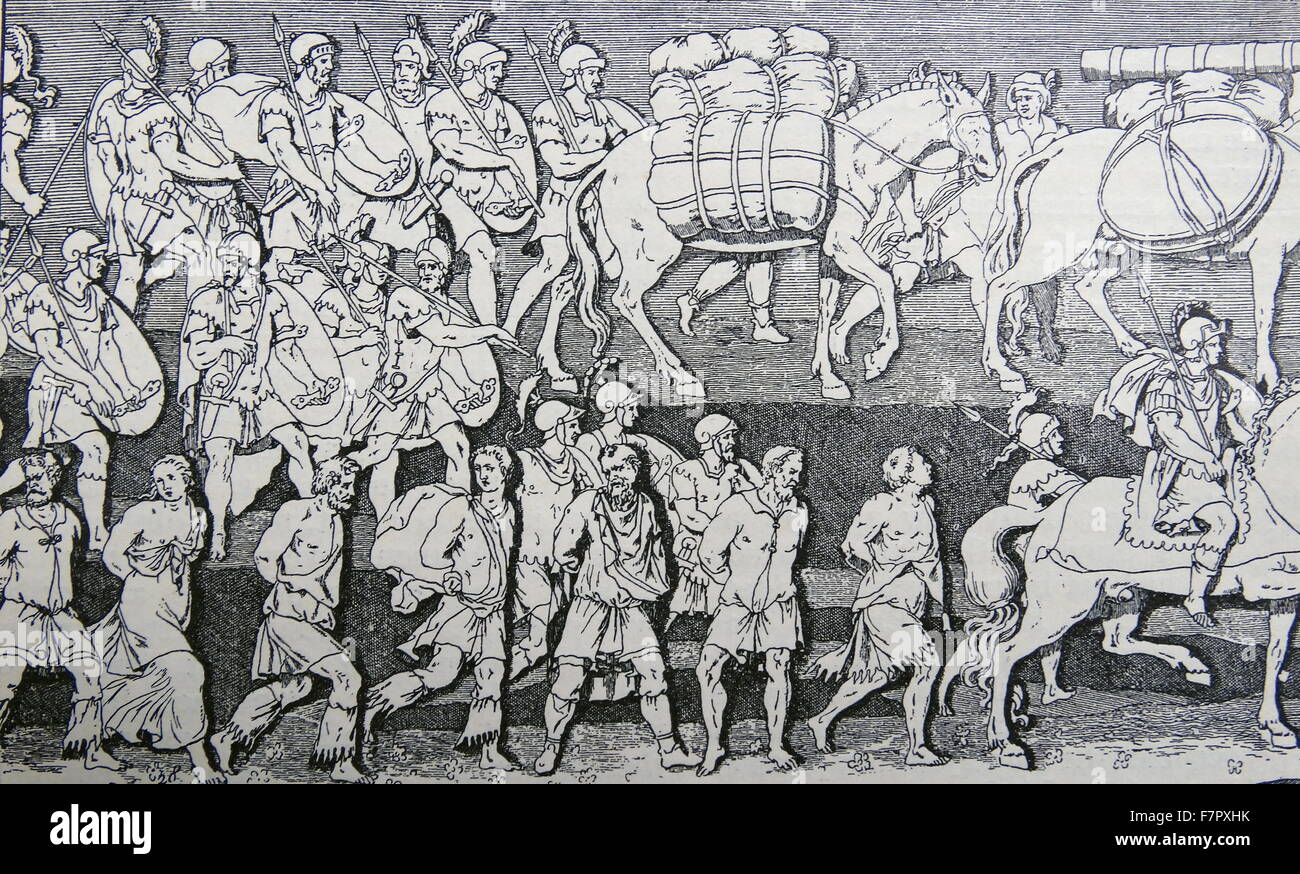 Goth prisoners in a triumphal procession of Emperor Theodosius. Theodosius I (Latin: Flavius Theodosius Augustus;( 347 – 395), also known as Theodosius the Great, was Roman Emperor from AD 379 to AD 395. Theodosius was the last emperor to rule over both the eastern and the western halves of the Roman Empire. On accepting his elevation, he campaigned against Goths and other barbarians who had invaded the Empire;he failed to kill, expel, or entirely subjugate them, and after the Gothic War they established a homeland south of the Danube, in Illyricum, within the empire's borders. Stock Photohttps://www.alamy.com/image-license-details/?v=1https://www.alamy.com/stock-photo-goth-prisoners-in-a-triumphal-procession-of-emperor-theodosius-theodosius-90858255.html
Goth prisoners in a triumphal procession of Emperor Theodosius. Theodosius I (Latin: Flavius Theodosius Augustus;( 347 – 395), also known as Theodosius the Great, was Roman Emperor from AD 379 to AD 395. Theodosius was the last emperor to rule over both the eastern and the western halves of the Roman Empire. On accepting his elevation, he campaigned against Goths and other barbarians who had invaded the Empire;he failed to kill, expel, or entirely subjugate them, and after the Gothic War they established a homeland south of the Danube, in Illyricum, within the empire's borders. Stock Photohttps://www.alamy.com/image-license-details/?v=1https://www.alamy.com/stock-photo-goth-prisoners-in-a-triumphal-procession-of-emperor-theodosius-theodosius-90858255.htmlRMF7PXHK–Goth prisoners in a triumphal procession of Emperor Theodosius. Theodosius I (Latin: Flavius Theodosius Augustus;( 347 – 395), also known as Theodosius the Great, was Roman Emperor from AD 379 to AD 395. Theodosius was the last emperor to rule over both the eastern and the western halves of the Roman Empire. On accepting his elevation, he campaigned against Goths and other barbarians who had invaded the Empire;he failed to kill, expel, or entirely subjugate them, and after the Gothic War they established a homeland south of the Danube, in Illyricum, within the empire's borders.
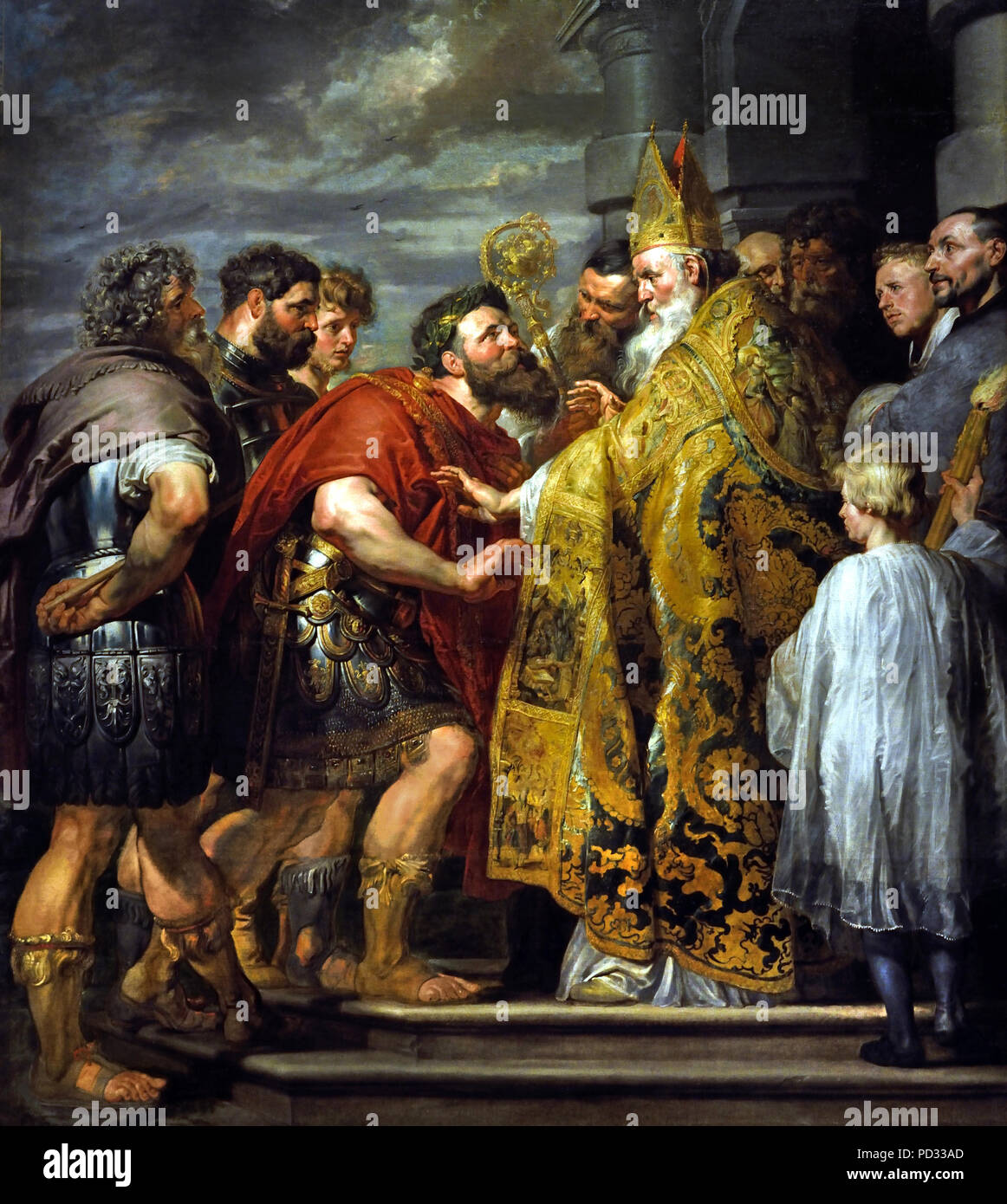 St Ambrose and Emperor Theodosius by Peter Paul Rubens (1577–1640) Flemish Belgian Belgium ( It shows the Roman emperor Theodosius I and his entourage being barred from Milan Cathedral by its archbishop saint Ambrose, as punishment for the Massacre of Thessalonica. ) Stock Photohttps://www.alamy.com/image-license-details/?v=1https://www.alamy.com/st-ambrose-and-emperor-theodosius-by-peter-paul-rubens-15771640-flemish-belgian-belgium-it-shows-the-roman-emperor-theodosius-i-and-his-entourage-being-barred-from-milan-cathedral-by-its-archbishop-saint-ambrose-as-punishment-for-the-massacre-of-thessalonica-image214583445.html
St Ambrose and Emperor Theodosius by Peter Paul Rubens (1577–1640) Flemish Belgian Belgium ( It shows the Roman emperor Theodosius I and his entourage being barred from Milan Cathedral by its archbishop saint Ambrose, as punishment for the Massacre of Thessalonica. ) Stock Photohttps://www.alamy.com/image-license-details/?v=1https://www.alamy.com/st-ambrose-and-emperor-theodosius-by-peter-paul-rubens-15771640-flemish-belgian-belgium-it-shows-the-roman-emperor-theodosius-i-and-his-entourage-being-barred-from-milan-cathedral-by-its-archbishop-saint-ambrose-as-punishment-for-the-massacre-of-thessalonica-image214583445.htmlRMPD33AD–St Ambrose and Emperor Theodosius by Peter Paul Rubens (1577–1640) Flemish Belgian Belgium ( It shows the Roman emperor Theodosius I and his entourage being barred from Milan Cathedral by its archbishop saint Ambrose, as punishment for the Massacre of Thessalonica. )
 The base of the obelisk of Thutmose III (re-erected by the Roman emperor Theodosius I) at the Hippodrome, Istanbul, Turkey Stock Photohttps://www.alamy.com/image-license-details/?v=1https://www.alamy.com/the-base-of-the-obelisk-of-thutmose-iii-re-erected-by-the-roman-emperor-theodosius-i-at-the-hippodrome-istanbul-turkey-image341719934.html
The base of the obelisk of Thutmose III (re-erected by the Roman emperor Theodosius I) at the Hippodrome, Istanbul, Turkey Stock Photohttps://www.alamy.com/image-license-details/?v=1https://www.alamy.com/the-base-of-the-obelisk-of-thutmose-iii-re-erected-by-the-roman-emperor-theodosius-i-at-the-hippodrome-istanbul-turkey-image341719934.htmlRF2ARXK7A–The base of the obelisk of Thutmose III (re-erected by the Roman emperor Theodosius I) at the Hippodrome, Istanbul, Turkey
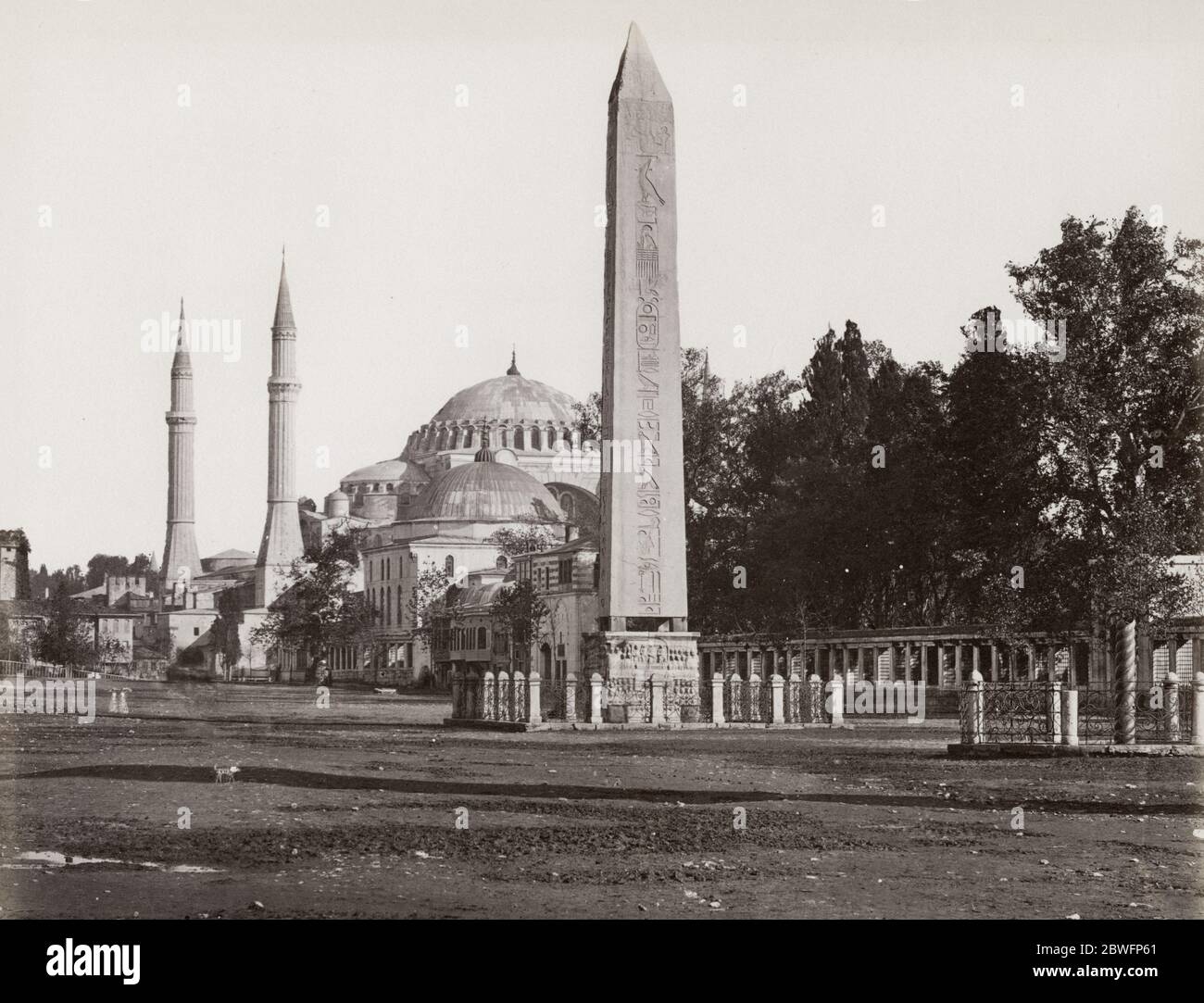 Vintage 19th century photograph - The Obelisk of Theodosius is the Ancient Egyptian obelisk of Pharaoh Thutmose III re-erected in the Hippodrome of Constantinople by the Roman emperor Theodosius I in the 4th century AD. Stock Photohttps://www.alamy.com/image-license-details/?v=1https://www.alamy.com/vintage-19th-century-photograph-the-obelisk-of-theodosius-is-the-ancient-egyptian-obelisk-of-pharaoh-thutmose-iii-re-erected-in-the-hippodrome-of-constantinople-by-the-roman-emperor-theodosius-i-in-the-4th-century-ad-image359920457.html
Vintage 19th century photograph - The Obelisk of Theodosius is the Ancient Egyptian obelisk of Pharaoh Thutmose III re-erected in the Hippodrome of Constantinople by the Roman emperor Theodosius I in the 4th century AD. Stock Photohttps://www.alamy.com/image-license-details/?v=1https://www.alamy.com/vintage-19th-century-photograph-the-obelisk-of-theodosius-is-the-ancient-egyptian-obelisk-of-pharaoh-thutmose-iii-re-erected-in-the-hippodrome-of-constantinople-by-the-roman-emperor-theodosius-i-in-the-4th-century-ad-image359920457.htmlRM2BWFP61–Vintage 19th century photograph - The Obelisk of Theodosius is the Ancient Egyptian obelisk of Pharaoh Thutmose III re-erected in the Hippodrome of Constantinople by the Roman emperor Theodosius I in the 4th century AD.
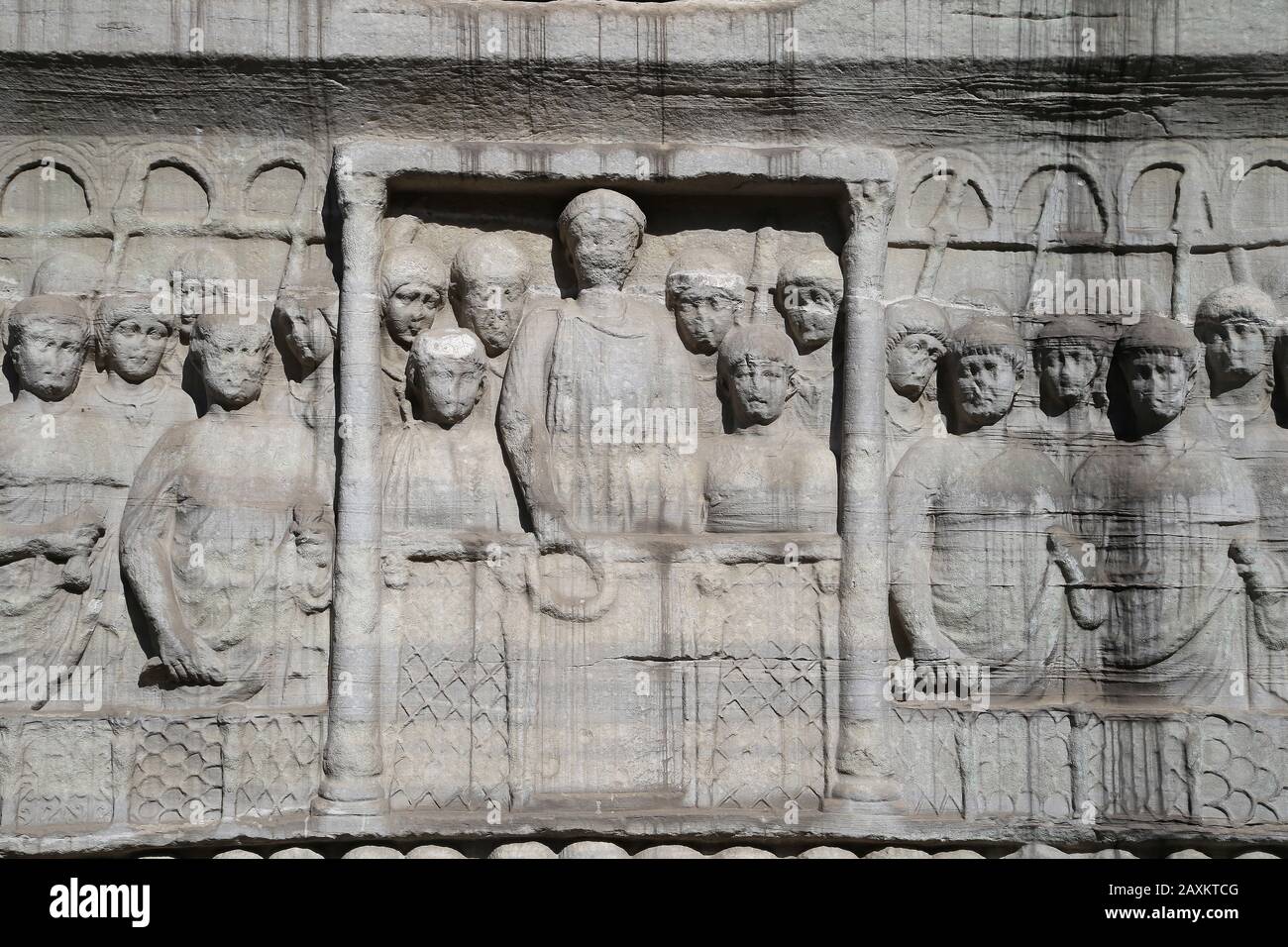 Turkey. Istanbul. Theodosius Obelisk. Pedestal. Emperor offering laurel of victory. 4th c. Hippodrome. Stock Photohttps://www.alamy.com/image-license-details/?v=1https://www.alamy.com/turkey-istanbul-theodosius-obelisk-pedestal-emperor-offering-laurel-of-victory-4th-c-hippodrome-image343414304.html
Turkey. Istanbul. Theodosius Obelisk. Pedestal. Emperor offering laurel of victory. 4th c. Hippodrome. Stock Photohttps://www.alamy.com/image-license-details/?v=1https://www.alamy.com/turkey-istanbul-theodosius-obelisk-pedestal-emperor-offering-laurel-of-victory-4th-c-hippodrome-image343414304.htmlRM2AXKTCG–Turkey. Istanbul. Theodosius Obelisk. Pedestal. Emperor offering laurel of victory. 4th c. Hippodrome.
 Arcadius (377-408) was the eldest son of Emperor Theodosius I, born in Hispania. He was declared co-ruler of the East in 383. When his father died in 395, Arcadius became emperor of the East, co-ruling the Roman Empire with his brother Honorius in the West. Stock Photohttps://www.alamy.com/image-license-details/?v=1https://www.alamy.com/arcadius-377-408-was-the-eldest-son-of-emperor-theodosius-i-born-in-hispania-he-was-declared-co-ruler-of-the-east-in-383-when-his-father-died-in-395-arcadius-became-emperor-of-the-east-co-ruling-the-roman-empire-with-his-brother-honorius-in-the-west-image344282215.html
Arcadius (377-408) was the eldest son of Emperor Theodosius I, born in Hispania. He was declared co-ruler of the East in 383. When his father died in 395, Arcadius became emperor of the East, co-ruling the Roman Empire with his brother Honorius in the West. Stock Photohttps://www.alamy.com/image-license-details/?v=1https://www.alamy.com/arcadius-377-408-was-the-eldest-son-of-emperor-theodosius-i-born-in-hispania-he-was-declared-co-ruler-of-the-east-in-383-when-his-father-died-in-395-arcadius-became-emperor-of-the-east-co-ruling-the-roman-empire-with-his-brother-honorius-in-the-west-image344282215.htmlRM2B03BDB–Arcadius (377-408) was the eldest son of Emperor Theodosius I, born in Hispania. He was declared co-ruler of the East in 383. When his father died in 395, Arcadius became emperor of the East, co-ruling the Roman Empire with his brother Honorius in the West.
 Detail of the pedestal of the Egyptian obelisk, Theodosius I offers laurels of victory, Sultan Ahmet meydan, Istanbul, Turkey Stock Photohttps://www.alamy.com/image-license-details/?v=1https://www.alamy.com/stock-photo-detail-of-the-pedestal-of-the-egyptian-obelisk-theodosius-i-offers-52801729.html
Detail of the pedestal of the Egyptian obelisk, Theodosius I offers laurels of victory, Sultan Ahmet meydan, Istanbul, Turkey Stock Photohttps://www.alamy.com/image-license-details/?v=1https://www.alamy.com/stock-photo-detail-of-the-pedestal-of-the-egyptian-obelisk-theodosius-i-offers-52801729.htmlRMD1W941–Detail of the pedestal of the Egyptian obelisk, Theodosius I offers laurels of victory, Sultan Ahmet meydan, Istanbul, Turkey
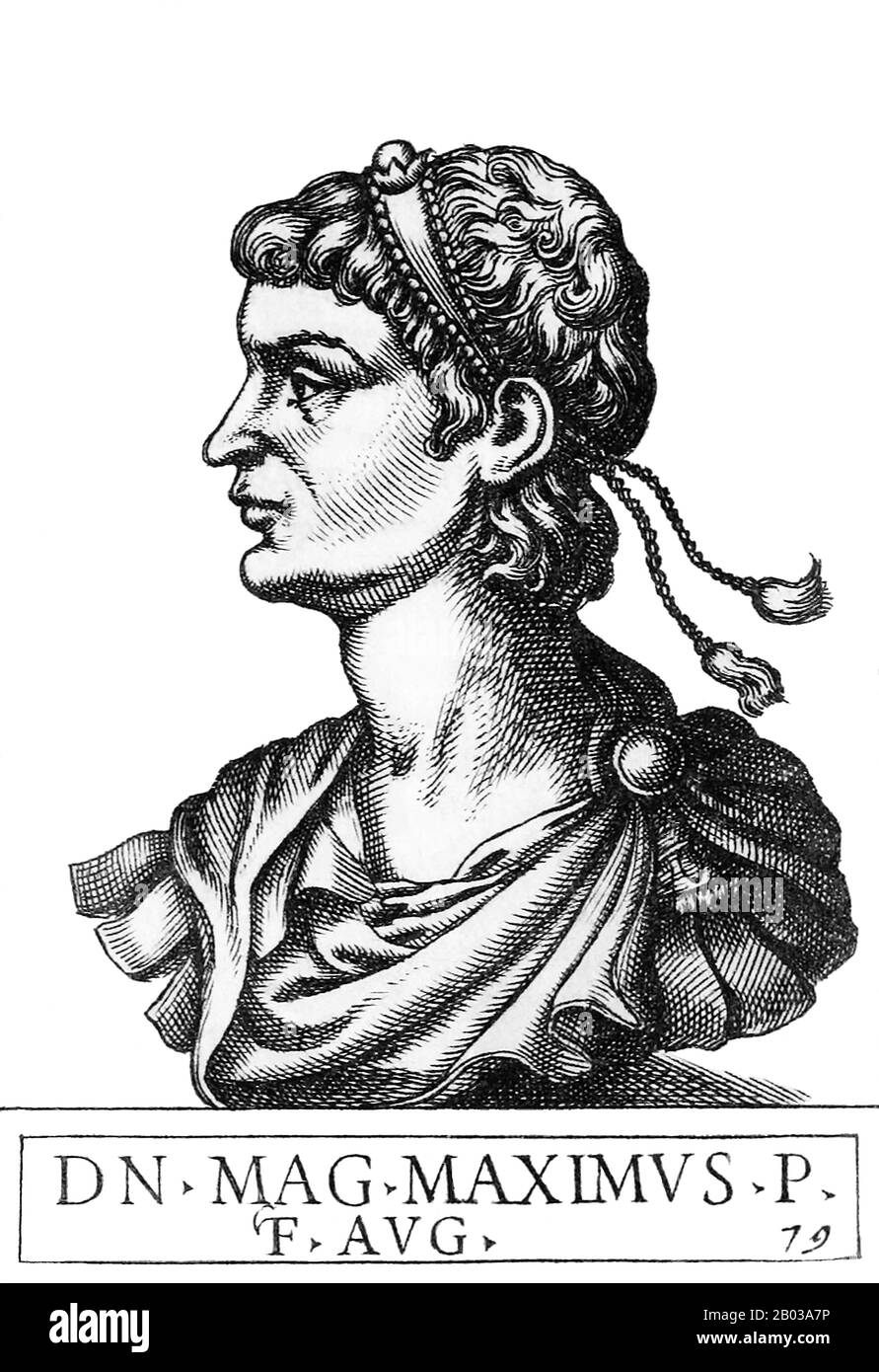 Magnus Maximus (335-388) was born in Gallaecia, and would later become a distinguished general serving under Count Theodosius, father of Emperor Theodosius I, fighting in Africa and on the Danube, as well as during the Great Conspiracy in Britain, where he would later be permanently assigned in 380. When the people became displeased with the western emperor Gratian, his troops proclaimed Maximus emperor, and aided him in his imperial ambitions. Gratian was slain in Lyon, and Maximus later marched into Italy to overthrow Valentinian II. He was only stopped by the intervention of the Eastern R Stock Photohttps://www.alamy.com/image-license-details/?v=1https://www.alamy.com/magnus-maximus-335-388-was-born-in-gallaecia-and-would-later-become-a-distinguished-general-serving-under-count-theodosius-father-of-emperor-theodosius-i-fighting-in-africa-and-on-the-danube-as-well-as-during-the-great-conspiracy-in-britain-where-he-would-later-be-permanently-assigned-in-380-when-the-people-became-displeased-with-the-western-emperor-gratian-his-troops-proclaimed-maximus-emperor-and-aided-him-in-his-imperial-ambitions-gratian-was-slain-in-lyon-and-maximus-later-marched-into-italy-to-overthrow-valentinian-ii-he-was-only-stopped-by-the-intervention-of-the-eastern-r-image344281274.html
Magnus Maximus (335-388) was born in Gallaecia, and would later become a distinguished general serving under Count Theodosius, father of Emperor Theodosius I, fighting in Africa and on the Danube, as well as during the Great Conspiracy in Britain, where he would later be permanently assigned in 380. When the people became displeased with the western emperor Gratian, his troops proclaimed Maximus emperor, and aided him in his imperial ambitions. Gratian was slain in Lyon, and Maximus later marched into Italy to overthrow Valentinian II. He was only stopped by the intervention of the Eastern R Stock Photohttps://www.alamy.com/image-license-details/?v=1https://www.alamy.com/magnus-maximus-335-388-was-born-in-gallaecia-and-would-later-become-a-distinguished-general-serving-under-count-theodosius-father-of-emperor-theodosius-i-fighting-in-africa-and-on-the-danube-as-well-as-during-the-great-conspiracy-in-britain-where-he-would-later-be-permanently-assigned-in-380-when-the-people-became-displeased-with-the-western-emperor-gratian-his-troops-proclaimed-maximus-emperor-and-aided-him-in-his-imperial-ambitions-gratian-was-slain-in-lyon-and-maximus-later-marched-into-italy-to-overthrow-valentinian-ii-he-was-only-stopped-by-the-intervention-of-the-eastern-r-image344281274.htmlRM2B03A7P–Magnus Maximus (335-388) was born in Gallaecia, and would later become a distinguished general serving under Count Theodosius, father of Emperor Theodosius I, fighting in Africa and on the Danube, as well as during the Great Conspiracy in Britain, where he would later be permanently assigned in 380. When the people became displeased with the western emperor Gratian, his troops proclaimed Maximus emperor, and aided him in his imperial ambitions. Gratian was slain in Lyon, and Maximus later marched into Italy to overthrow Valentinian II. He was only stopped by the intervention of the Eastern R
 9 Solidi, Theodosius I, emperor with ensigns, Aquileia, 378 383 AD Bode Museum DSC02732 Stock Photohttps://www.alamy.com/image-license-details/?v=1https://www.alamy.com/9-solidi-theodosius-i-emperor-with-ensigns-aquileia-378-383-ad-bode-image154620957.html
9 Solidi, Theodosius I, emperor with ensigns, Aquileia, 378 383 AD Bode Museum DSC02732 Stock Photohttps://www.alamy.com/image-license-details/?v=1https://www.alamy.com/9-solidi-theodosius-i-emperor-with-ensigns-aquileia-378-383-ad-bode-image154620957.htmlRMJYFGH1–9 Solidi, Theodosius I, emperor with ensigns, Aquileia, 378 383 AD Bode Museum DSC02732
 Honorius (384-423) was the second son of Emperor Theodosius I and younger brother to Eastern Emperor Arcadius. Honorius was made Augustus and co-ruler in 393 CE, aged 9. When his father died two years laters, Honorius was given the Western half of the Roman Empire, while Arcadius ruled the East. Young as he was, Honorius was mainly a figurehead for General Stilicho, who had been appointed his guardian and advisor by Theodosius before his death. Stilicho made Honorius marry his daughter Maria to strengthen their bonds. Honorius' reign, which was weak and chaotic even by the standards of the r Stock Photohttps://www.alamy.com/image-license-details/?v=1https://www.alamy.com/honorius-384-423-was-the-second-son-of-emperor-theodosius-i-and-younger-brother-to-eastern-emperor-arcadius-honorius-was-made-augustus-and-co-ruler-in-393-ce-aged-9-when-his-father-died-two-years-laters-honorius-was-given-the-western-half-of-the-roman-empire-while-arcadius-ruled-the-east-young-as-he-was-honorius-was-mainly-a-figurehead-for-general-stilicho-who-had-been-appointed-his-guardian-and-advisor-by-theodosius-before-his-death-stilicho-made-honorius-marry-his-daughter-maria-to-strengthen-their-bonds-honorius-reign-which-was-weak-and-chaotic-even-by-the-standards-of-the-r-image344279331.html
Honorius (384-423) was the second son of Emperor Theodosius I and younger brother to Eastern Emperor Arcadius. Honorius was made Augustus and co-ruler in 393 CE, aged 9. When his father died two years laters, Honorius was given the Western half of the Roman Empire, while Arcadius ruled the East. Young as he was, Honorius was mainly a figurehead for General Stilicho, who had been appointed his guardian and advisor by Theodosius before his death. Stilicho made Honorius marry his daughter Maria to strengthen their bonds. Honorius' reign, which was weak and chaotic even by the standards of the r Stock Photohttps://www.alamy.com/image-license-details/?v=1https://www.alamy.com/honorius-384-423-was-the-second-son-of-emperor-theodosius-i-and-younger-brother-to-eastern-emperor-arcadius-honorius-was-made-augustus-and-co-ruler-in-393-ce-aged-9-when-his-father-died-two-years-laters-honorius-was-given-the-western-half-of-the-roman-empire-while-arcadius-ruled-the-east-young-as-he-was-honorius-was-mainly-a-figurehead-for-general-stilicho-who-had-been-appointed-his-guardian-and-advisor-by-theodosius-before-his-death-stilicho-made-honorius-marry-his-daughter-maria-to-strengthen-their-bonds-honorius-reign-which-was-weak-and-chaotic-even-by-the-standards-of-the-r-image344279331.htmlRM2B037PB–Honorius (384-423) was the second son of Emperor Theodosius I and younger brother to Eastern Emperor Arcadius. Honorius was made Augustus and co-ruler in 393 CE, aged 9. When his father died two years laters, Honorius was given the Western half of the Roman Empire, while Arcadius ruled the East. Young as he was, Honorius was mainly a figurehead for General Stilicho, who had been appointed his guardian and advisor by Theodosius before his death. Stilicho made Honorius marry his daughter Maria to strengthen their bonds. Honorius' reign, which was weak and chaotic even by the standards of the r
 1716 Theodosius I Erfgoedcentrum Rozet 300 191 d 6 C (92) 20171115 0001 Stock Photohttps://www.alamy.com/image-license-details/?v=1https://www.alamy.com/1716-theodosius-i-erfgoedcentrum-rozet-300-191-d-6-c-92-20171115-0001-image213675706.html
1716 Theodosius I Erfgoedcentrum Rozet 300 191 d 6 C (92) 20171115 0001 Stock Photohttps://www.alamy.com/image-license-details/?v=1https://www.alamy.com/1716-theodosius-i-erfgoedcentrum-rozet-300-191-d-6-c-92-20171115-0001-image213675706.htmlRMPBHNF6–1716 Theodosius I Erfgoedcentrum Rozet 300 191 d 6 C (92) 20171115 0001
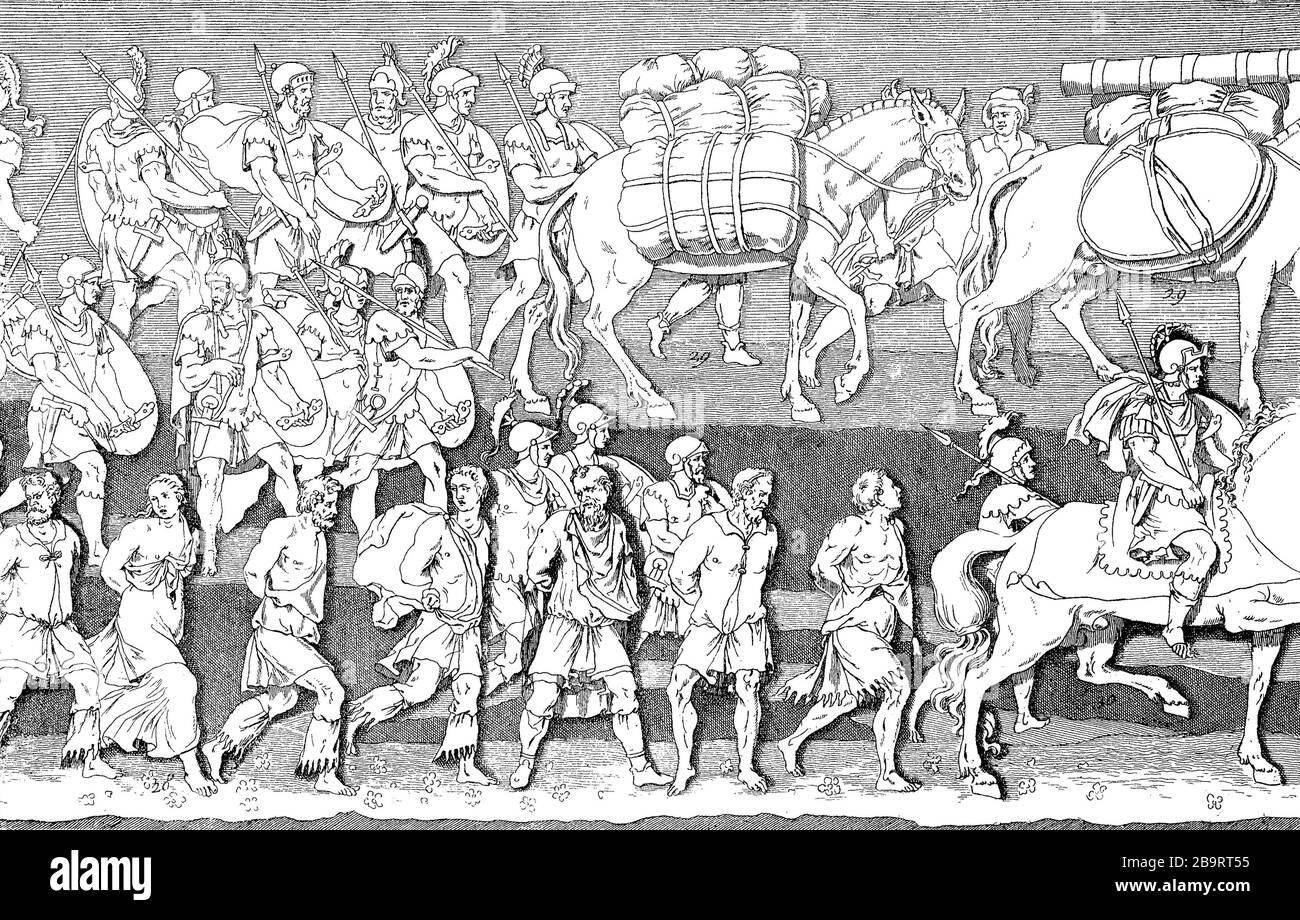 Captured Goths in the triumph of Theodosius. Relief from the Theodosius Column erected by Emperor Arcadius at Constantinople in 401, which was removed in 1695, Theodosius I (11 January 347 - 17 January 395), Theodosius the Great, Theodosius Magnus, was emperor in the east of the Roman Empire from 379 to 394 / Gefangene Goten im Triumpfzug des Theodosius. Relief von der durch Kaiser Arcadius zu Konstantinopel im Jahre 401 errichteten Theodosiussäule, welche 1695 abgetragen wurde, Theodosius I. (11. Januar 347 - 17. Januar 395), Theodosius der Große, Theodosius Magnus, war von 379 bis 394 Kais Stock Photohttps://www.alamy.com/image-license-details/?v=1https://www.alamy.com/captured-goths-in-the-triumph-of-theodosius-relief-from-the-theodosius-column-erected-by-emperor-arcadius-at-constantinople-in-401-which-was-removed-in-1695-theodosius-i-11-january-347-17-january-395-theodosius-the-great-theodosius-magnus-was-emperor-in-the-east-of-the-roman-empire-from-379-to-394-gefangene-goten-im-triumpfzug-des-theodosius-relief-von-der-durch-kaiser-arcadius-zu-konstantinopel-im-jahre-401-errichteten-theodosiussule-welche-1695-abgetragen-wurde-theodosius-i-11-januar-347-17-januar-395-theodosius-der-groe-theodosius-magnus-war-von-379-bis-394-kais-image350263121.html
Captured Goths in the triumph of Theodosius. Relief from the Theodosius Column erected by Emperor Arcadius at Constantinople in 401, which was removed in 1695, Theodosius I (11 January 347 - 17 January 395), Theodosius the Great, Theodosius Magnus, was emperor in the east of the Roman Empire from 379 to 394 / Gefangene Goten im Triumpfzug des Theodosius. Relief von der durch Kaiser Arcadius zu Konstantinopel im Jahre 401 errichteten Theodosiussäule, welche 1695 abgetragen wurde, Theodosius I. (11. Januar 347 - 17. Januar 395), Theodosius der Große, Theodosius Magnus, war von 379 bis 394 Kais Stock Photohttps://www.alamy.com/image-license-details/?v=1https://www.alamy.com/captured-goths-in-the-triumph-of-theodosius-relief-from-the-theodosius-column-erected-by-emperor-arcadius-at-constantinople-in-401-which-was-removed-in-1695-theodosius-i-11-january-347-17-january-395-theodosius-the-great-theodosius-magnus-was-emperor-in-the-east-of-the-roman-empire-from-379-to-394-gefangene-goten-im-triumpfzug-des-theodosius-relief-von-der-durch-kaiser-arcadius-zu-konstantinopel-im-jahre-401-errichteten-theodosiussule-welche-1695-abgetragen-wurde-theodosius-i-11-januar-347-17-januar-395-theodosius-der-groe-theodosius-magnus-war-von-379-bis-394-kais-image350263121.htmlRF2B9RT55–Captured Goths in the triumph of Theodosius. Relief from the Theodosius Column erected by Emperor Arcadius at Constantinople in 401, which was removed in 1695, Theodosius I (11 January 347 - 17 January 395), Theodosius the Great, Theodosius Magnus, was emperor in the east of the Roman Empire from 379 to 394 / Gefangene Goten im Triumpfzug des Theodosius. Relief von der durch Kaiser Arcadius zu Konstantinopel im Jahre 401 errichteten Theodosiussäule, welche 1695 abgetragen wurde, Theodosius I. (11. Januar 347 - 17. Januar 395), Theodosius der Große, Theodosius Magnus, war von 379 bis 394 Kais
 Theodosius I, also called Theodosius the Great, was a Roman emperor 379-395 ad. Solid (solidus) coin, gold. Diademed bust with robe and cuirass Stock Photohttps://www.alamy.com/image-license-details/?v=1https://www.alamy.com/theodosius-i-also-called-theodosius-the-great-was-a-roman-emperor-379-395-ad-solid-solidus-coin-gold-diademed-bust-with-robe-and-cuirass-image612012799.html
Theodosius I, also called Theodosius the Great, was a Roman emperor 379-395 ad. Solid (solidus) coin, gold. Diademed bust with robe and cuirass Stock Photohttps://www.alamy.com/image-license-details/?v=1https://www.alamy.com/theodosius-i-also-called-theodosius-the-great-was-a-roman-emperor-379-395-ad-solid-solidus-coin-gold-diademed-bust-with-robe-and-cuirass-image612012799.htmlRF2XFKGFY–Theodosius I, also called Theodosius the Great, was a Roman emperor 379-395 ad. Solid (solidus) coin, gold. Diademed bust with robe and cuirass
 Honorius (384-423) was the second son of Emperor Theodosius I and younger brother to Eastern Emperor Arcadius. Honorius was made Augustus and co-ruler in 393 CE, aged 9. When his father died two years laters, Honorius was given the Western half of the Roman Empire, while Arcadius ruled the East. Young as he was, Honorius was mainly a figurehead for General Stilicho, who had been appointed his guardian and advisor by Theodosius before his death. Stilicho made Honorius marry his daughter Maria to strengthen their bonds. Honorius' reign, which was weak and chaotic even by the standards of the r Stock Photohttps://www.alamy.com/image-license-details/?v=1https://www.alamy.com/honorius-384-423-was-the-second-son-of-emperor-theodosius-i-and-younger-brother-to-eastern-emperor-arcadius-honorius-was-made-augustus-and-co-ruler-in-393-ce-aged-9-when-his-father-died-two-years-laters-honorius-was-given-the-western-half-of-the-roman-empire-while-arcadius-ruled-the-east-young-as-he-was-honorius-was-mainly-a-figurehead-for-general-stilicho-who-had-been-appointed-his-guardian-and-advisor-by-theodosius-before-his-death-stilicho-made-honorius-marry-his-daughter-maria-to-strengthen-their-bonds-honorius-reign-which-was-weak-and-chaotic-even-by-the-standards-of-the-r-image344279482.html
Honorius (384-423) was the second son of Emperor Theodosius I and younger brother to Eastern Emperor Arcadius. Honorius was made Augustus and co-ruler in 393 CE, aged 9. When his father died two years laters, Honorius was given the Western half of the Roman Empire, while Arcadius ruled the East. Young as he was, Honorius was mainly a figurehead for General Stilicho, who had been appointed his guardian and advisor by Theodosius before his death. Stilicho made Honorius marry his daughter Maria to strengthen their bonds. Honorius' reign, which was weak and chaotic even by the standards of the r Stock Photohttps://www.alamy.com/image-license-details/?v=1https://www.alamy.com/honorius-384-423-was-the-second-son-of-emperor-theodosius-i-and-younger-brother-to-eastern-emperor-arcadius-honorius-was-made-augustus-and-co-ruler-in-393-ce-aged-9-when-his-father-died-two-years-laters-honorius-was-given-the-western-half-of-the-roman-empire-while-arcadius-ruled-the-east-young-as-he-was-honorius-was-mainly-a-figurehead-for-general-stilicho-who-had-been-appointed-his-guardian-and-advisor-by-theodosius-before-his-death-stilicho-made-honorius-marry-his-daughter-maria-to-strengthen-their-bonds-honorius-reign-which-was-weak-and-chaotic-even-by-the-standards-of-the-r-image344279482.htmlRM2B037YP–Honorius (384-423) was the second son of Emperor Theodosius I and younger brother to Eastern Emperor Arcadius. Honorius was made Augustus and co-ruler in 393 CE, aged 9. When his father died two years laters, Honorius was given the Western half of the Roman Empire, while Arcadius ruled the East. Young as he was, Honorius was mainly a figurehead for General Stilicho, who had been appointed his guardian and advisor by Theodosius before his death. Stilicho made Honorius marry his daughter Maria to strengthen their bonds. Honorius' reign, which was weak and chaotic even by the standards of the r
 24/10/2024. Istanbul, Turkey. The Hippodrome. Right: The Walled Obelisk or Masonry Obelisk (Turkish: Örme Dikilitaş) is a Roman monument in the form of an obelisk in the former Hippodrome of Constantinople, now Sultanahmet Square. Left: Obelisk of Theodosius The Obelisk is the Ancient Egyptian obelisk of Pharaoh Thutmose III (1479–1425 BC), first erected during the 18th dynasty of Egypt. It was re-erected in the Hippodrome of Constantinople (known today as At Meydanı or Sultanahmet Meydanı, in the modern city of Istanbul, Turkey) by the Roman emperor Theodosius I in the 4th century AD. Photo Stock Photohttps://www.alamy.com/image-license-details/?v=1https://www.alamy.com/24102024-istanbul-turkey-the-hippodrome-right-the-walled-obelisk-or-masonry-obelisk-turkish-rme-dikilita-is-a-roman-monument-in-the-form-of-an-obelisk-in-the-former-hippodrome-of-constantinople-now-sultanahmet-square-left-obelisk-of-theodosius-the-obelisk-is-the-ancient-egyptian-obelisk-of-pharaoh-thutmose-iii-14791425-bc-first-erected-during-the-18th-dynasty-of-egypt-it-was-re-erected-in-the-hippodrome-of-constantinople-known-today-as-at-meydan-or-sultanahmet-meydan-in-the-modern-city-of-istanbul-turkey-by-the-roman-emperor-theodosius-i-in-the-4th-century-ad-photo-image630567206.html
24/10/2024. Istanbul, Turkey. The Hippodrome. Right: The Walled Obelisk or Masonry Obelisk (Turkish: Örme Dikilitaş) is a Roman monument in the form of an obelisk in the former Hippodrome of Constantinople, now Sultanahmet Square. Left: Obelisk of Theodosius The Obelisk is the Ancient Egyptian obelisk of Pharaoh Thutmose III (1479–1425 BC), first erected during the 18th dynasty of Egypt. It was re-erected in the Hippodrome of Constantinople (known today as At Meydanı or Sultanahmet Meydanı, in the modern city of Istanbul, Turkey) by the Roman emperor Theodosius I in the 4th century AD. Photo Stock Photohttps://www.alamy.com/image-license-details/?v=1https://www.alamy.com/24102024-istanbul-turkey-the-hippodrome-right-the-walled-obelisk-or-masonry-obelisk-turkish-rme-dikilita-is-a-roman-monument-in-the-form-of-an-obelisk-in-the-former-hippodrome-of-constantinople-now-sultanahmet-square-left-obelisk-of-theodosius-the-obelisk-is-the-ancient-egyptian-obelisk-of-pharaoh-thutmose-iii-14791425-bc-first-erected-during-the-18th-dynasty-of-egypt-it-was-re-erected-in-the-hippodrome-of-constantinople-known-today-as-at-meydan-or-sultanahmet-meydan-in-the-modern-city-of-istanbul-turkey-by-the-roman-emperor-theodosius-i-in-the-4th-century-ad-photo-image630567206.htmlRM2YHTPWA–24/10/2024. Istanbul, Turkey. The Hippodrome. Right: The Walled Obelisk or Masonry Obelisk (Turkish: Örme Dikilitaş) is a Roman monument in the form of an obelisk in the former Hippodrome of Constantinople, now Sultanahmet Square. Left: Obelisk of Theodosius The Obelisk is the Ancient Egyptian obelisk of Pharaoh Thutmose III (1479–1425 BC), first erected during the 18th dynasty of Egypt. It was re-erected in the Hippodrome of Constantinople (known today as At Meydanı or Sultanahmet Meydanı, in the modern city of Istanbul, Turkey) by the Roman emperor Theodosius I in the 4th century AD. Photo
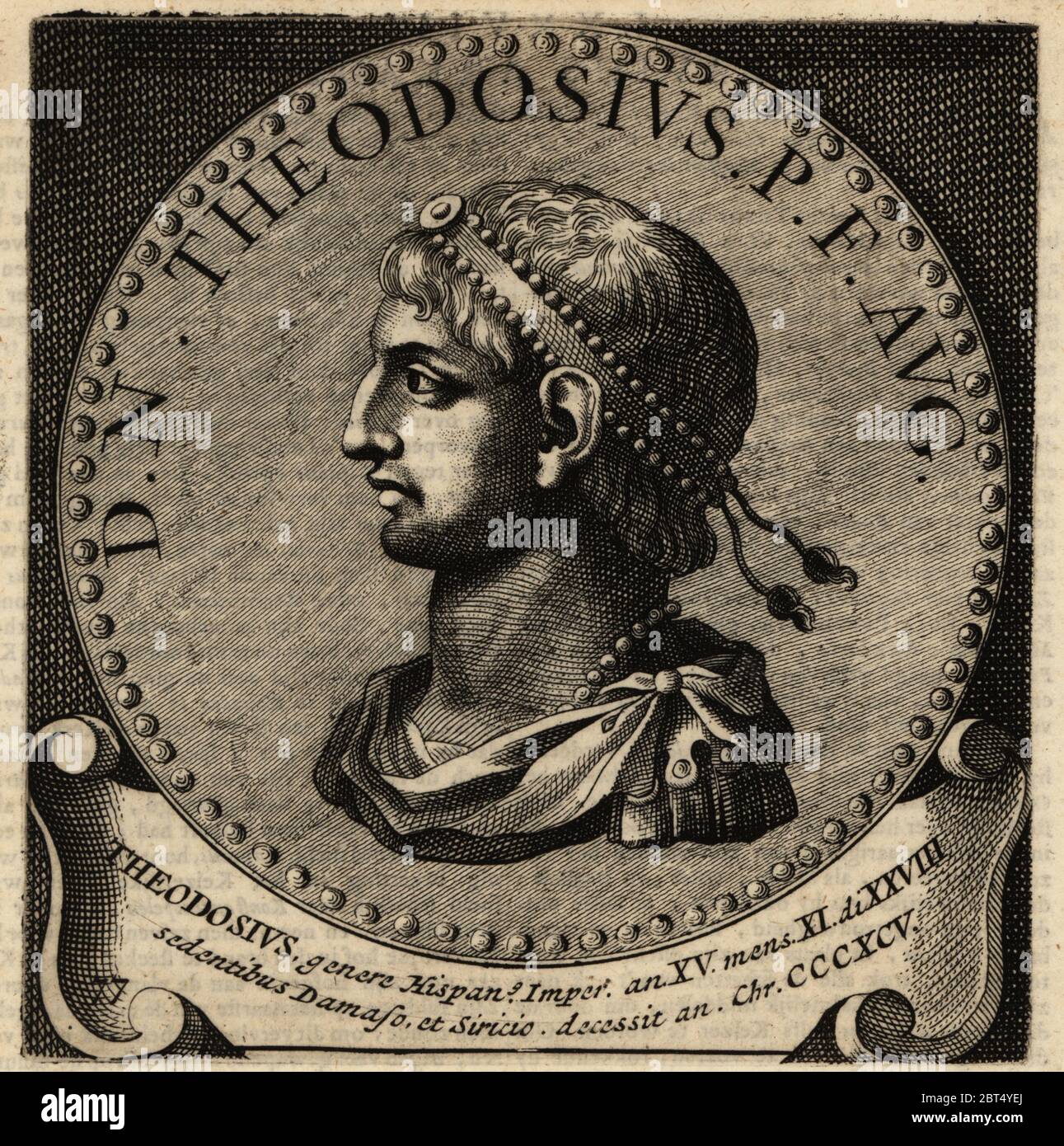 Roman Emperor Theodosius I, 347-395. Flavius Theodosius Augustus or Theodosius the Great, Byzantine Emperor. Copperplate engraving from Abraham Bogaerts De Roomsche Monarchy, The Roman Monarchy, Francois Salma, Utrecht, 1697. Stock Photohttps://www.alamy.com/image-license-details/?v=1https://www.alamy.com/roman-emperor-theodosius-i-347-395-flavius-theodosius-augustus-or-theodosius-the-great-byzantine-emperor-copperplate-engraving-from-abraham-bogaerts-de-roomsche-monarchy-the-roman-monarchy-francois-salma-utrecht-1697-image359068490.html
Roman Emperor Theodosius I, 347-395. Flavius Theodosius Augustus or Theodosius the Great, Byzantine Emperor. Copperplate engraving from Abraham Bogaerts De Roomsche Monarchy, The Roman Monarchy, Francois Salma, Utrecht, 1697. Stock Photohttps://www.alamy.com/image-license-details/?v=1https://www.alamy.com/roman-emperor-theodosius-i-347-395-flavius-theodosius-augustus-or-theodosius-the-great-byzantine-emperor-copperplate-engraving-from-abraham-bogaerts-de-roomsche-monarchy-the-roman-monarchy-francois-salma-utrecht-1697-image359068490.htmlRM2BT4YEJ–Roman Emperor Theodosius I, 347-395. Flavius Theodosius Augustus or Theodosius the Great, Byzantine Emperor. Copperplate engraving from Abraham Bogaerts De Roomsche Monarchy, The Roman Monarchy, Francois Salma, Utrecht, 1697.
 Alaric I (c370-410), king of Visigoths from 495, entering Athens 395. Leader of gothic auxiliaries of Theodosius I, Emperor of the East. c.1920. Illustration, Colour Stock Photohttps://www.alamy.com/image-license-details/?v=1https://www.alamy.com/alaric-i-c370-410-king-of-visigoths-from-495-entering-athens-395-leader-of-gothic-auxiliaries-of-theodosius-i-emperor-of-the-east-c1920-illustration-colour-image257294716.html
Alaric I (c370-410), king of Visigoths from 495, entering Athens 395. Leader of gothic auxiliaries of Theodosius I, Emperor of the East. c.1920. Illustration, Colour Stock Photohttps://www.alamy.com/image-license-details/?v=1https://www.alamy.com/alaric-i-c370-410-king-of-visigoths-from-495-entering-athens-395-leader-of-gothic-auxiliaries-of-theodosius-i-emperor-of-the-east-c1920-illustration-colour-image257294716.htmlRMTXGP10–Alaric I (c370-410), king of Visigoths from 495, entering Athens 395. Leader of gothic auxiliaries of Theodosius I, Emperor of the East. c.1920. Illustration, Colour